South Africa Overland Expedition
.
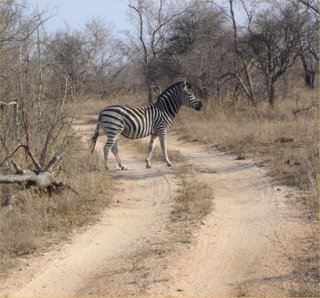

Our Entire Photo Album
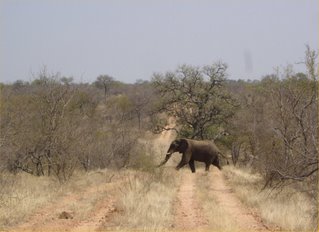
Prologue:
The anticipation of our South African adventure was somewhat sullied by the length of the air travel there and back. Actually the journey to South Africa was not so bad as it was spread over two days with a hotel layover in Washington, DC. It was the return trip that was daunting – three flights over a 36-hour period.
Packing was easy – t-shirts, jeans and shorts being the backbone of our wardrobe. We packed an extra collapsible duffle bag full of t-shirts and school supplies (pens, pencils, erasers, calculators, etc.) that we’d collected with the help of caring friends. These items, so we’d heard, were welcomed in poor villages. And then there was the extra bonus of my having to fill it to take home – that’ll be no problem.
October 21, 2006 – Saturday
We’ve never traveled ‘United’ and been satisfied and this flight didn’t change our opinion – if rating airlines on a one to five star basis, I’d find it very difficult to give them more than half a star. The first leg of our journey was ‘United’ – Vancouver to Washington, DC, a five hour flight.
My first aggravation was several weeks previous when I phoned to get seat assignments. South Africa Airlines assigned seats for all our flights, international and domestic and I was so thrilled when I found out that the configurations was to be 2-4-2 and we’d have window and aisle on the 18 1/2-hour flights Washington to Johannesburg and return. United was a different story.
“Sorry Ma’am” the agent drawled “the seats will be assigned at the airport on the day of the flight”
“However, if you call again in a week, perhaps they (who are they?) will have released some seats.” She continued.
I phoned again a week later and after maneuvering through the many tiers of automated menus and finally reaching a person, I received exactly the same response, verbatim. So I kept trying – one week prior, four days ahead, the day before.
“Well Ma’am, I guess you’d just better get to the airport 2 ½ to 3 hours before the flight.” We did better than that and arrived 3 ½ hours early. It didn’t help though; the only two seats they had together were in the last row in a 3-3 Airbus configuration – window and centre. In retrospect, we should have split up and taken two aisle seats because the seats in the back row don’t recline – the backs are perpendicular. Neither Fernie nor I are long-legged but our knees wedged against the seats in front unless we pushed our derrieres tightly back into the seat. We kept our fingers crossed that the people in front of us didn’t recline – but of course they did. We were then captive – couldn’t pick up anything from the floor without extreme contortions. That’s when I discovered that my seat was broken and the cushion separated from the frame and slid forward. The good news was (and we were desperate for good news) the pilot announced that they’d be improving on the time and be arriving early – 4 ¾ hours instead of 5.
But it was an extremely uncomfortable flight. The heat seemed to pool in our corner especially when half the planeload lined up for the restrooms. It was stifling. We passed the time watching “The Devil Wears Prada” on a tiny screen three rows ahead of us. Amusing bit of fluff – our eleven-year-old granddaughter saw it several months ago and highly recommended it to us so it wasn’t exactly sophisticated entertainment – but we were desperate to get our minds off our discomfort. The standout, Meryl Streep portrayed a parody of a cold and demanding businesswoman in the fashion industry. She played the role fairly subtly and never went over the top. A second film, Prairie Home Companion was a strange one – only watched a bit of it but was amazed again by Meryl Streep – as a country singer of bygone days in the tradition of those old time singers like Loretta Lynn or maybe June Carter (I’m not a connoisseur of country music). She and Lily Tomlin played singing sisters from Minnesota – loved their accents – and Meryl’s singing voice is amazing.
I almost cheered when the plane descended and it’s landing gear engaged. Hope tomorrow’s flight is better. A night at an airport hotel with no restaurant for two miles meant dinner was an order-in pizza – which left me with my usual dyspepsia.
October 22 and 23, 2006 - Sunday and Monday
Before boarding for a 1pm departure, we walked steadily up and down the airport for over an hour until our legs were dead tired. We then donned our new ‘compression socks’ (I’ve read enough scary stories about blood clots and quick deaths on long flights), stocked up on bottled water and mentally prepared for the 17 hour flight to Johannesburg. What a difference in airplanes – and the service was superb on South Africa Airlines. We had our window and aisle seats on the side, interactive video in every seat back with a vast variety of films, TV, games, etc. Fernie played poker almost all the way. There was a neat little videocam mounted on the tail of the plane – we watched as it taxied and took off – quite thrilling from that perspective (I’m quite childlike in my delights).
I was a bit worried when we first tried out the entertainment module because we couldn’t access any films but with several ‘reboots’ they got it operational and I proceeded to watch three consecutive movies while I sipped on some fine South African Cabernet/Merlot with a chaser of mineral water. So the first seven-hour leg to Dakar, Senegal went pretty smoothly. It was midnight when we arrived so I was disappointed that there was no view of the city from the porthole. Refueling took about an hour and a quarter but we were held captive on the plane.
The final leg was interminable – I couldn’t sleep because it was still only evening at home and it was too warm on the plane. To top it off, the video system conked out again – luckily for Fernie, poker was still accessible. I watched the map and data screens and exercised along with the little cartoon man – toes up, toes down, circle left, circle right, and so on. I finally got tired a couple of hours before we got to Johannesburg but I just dozed off and the lights came on and breakfast was served. It was 11:30am when we landed – Yikes! Can’t go to bed for at least ten hours. As the plane banked on its final approach, I noticed large rectangular tracts filled with what looked like thousands of orderly mirrors glinting in the sun – they were the corrugated metal roofs of the huts in the townships.
Johannesburg airport can’t keep up to the air traffic. There are new terminal buildings under construction and planes were docked at incomplete buildings. There was no room for our plane so it was parked out in the field and buses transferred us to the terminal. Customs was a breeze – no questions, just stamp/stamp/stamp – Welcome to South Africa!
While waiting for the Drifters’ driver to pick us up, we were accosted by dozens of men wanting to taxi us to our hotel. A bidding war was breaking out just as our driver showed up. The Drifters’ Johannesburg Inn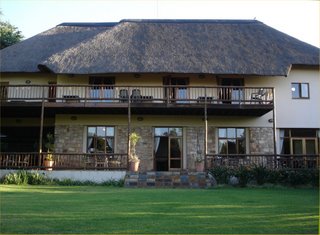 is 45 minutes from the airport – across the other side of the city in the pleasant northwestern suburban of Northcliff. Drifters’ head office is situated in a stately home on the same property as the inn. It was an utterly charming locale – thick and lush with tropical foliage and the air was sweetly scented. The inn was a large thatch-roofed building circled on both levels by spacious verandahs with comfy chairs in the shade. A wide expanse of emerald lawn with chaise lounges led us through a tunnel of greenery to an azure pool. Drifters’ tours both start and finish at the Johannesburg Inn – self-drive tours as well as the overland truck groups such as what we were about to embark on.
is 45 minutes from the airport – across the other side of the city in the pleasant northwestern suburban of Northcliff. Drifters’ head office is situated in a stately home on the same property as the inn. It was an utterly charming locale – thick and lush with tropical foliage and the air was sweetly scented. The inn was a large thatch-roofed building circled on both levels by spacious verandahs with comfy chairs in the shade. A wide expanse of emerald lawn with chaise lounges led us through a tunnel of greenery to an azure pool. Drifters’ tours both start and finish at the Johannesburg Inn – self-drive tours as well as the overland truck groups such as what we were about to embark on.
We were assigned room #16 on the ground level, a small quaint room with two single beds and a picture window overlooking the tropical garden. Our huge shower with open thatched roof above was built of natural stone that sloped to the drain like a forest pool. It felt as if we were under a tropical waterfall. Now about 2pm on Monday and after two continuous days of travel, exhaustion was setting in. Wanting to quickly acclimatize ourselves to the new time zone, we only allowed ourselves a one-hour nap in our cool room.
level, a small quaint room with two single beds and a picture window overlooking the tropical garden. Our huge shower with open thatched roof above was built of natural stone that sloped to the drain like a forest pool. It felt as if we were under a tropical waterfall. Now about 2pm on Monday and after two continuous days of travel, exhaustion was setting in. Wanting to quickly acclimatize ourselves to the new time zone, we only allowed ourselves a one-hour nap in our cool room.
The bar opened at 5pm and we were really thirsty. The bartender recommended that I have ‘the ladies’ beer’, Savanna Dry cider made from Granny Smith apples. That was it! I’m now addicted to the lovely light-amber concoction that only has a hint of apple flavour. http://www.savanna.co.za/. I’m gonna have to ask our BC liquor stores to import it. We sat on the verandah mellowing out with our drinks and watched the sun go down so happy to finally be in South Africa.
At 7pm, half of our group met for dinner in the inn’s dining room before meeting our guide, Dorran Bungay who briefed us about our pending expedition. The usual age of Drifters’ patrons is young – 45 at most but our group was a special for the ‘older folk’ – the suggestion was for ages 40 to 70. That puts us in the ‘way older’ bracket. Our bunch ranged from 42 to 65 – 13 Canadians (BC and Alberta) 2 Germans and 1 Belgian.
A side verandah held a circle of rattan sofas with plump cushions that we settled in for our briefing. Dorran, at 55 definitely the oldest guide, sported longish curly-hair and an untamed wild gray beard. He’d lost his wife a year ago, quit his engineering position and took the job of guide with Drifters. It’s a grueling job – he drives the truck, lectures, guides, shops for groceries, cooks, performs first aid if required and anything else that’s required. His normal day starts at 5am and finishes around 9pm. We were so lucky to get him.
“So, have all of you brought your sleeping bags?” he inquired rhetorically. He was flabbergasted when I gasped “What do you mean? I thought they were to be supplied”. Apparently, if we wanted Drifters to supply the gear, our agent had to put in an order in advance. Our ineffectual agent didn’t even mention the subject and none of the documentation did either. Two of the couples had kits ordered and waiting for them. “That’s never happened before” Dorran muttered. He checked with the Drifters staff for us but there was no gear available. He asked if we would mind buying some if he could find a shop en route the next day. “You’ll need it for twelve out of the seventeen nights” he said. A sense of panic overtook the anger I was feeling at the agent’s negligence but we hoped it would all work out.
October 24, 2006 – Tuesday

A huge green behemoth of a vehicle was ready and waiting for us in the driveway. It had four pairs of reclining seats each side, floor to ceiling windows that opened down halfway, sixteen huge lockers at the rear that easily held our luggage individually, refrigerated compartments to keep our drinks cold – I think we’re going to be mighty comfortable. It was less than six months old and to my eye, it was beautiful. In my idiosyncratic way, I nicknamed it “The Jolly Green Giant”.
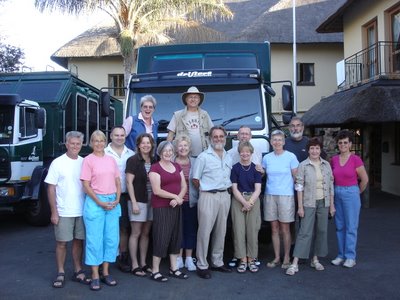
We all grouped together in front of it to have our photo taken before heading off for a long driving day – seventeen strangers soon to become very familiar with each other. The final destination was Drifters’ privately owned 30,000-hectare Balule Game Reserve bordering Kruger National Park on the western perimeter 17 kilometers north of Hoedspruit (pronounced ‘hoodsprate’).
We headed east out of Johannesburg, then north through Pretoria and east through the high veld grasslands. A long stretch of the highway runs through coal mining territory – the coal only inches below the surface.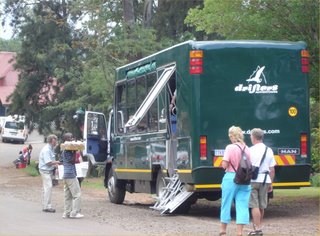 We stopped at the little town of Belfast to shop for sleeping bags, etc. and found some at the hardware shop for only 150 rand each (about $23 Cdn) and no sales taxes – such a pleasant surprise. That was much cheaper than renting – Drifters was charging $18 Cdn a week. We then trotted down the road (not wanting to keep everyone waiting) to a linen shop where we bought pillows, pillow slips and bath towels for about $12 Canadian for the lot – what a deal! The shopkeepers spoke Afrikaans as their first language but switched instantly to flawless English. South Africa has eleven official languages – Afrikaans, English and nine tribal languages (Isindebele, IsiXhosa, IsiZulu, Northern Sotho, Sesotho, Setswana, SiSwati, Tshivenda, Xitsonga) – and no one speaks Swahili.
We stopped at the little town of Belfast to shop for sleeping bags, etc. and found some at the hardware shop for only 150 rand each (about $23 Cdn) and no sales taxes – such a pleasant surprise. That was much cheaper than renting – Drifters was charging $18 Cdn a week. We then trotted down the road (not wanting to keep everyone waiting) to a linen shop where we bought pillows, pillow slips and bath towels for about $12 Canadian for the lot – what a deal! The shopkeepers spoke Afrikaans as their first language but switched instantly to flawless English. South Africa has eleven official languages – Afrikaans, English and nine tribal languages (Isindebele, IsiXhosa, IsiZulu, Northern Sotho, Sesotho, Setswana, SiSwati, Tshivenda, Xitsonga) – and no one speaks Swahili.
 Pilgrims Rest, a historic gold mining town is nestled ,in a valley of the Drakensberg Mountains. This quaint village situated on a hillside provided an interesting array of shops and refurbished buildings to browse and stretch our legs. Dorran chose a ‘pancake’ restaurant for us all to have lunch – pancake in the British style known as crepes in North America. A Thai curry pancake, the crepe wrapped around the filling like an enchilada, with a beautiful robust merlot to wash it down - - - - - oh, but here I go again off on a food ecstasy.
Pilgrims Rest, a historic gold mining town is nestled ,in a valley of the Drakensberg Mountains. This quaint village situated on a hillside provided an interesting array of shops and refurbished buildings to browse and stretch our legs. Dorran chose a ‘pancake’ restaurant for us all to have lunch – pancake in the British style known as crepes in North America. A Thai curry pancake, the crepe wrapped around the filling like an enchilada, with a beautiful robust merlot to wash it down - - - - - oh, but here I go again off on a food ecstasy.
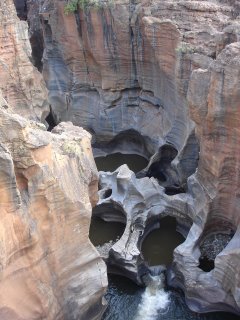
The terrain was changeable as we wound through the Drakensburg Mountains and the elevation plunged to the east and temperatures soared – it got quite tropical, very humid even though they haven’t had rain for a long stretch. Blyde River Canyon with its unique rock formations was our next stop. We dabbled our feet in Bourke's Luck Potholes which were shaped millions of years ago by erosion and just below the wide river narrowed and snaked through the rocky passage. Further along the canyon, the Three Rondavels (it seems that everything round in South Africa is called a ‘rondavel’), a trio of high circular rock formations stood majestically above the deep crevasse of the canyon. The viewpoint was at the edge of a steep high precipice and strangely, at the far end, there was no fence – it looked like a lover’s leap.
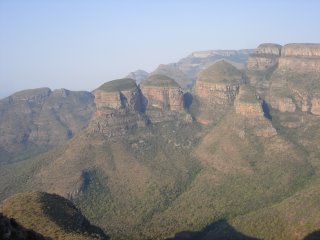
Thirteen hours had elapsed by the time we arrived at Balule Game Reserve and the sun was almost down. As we left the highway, the dirt road was smooth for the first fifteen kilometers and then we turned onto a rough and rocky stretch, which wove through the sparsely treed and arid bushveld. Our truck rocked and rolled precariously but we finally arrived unscathed.
“This is Africa at its wildest” Dorran proclaimed.
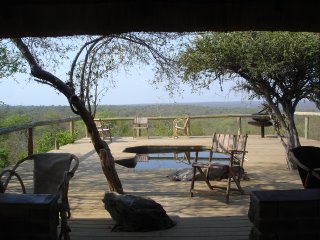 The Balule Drifters Camp was comprised of a thatched roof central compound with a massive deck overlooking the forest and a watering hole about 20 meters below. A small swimming pool was sunk into the centre of the deck and a tree grew through it shading one end. It made for a welcome meeting place. Ten permanently tented huts were spread along the ridge overlooking the waterhole. Thatched roofs covered each one, a wooden screened door set in the canvas, Velcro covers over huge mesh windows and behind the rear flap, a full bathroom. Solar panels created sufficient light for the electrical needs including pumping of water from
The Balule Drifters Camp was comprised of a thatched roof central compound with a massive deck overlooking the forest and a watering hole about 20 meters below. A small swimming pool was sunk into the centre of the deck and a tree grew through it shading one end. It made for a welcome meeting place. Ten permanently tented huts were spread along the ridge overlooking the waterhole. Thatched roofs covered each one, a wooden screened door set in the canvas, Velcro covers over huge mesh windows and behind the rear flap, a full bathroom. Solar panels created sufficient light for the electrical needs including pumping of water from 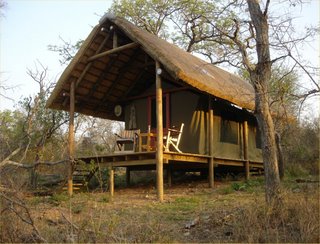 beneath the ground so we could have showers. Two bunks with bare plastic mattresses made us oh so pleased that we’d found sleeping bags. Our unit was right down the end along a couple of hundred meters of trail winding through the bush. Cleverly, I did have the foresight to pack a flashlight or we’d never have found our way after sunset. The darkness was total, not brightened by the lights of civilization.
beneath the ground so we could have showers. Two bunks with bare plastic mattresses made us oh so pleased that we’d found sleeping bags. Our unit was right down the end along a couple of hundred meters of trail winding through the bush. Cleverly, I did have the foresight to pack a flashlight or we’d never have found our way after sunset. The darkness was total, not brightened by the lights of civilization.
Dinner that night was an African barbecue on the deck, known as a ‘braai’ – beef kabobs, lamb chops and some sort of sausage. Not being much of a red meat eater, I just sampled bits of each. Accompanying the dinner was a staple of the South African diet – Pap, about as tasty as it sounds. It’s made from ground white maize (corn) and reconstituted with water – not too palatable to me but it was innocuous. I loaded up on salad. Every Drifters Inn has a bar of sorts – this one just a refrigerator stocked with soft drinks, beer, my favourite Savanna Dry and bottled waters. Also, always on hand, are some decent bottles of wine. I chose a bottle of merlot that would do me for the two nights we’d be there, while Fernie stuck to beer. On re-reading this, it sounds as if I’m a major imbiber……….
Our body clocks not internally adjusted yet, exhaustion set in early (aided by the wine) and we meandered home down the dark trail with our trusty flashlight. The beam picked out some monstrous beetles that scurried off, more afraid of us than we of them and a dead snake which at first appeared to be slithering in the light. I did feel glad we’d worn closed shoes. We realized too that the camp was open to the wilds and a lion, elephant or other frightening creature could at any moment loom out of the darkness. So our adrenaline was running in a thrilling way. I had earlier marked the side trail down to our tent with a large white rock and thank goodness I did because it would be easy to become disoriented. The night was still and now we were away from the group and its chatter, the animal sounds echoed through the air. There was a snuffling and snorting just below us – sounded about ten or twenty feet away; strange calls answered by other unfamiliar sounds lulled us to sleep.
October 25, 2006 – Wednesday
2:00am – Thunk! Something hit the side of the tent. I bounded out of bed but looking out of the windows was useless – total darkness. A rustling in the trees to the side though made me very aware we’d had some sort of visitor. Of course, I couldn’t sleep after that – not because of fear but excitement to be in this locale.
but excitement to be in this locale.
5:00am – A lightening in the eastern sky, so I slid out of my sleeping bag and as I stood stretching in front of one of the giant picture windows, a lone giraffe sauntered by only about six meters away.
“Wake up!” I croaked to Fernie “Giraffe!”
With that, he grabbed his glasses and leapt out of bed. We scurried out to our raised deck in awe of the beautiful creature silhouetted against rosy hues of the dawn sky. It stopped to nibble at branches overhead and seemed unaware of our presence. What an exciting way to start the day.
7:00am – We headed out after coffee and tea on our first game drive.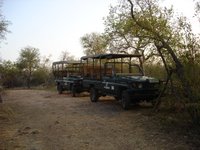 Drifters has two open-sided jeeps that held eight in each. I promised myself that I wouldn’t make comparisons to Kenya with its prolific wildlife but for the first while we didn’t see much. Then all of a sudden there were zebra, impala, kudu, more giraffes, steenbok and a herd of wildebeest (AKA gnus) lurking at a waterhole. The gnus were skittish as we drove in and stopped but then settled down to drink when we stayed still and quiet.
Drifters has two open-sided jeeps that held eight in each. I promised myself that I wouldn’t make comparisons to Kenya with its prolific wildlife but for the first while we didn’t see much. Then all of a sudden there were zebra, impala, kudu, more giraffes, steenbok and a herd of wildebeest (AKA gnus) lurking at a waterhole. The gnus were skittish as we drove in and stopped but then settled down to drink when we stayed still and quiet.
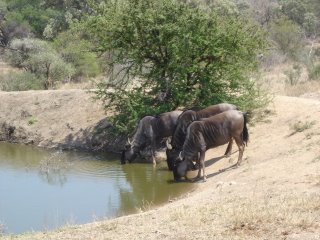
Determined to find elephants, we carried on.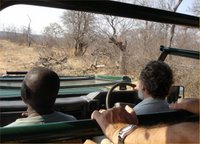 The park is overrun with them and they are the hooligans of the reserves. They’ll tear down a large tree to eat one sprig or to tear off a slice of bark, leaving a graveyard of uprooted and cracked trees in their wake. The overpopulation is causing chaos but herd management is not practiced – initially, that made me happy but the realization is that they are ruining the savanna for other species. We finally glimpsed one off at a distance. We’d been out for 4 ½ hours by this time and our rear ends were beaten black and blue by the 4x4 bouncing up and down and sideways on the bumpy roads so we headed back. As we spied the waterhole in front of our camp, there was a rotund elephant (nicknamed Fats Domino by Fernie) and a lone giraffe (Long Tall Sally) cohabiting at the waterhole – How miraculous!
The park is overrun with them and they are the hooligans of the reserves. They’ll tear down a large tree to eat one sprig or to tear off a slice of bark, leaving a graveyard of uprooted and cracked trees in their wake. The overpopulation is causing chaos but herd management is not practiced – initially, that made me happy but the realization is that they are ruining the savanna for other species. We finally glimpsed one off at a distance. We’d been out for 4 ½ hours by this time and our rear ends were beaten black and blue by the 4x4 bouncing up and down and sideways on the bumpy roads so we headed back. As we spied the waterhole in front of our camp, there was a rotund elephant (nicknamed Fats Domino by Fernie) and a lone giraffe (Long Tall Sally) cohabiting at the waterhole – How miraculous!
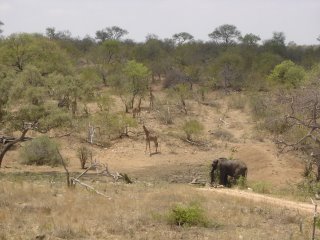
In the outdoor kitchen adjacent to the deck, Dorran cooked up a massive brunch of bacon, ostrich eggs and toast with all of us pitching in to help. I believe only two ostrich eggs fed the lot of us. They were so tasty – they made chicken eggs bland in comparison.
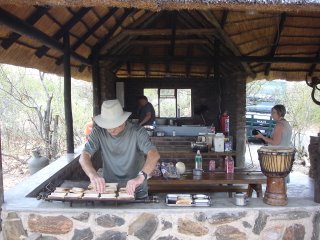
The day became terribly hot and oppressive as it wore on. Humidity was high in spite of the arid conditions and lack of rain.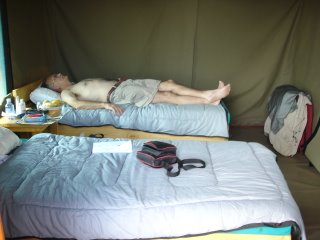 So a siesta was called for and just lazing the day away on our own little deck that was so close to the waterhole and its constant activity. We waited for it to get a bit cooler for Dorran, Isaac and Busie (the two black managers of the camp) to take us out on a bush walk to track game and get familiar with wild Africa. The guides did not carry weapons, so I did wonder what would happen if we encountered a pride of lions but I realized later that they knew the signs to watch out for.
So a siesta was called for and just lazing the day away on our own little deck that was so close to the waterhole and its constant activity. We waited for it to get a bit cooler for Dorran, Isaac and Busie (the two black managers of the camp) to take us out on a bush walk to track game and get familiar with wild Africa. The guides did not carry weapons, so I did wonder what would happen if we encountered a pride of lions but I realized later that they knew the signs to watch out for.
We were instructed to walk single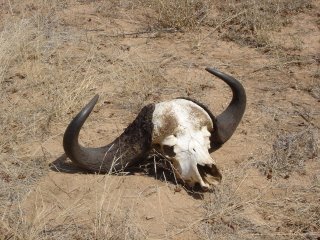 file and on our toes as much as possible to quietly make our way unobserved. Dorran led the parade and Isaac took the rear. We inspected ‘dung’ – yes, that’s right poopies! I personally chose not to handle it. We saw that elephants don’t digest most of the bulk they gorge on for twenty hours a day. It was full of sticks and thorns. We learned to tell how fresh it was. We came across giraffe dung, zebra dung and went through the same inspection process. Finally Dorran and Isaac showed us a game played by Zulus in the bush – using impala dung, which were small round stony pellets.
file and on our toes as much as possible to quietly make our way unobserved. Dorran led the parade and Isaac took the rear. We inspected ‘dung’ – yes, that’s right poopies! I personally chose not to handle it. We saw that elephants don’t digest most of the bulk they gorge on for twenty hours a day. It was full of sticks and thorns. We learned to tell how fresh it was. We came across giraffe dung, zebra dung and went through the same inspection process. Finally Dorran and Isaac showed us a game played by Zulus in the bush – using impala dung, which were small round stony pellets. 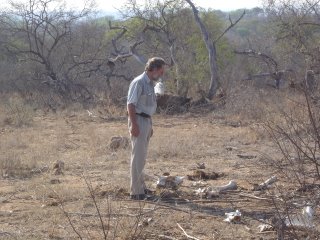 They put a pellet in their mouths (I know – YUCK!) and spit them as far as they could.
They put a pellet in their mouths (I know – YUCK!) and spit them as far as they could.
“Any takers?” he asked with a grin.
I almost fell over when Fernie (a true adventurous spirit) took the challenge and his went further than either of theirs. A couple more tried it (not me – no thank you) and Fernie was still the champ until Dorran tried again.
We inspected and became familiar with the different trees and shrubs and their uses and importance to the scheme of things. One tree (I forget its true name) is known as the ‘toilet paper tree’ by the natives, so we committed that important detail to memory, never knowing when it would become useful. We discussed the geology and looked at stones – I am always on the lookout for something special I can use in lapidary but nothing caught my fancy. I guess we’d strolled and talked and explored for a couple of hours; the sun was about to set so it was time to get back. We were thoroughly content.
 Cocktail time! (you can take the girl out of the city but you can’t take away her ‘happy hour’) For me, the remainder of the red wine, which I had chilled in the fridge – I know, that’s not kosher but it tasted great in the heat. Dinner was curried lamb and rice. Wow, can Dorran cook – it was fabulous. The cleanup was a big job – seventeen of everything plus those giant cast iron pots and skillets but Fernie volunteered to wash and I and a couple of others dried and tidied up. This participatory traveling is so bonding – I never thought I would enjoy it so much.
Cocktail time! (you can take the girl out of the city but you can’t take away her ‘happy hour’) For me, the remainder of the red wine, which I had chilled in the fridge – I know, that’s not kosher but it tasted great in the heat. Dinner was curried lamb and rice. Wow, can Dorran cook – it was fabulous. The cleanup was a big job – seventeen of everything plus those giant cast iron pots and skillets but Fernie volunteered to wash and I and a couple of others dried and tidied up. This participatory traveling is so bonding – I never thought I would enjoy it so much.
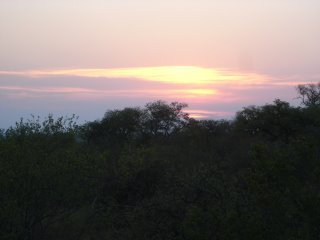
But the day wasn’t over;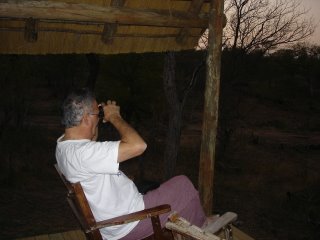 we split up again – eight in each jeep – and headed out on a night bush drive. Bucie up front shone a huge spotlight and swung it side to side and we quietly watched for the glint of eyes in the darkness. I now truly understand the expression ‘deer in the headlights’ because a small herd of impala that would have bounded away in the daylight were totally disoriented and just stood there only twenty feet from us staring into the light. We encountered cape buffalo, giraffe, some small rodents and the best of the lot – a tiny white-headed owl at our eye level right beside the truck. After 2 ½ hours, we were exhausted and on one huge bump, I hit my head on one of the overhead pipes that held the canvas shade – I saw stars!
we split up again – eight in each jeep – and headed out on a night bush drive. Bucie up front shone a huge spotlight and swung it side to side and we quietly watched for the glint of eyes in the darkness. I now truly understand the expression ‘deer in the headlights’ because a small herd of impala that would have bounded away in the daylight were totally disoriented and just stood there only twenty feet from us staring into the light. We encountered cape buffalo, giraffe, some small rodents and the best of the lot – a tiny white-headed owl at our eye level right beside the truck. After 2 ½ hours, we were exhausted and on one huge bump, I hit my head on one of the overhead pipes that held the canvas shade – I saw stars!
Bed was so welcome – I was asleep as soon as my head touched the pillow.
October 26, 2006 – Thursday
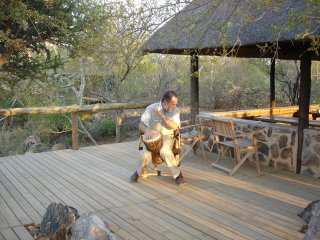 Dorran has a native drum that he beats to summon us to meals and wake us in the morning. But almost all of us were up ahead of the drum this morning. A breakfast of cereal, fruit and toast and we were on our way to Hazyview.
Dorran has a native drum that he beats to summon us to meals and wake us in the morning. But almost all of us were up ahead of the drum this morning. A breakfast of cereal, fruit and toast and we were on our way to Hazyview.
The first stretch of highway 40 south was riddled with entrances to hundreds of other private game reserves bordering Kruger National Park - some of them extremely expensive upscale ones. Further on a bit it was townships as far as the eye could see. Not one white person lives in this area. This polarity between rich and poor is a troubling constant. The roads through the townships are a colourful sight – people walking everywhere. The main mode of transportation is taxi vans, as no one owns a car. The homes vary from very basic little huts to the occasional ‘nice’ home. Outhouses prevail. Wheelbarrows are a proud possession and are used to transport water in large plastic containers. There is almost no water or electricity in these townships and they’ll walk several kilometers to a water station. It was a constant fascination watching the passing scene:
* Women chatting volubly while washing clothes in the creeks
* Entrepreneurial individuals setting up acetylene tanks at roadside to do welding and repairs
* Another selling recycled tires
* A structure made of thick branches covered with a blanket and the scrawled words ‘Car Wash’
* Laughter everywhere
* Smiling faces with glistening white teeth
* Folks dressed in wildly colourful and spotlessly washed clothes waving to us as we whizzed by.
With all this, it’s hard to believe that it would be dangerous to venture in alone on foot. However, with such extreme poverty, some would look at us as a source of income – we affluent travelers. And, I can’t say I actually blame them.
At Hazyview, we were dropped off at an outdoor shopping plaza, Peri Bridge I think it was called, while Dorran zipped up to the supermarket to stock up on groceries. Some went into the Internet café but we chose to sprawl in big comfy chairs under the palms with a beer to quench our thirst – the area is so lush and tropical. I’ve made a concerted resolution to not touch a computer for the entire time in Africa – it’s very freeing. I don’t need to check email; those that want to find me have our itinerary and could track us down if necessary.
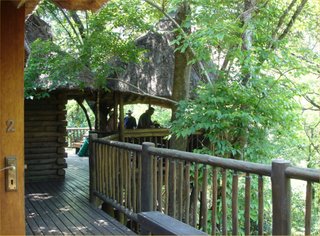 Drifters Inn Hazyview is a beautiful large, thatched log structure deep in jungle, just high enough on a ridge overlooking the rushing Sabie River where hippos and crocodiles live together in harmony. Our rooms exited directly onto a covered deck running the entire length of the building, in the centre of which was a cozy little bar leading in to a high open-beamed great room and massive kitchen.
Drifters Inn Hazyview is a beautiful large, thatched log structure deep in jungle, just high enough on a ridge overlooking the rushing Sabie River where hippos and crocodiles live together in harmony. Our rooms exited directly onto a covered deck running the entire length of the building, in the centre of which was a cozy little bar leading in to a high open-beamed great room and massive kitchen. 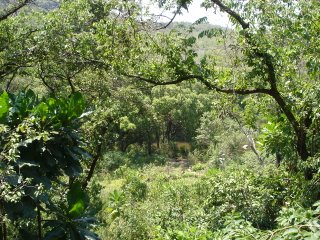 Lemon orchards thrive in this moist environment and the scent perfumed the air. Electric fences circle the entire compound and sadly there was a need to have a rifle-carrying guard at the main gate (animals weren’t the only threat). When we arrived, we were greeted by Nandy, one of two resident ostriches. She immediately took a liking to Fernie and pecked gently at him, at his wedding ring, his watch – shiny things.
Lemon orchards thrive in this moist environment and the scent perfumed the air. Electric fences circle the entire compound and sadly there was a need to have a rifle-carrying guard at the main gate (animals weren’t the only threat). When we arrived, we were greeted by Nandy, one of two resident ostriches. She immediately took a liking to Fernie and pecked gently at him, at his wedding ring, his watch – shiny things.

I spent a couple of hours mostly alone at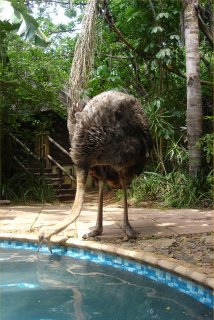 the swimming pool writing – sitting on the edge of the pool with my legs dangling in the water. All of a sudden, Nandy came out of the thick shrubbery from behind me and right beside me stuck her beak in the pool to get a drink. She scared me half to death but it made me giggle to see her gulp, lift her long neck high and a tennis ball lump of water would snake down her throat and then she’d repeat it. The young couple who run the lodge also have a snake house which I was disappointed we couldn’t visit and handle the snakes. They had just eaten (yesterday!) and might regurgitate. I’d never thought of snakes having indigestion before – it humanized them and made me feel more of an affinity. A little daschund, a cat and a loveable and friendly little mongoose freely wandering around completed the menagerie.
the swimming pool writing – sitting on the edge of the pool with my legs dangling in the water. All of a sudden, Nandy came out of the thick shrubbery from behind me and right beside me stuck her beak in the pool to get a drink. She scared me half to death but it made me giggle to see her gulp, lift her long neck high and a tennis ball lump of water would snake down her throat and then she’d repeat it. The young couple who run the lodge also have a snake house which I was disappointed we couldn’t visit and handle the snakes. They had just eaten (yesterday!) and might regurgitate. I’d never thought of snakes having indigestion before – it humanized them and made me feel more of an affinity. A little daschund, a cat and a loveable and friendly little mongoose freely wandering around completed the menagerie.
In the late afternoon when it didn’t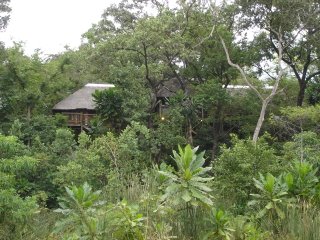 seem any cooler (later on I heard it was 40 degrees C), Dorran took us on a walk down through the jungle to the river to look for hippos and crocs ----- and to perform his threatened and ominous ‘Test’. This word set up immediate angst in most of us. Just standing still, the sweat dribbled like running sap from every pore of my body. I had a cotton scarf
seem any cooler (later on I heard it was 40 degrees C), Dorran took us on a walk down through the jungle to the river to look for hippos and crocs ----- and to perform his threatened and ominous ‘Test’. This word set up immediate angst in most of us. Just standing still, the sweat dribbled like running sap from every pore of my body. I had a cotton scarf  emblazoned with ‘Sturgis Bike Rally 06’ that I soaked in the river and tied around my neck but it ended up Rambo style around my head. It kept the salty sweat out of my eyes. There were fresh hippo tracks but no hippos that afternoon and we walked about 300 meters upstream to no avail.
emblazoned with ‘Sturgis Bike Rally 06’ that I soaked in the river and tied around my neck but it ended up Rambo style around my head. It kept the salty sweat out of my eyes. There were fresh hippo tracks but no hippos that afternoon and we walked about 300 meters upstream to no avail.
We retraced our steps to participate in the dreaded unknown ‘Test’. Only one of the group didn’t take the phantom challenge. We assumed it would be a steep and arduous hike up the hill in the extreme heat. Dorran had warned that he wanted to make sure we were capable of tackling the ascent to the vultures in the Drakensburg Mountains and the climb up Table Mountain in Cape Town. But our ‘Test’ was ‘bushwhacking’, an all-encompassing term of climbing, forging through untamed undergrowth, through muddy rivulets, across narrow logs, up steep dirt embankments and down again and not on our backsides. He watched how we all managed and was very pleased that we had a good and happy attitude throughout. It was a lot of sweaty and dirty fun. He declared us all ‘capable’ of the future mountain climbs. No hippos or crocs downstream either, so we bushwhacked back up river, up the steep stairs, past the lodge for a more calm nature walk. We inspected indigenous trees and plants, animal tracks and insects – we even handled long shiny black millipedes.
up steep dirt embankments and down again and not on our backsides. He watched how we all managed and was very pleased that we had a good and happy attitude throughout. It was a lot of sweaty and dirty fun. He declared us all ‘capable’ of the future mountain climbs. No hippos or crocs downstream either, so we bushwhacked back up river, up the steep stairs, past the lodge for a more calm nature walk. We inspected indigenous trees and plants, animal tracks and insects – we even handled long shiny black millipedes.
We ran for the showers after the slogging afternoon and it was pure ecstasy to stand under the cooling spray. A couple of Savanna Drys at the bar hit the spot before dinner was served in the lovely high-ceilinged dining room – tonight beef stroganoff. How on earth does Dorran do it? There was also salad and mini squash filled with peas and cheese. Ice cream and chocolate syrup after – Fernie was delighted but I passed on it – I don’t like ice cream (thank goodness). We lingered chatting and writing in the great room for a couple of hours sipping on tea. While Fernie watched ‘the bridge ladies’ playing bridge, I talked with Dorran – an interesting conversation that evolved into his ‘faith’. As well as being an engineer, he had been a minister, which really surprised me. So we shared our philosophies, he not shrinking from my atheistic and evolutionist beliefs and I interested in his description of his personal Christian faith. It made for an open and friendly debate, neither one of us veering from our ideologies but respecting each other’s convictions. Great flashes of lightning and deep rolls of thunder preceded a downpour and with that tiredness overtook us and we called it a night.
We foolishly left our unscreened window and patio French doors wide open and when we went back found some small black flying beetles had taken up residence. Fernie went on the attack and killed them all or so we thought. The ceilings were of high open thatch, so we couldn’t’ really tell what was up there but we slipped into our comfy beds, turned off the lights, the large ceiling fan overhead cooling us – when ‘Plop’ right into my cleavage! “Screech!” and I jumped out of bed doing the horrified jiggle dance to dislodge whatever dropped into my nightie. It was another beetle so one more attempt at decimating the resident population and we settled back down. We realized that they had been attracted to the lights so kept them off and opened our window and door so we could enjoy the sound of the rain and the rushing river below. That was foolish I suppose – a snake or lizard or rodent could have easily joined us – but if they did, they left before we woke in the morning.
October 27, 2006 – Friday
3:00am Wide Awake! I enjoyed lying there for a while listening to the jungle sounds and dripping rain but when I started tossing about I got up and took my journal out to the covered bar on the deck – 4:00am by this time. With my trusty little book light, I wrote until the first signs of life appeared – Fernie, who brought me a hot cup of tea. What a guy!
Breakfast was prepared by the lodge staff today so we didn’t have to do a thing except pour our coffee, tea and juice and congregate around the long rustic table. We were on the road by 7:30am only having to drive about half an hour before entering Kruger National Park. I bought myself a Kruger guide at the gate to keep track and help identify the birds, animals, reptiles, etc. It was a wonderful day of sighting. We encountered so many species but only four of the Big Five. Leopards are nocturnal creatures and are the most difficult to spot.
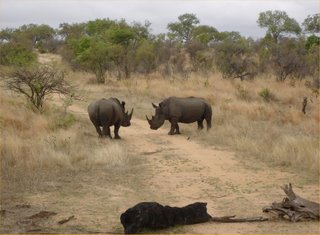 · Rhinoceros - #1 of the Big Five- only ten minutes into the park, we happened upon two ‘white rhinos’ (they aren’t actually white or even light in colour – it’s an evolution of the word ‘wide’ which described their jaw). Only about 3 meters off the road, they grazed and nipped at each other in oblivion of the human interlopers. This seemed to be the case with most of the wildlife, which were in abundance.
· Rhinoceros - #1 of the Big Five- only ten minutes into the park, we happened upon two ‘white rhinos’ (they aren’t actually white or even light in colour – it’s an evolution of the word ‘wide’ which described their jaw). Only about 3 meters off the road, they grazed and nipped at each other in oblivion of the human interlopers. This seemed to be the case with most of the wildlife, which were in abundance.
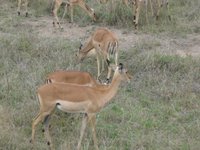 · The prolific impala – 100,000 + in the park with shiny tan fur, featherlike tails whisking away the flies, black markings on their rumps in the shape of MacDonald’s golden arches.
· The prolific impala – 100,000 + in the park with shiny tan fur, featherlike tails whisking away the flies, black markings on their rumps in the shape of MacDonald’s golden arches.
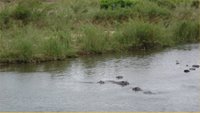 · Hippopotamus – many up close sightings mostly in the water. At first you only see what looks like a rock but then make out perky little ears and two revolving eyes, with sometimes a snout and nostrils above water. They can submerge for five minutes and then gracefully rise displaying their rotund bodies and then retreat to ‘periscope’ position. It’s so funny to see a row of little ears and eyes looking at you. A couple of times, we met some out of water grazing on the banks and saw them in their full glory.
· Hippopotamus – many up close sightings mostly in the water. At first you only see what looks like a rock but then make out perky little ears and two revolving eyes, with sometimes a snout and nostrils above water. They can submerge for five minutes and then gracefully rise displaying their rotund bodies and then retreat to ‘periscope’ position. It’s so funny to see a row of little ears and eyes looking at you. A couple of times, we met some out of water grazing on the banks and saw them in their full glory.
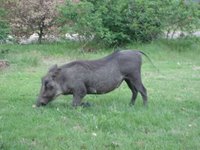 · Warthogs – pugnacious, bristly little ‘piggies’. One of our fellow passengers, Jean (a delightful blonde) called out ‘piggies on the left!’, which made us roar with laughter.
· Warthogs – pugnacious, bristly little ‘piggies’. One of our fellow passengers, Jean (a delightful blonde) called out ‘piggies on the left!’, which made us roar with laughter.
 · Elephants - #2 of the Big Five - in abundance. We watched them as they vandalized the forest – tearing limbs and bark from trees. “CRACK” we’d hear as they snapped tree trunks with ease. Three babies climbed on to each other’s backs playfully as if they were in the circus.
· Elephants - #2 of the Big Five - in abundance. We watched them as they vandalized the forest – tearing limbs and bark from trees. “CRACK” we’d hear as they snapped tree trunks with ease. Three babies climbed on to each other’s backs playfully as if they were in the circus.
 · Leopard tortoise – they’d amble away from the road into the long grass as vehicles approached but so slowly that we could easily get a good look.
· Leopard tortoise – they’d amble away from the road into the long grass as vehicles approached but so slowly that we could easily get a good look.
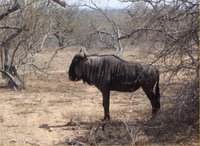 · Blue wildebeest – AKA gnus. Ungainly creatures so named for the noise they make when frightened “Gnuuuuuuuuu”
· Blue wildebeest – AKA gnus. Ungainly creatures so named for the noise they make when frightened “Gnuuuuuuuuu”
 · Giraffe – at a distance but since we’d had many close encounters at the Bushveld Camp, we weren’t disappointed.
· Giraffe – at a distance but since we’d had many close encounters at the Bushveld Camp, we weren’t disappointed.
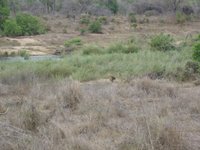 · Lion - #3 of the Big Five – several encounters. Elegant, calm, unafraid, they permitted a bevy of vehicles to view them from about ten meters. A large pride with a magnificent male, we watched youngsters frolic but not wildly, more a gentle rolling and pawing.
· Lion - #3 of the Big Five – several encounters. Elegant, calm, unafraid, they permitted a bevy of vehicles to view them from about ten meters. A large pride with a magnificent male, we watched youngsters frolic but not wildly, more a gentle rolling and pawing.
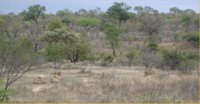
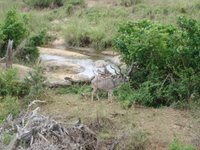 · Kudu - Kudu dung spitting (Bokdrol Spoeg in Afrikaans) is a sport in the bushveld of South Africa - small, hard pellets of dung from the Kudu are spat, with the furthest distance reached being the winner - and to think I have a champion right in the family.
· Kudu - Kudu dung spitting (Bokdrol Spoeg in Afrikaans) is a sport in the bushveld of South Africa - small, hard pellets of dung from the Kudu are spat, with the furthest distance reached being the winner - and to think I have a champion right in the family.
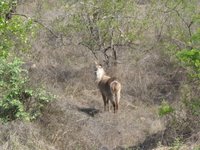 · Nyala – another antelope, similar to the kudu but smaller
· Nyala – another antelope, similar to the kudu but smaller
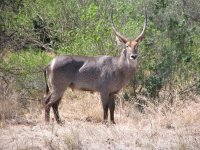 · Waterbuck – and yet another antelope, again similar to the kudu but larger
· Waterbuck – and yet another antelope, again similar to the kudu but larger
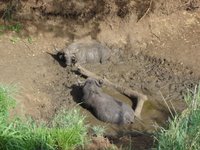 · Buffalo - #4 of the Big Five – massive beasts with their long curling horns, they are one of the most dangerous African animals.
· Buffalo - #4 of the Big Five – massive beasts with their long curling horns, they are one of the most dangerous African animals.
· Terrapin – hmmmm, not much to describe – swims and ????? swims.
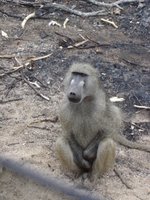 · Baboons – delightful, family-oriented beggars. A large male sat displaying his manhood cupped in his hands while the females and young groomed each other and scurried about. One little baboon snoozed sitting up like a little old man. Big Daddy sauntered over to the truck and plopped back down on his haunches obviously hoping for a handout. Suddenly, the whole troop were on the move along the dry riverbed, reminiscent of Planet of the Apes.
· Baboons – delightful, family-oriented beggars. A large male sat displaying his manhood cupped in his hands while the females and young groomed each other and scurried about. One little baboon snoozed sitting up like a little old man. Big Daddy sauntered over to the truck and plopped back down on his haunches obviously hoping for a handout. Suddenly, the whole troop were on the move along the dry riverbed, reminiscent of Planet of the Apes.
 · Steenbok – a small member of the antelope family, big ears and eyes. They don’t seem to roam in herds but travel alone.
· Steenbok – a small member of the antelope family, big ears and eyes. They don’t seem to roam in herds but travel alone.
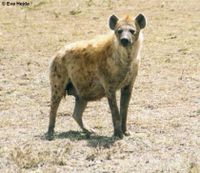 · Hyena – ugly, vicious critters, we found one lying in the long grass, sleeping beside the road. Well-camouflaged, only the twitch of his ears and tail gave away his location.
· Hyena – ugly, vicious critters, we found one lying in the long grass, sleeping beside the road. Well-camouflaged, only the twitch of his ears and tail gave away his location.
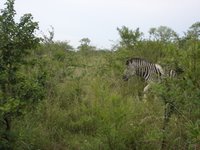 · Zebra – very skittish and their stripes tend to make them fade into the background. They hang around with giraffes, wildebeest and impala.
· Zebra – very skittish and their stripes tend to make them fade into the background. They hang around with giraffes, wildebeest and impala.
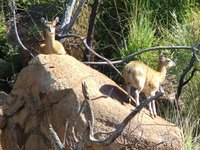 · Klipspringer – another small antelope, they live in rocky hills. They have hollow hooves that grip the rocks and run uphill when frightened instead of downhill like the rest of the antelopes.
· Klipspringer – another small antelope, they live in rocky hills. They have hollow hooves that grip the rocks and run uphill when frightened instead of downhill like the rest of the antelopes.
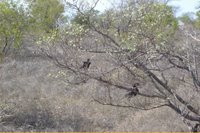 · Ground hornbill – large black bird with a red face. They are an endangered species, lay only two eggs every eight years and then only accept one of them. They don’t seem to worry about their precarious position.
· Ground hornbill – large black bird with a red face. They are an endangered species, lay only two eggs every eight years and then only accept one of them. They don’t seem to worry about their precarious position.
· Birds galore – eagles, storks, barbets, starling, francolin, owl, etc., etc.,
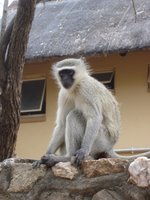 · Vervet monkey – we stopped for lunch on the banks of the Sabie River and the aggressive little primates watched for their opportunity to steal food. Signs proclaimed, “Do not feed the monkeys, they become dangerous and we must kill them”. They were repeatedly thwarted in their barrage of attempts but persevered. Their gray and white faces expressed their aggressiveness and stubbornness. Lunch was cleared up and a fellow passenger and I still sat at a table finishing our fruit. In front of me, I tucked peels into a plastic bag and folded and tucked it partially under my plate. Suddenly a monkey descended from the tree overhead, so quickly and landed on the table, bruising my shoulder in his descent and in the same motion grabbed my garbage bag with one hand while trying to snatch my orange with the other – all in a split second. I, of course did what any red-blooded woman would - I let out a blood-curdling shriek. The nasty little thief flew through the branches and onto the roof of an adjoining building but when he inspected his ‘haul’ he discarded it with contempt.
· Vervet monkey – we stopped for lunch on the banks of the Sabie River and the aggressive little primates watched for their opportunity to steal food. Signs proclaimed, “Do not feed the monkeys, they become dangerous and we must kill them”. They were repeatedly thwarted in their barrage of attempts but persevered. Their gray and white faces expressed their aggressiveness and stubbornness. Lunch was cleared up and a fellow passenger and I still sat at a table finishing our fruit. In front of me, I tucked peels into a plastic bag and folded and tucked it partially under my plate. Suddenly a monkey descended from the tree overhead, so quickly and landed on the table, bruising my shoulder in his descent and in the same motion grabbed my garbage bag with one hand while trying to snatch my orange with the other – all in a split second. I, of course did what any red-blooded woman would - I let out a blood-curdling shriek. The nasty little thief flew through the branches and onto the roof of an adjoining building but when he inspected his ‘haul’ he discarded it with contempt.
After lunch a travelmate and I went over to the washroom and a woman coming out said “Aye – there’s a man in there – in the ladies”. So, we peeked in and a stall door opened and a tall, elegantly dressed man with an arrogant manner stepped out. “You’re in the wrong room,” we chorused. He just sneered and raised his eyebrows arrogantly. That immediately raised my ire and I confronted him with my scorn and derision. “No doubt with your background, you haven’t been taught manners and decency” I said in my most imperious manner. Obviously not expecting confrontation, he scuttled out of there fast, back to his posh busload of wealthy sightseers. A simple apology would have averted all of this.
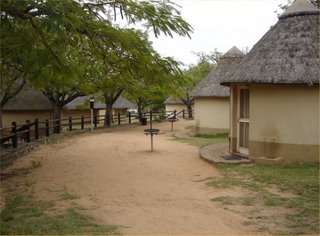 That night we spent in Pretoriuskop Camp, one of many in the national park. Round huts – rondavels, scattered about were our rooms. The truck was parked beside an open-sided rondavel, a kitchen complete with hotplates, sink, instant hot water – modern and utilitarian. Dorran pulled a huge stainless steel table and 16 chairs out of the truck’s underbelly – what an amazingly outfitted vehicle it is.
That night we spent in Pretoriuskop Camp, one of many in the national park. Round huts – rondavels, scattered about were our rooms. The truck was parked beside an open-sided rondavel, a kitchen complete with hotplates, sink, instant hot water – modern and utilitarian. Dorran pulled a huge stainless steel table and 16 chairs out of the truck’s underbelly – what an amazingly outfitted vehicle it is.
Fernie was sous chef again – he’s learning a lot from Dorran and enjoys working with him. South African Kentucky Fried Chicken – Fernie battered the pieces and manned the deep fryer. I managed to get to the camp store just before it closed and snafued a bottle of Cabernet/Merlot, which I shared, with some of the others. The kitchen was two-sided, two full workstations. A large South African chap was sautéing a scrumptious looking meal – I (as usual) struck up conversation with him and found him to be a garrulous and jovial chap. We joked and chatted and his wife arrived to help with the finishing touches. She was just as gregarious and when I asked her where they lived, she said “We’re Malallapipes” meaning ‘we sleep in pipes’ or homeless. They had recently sold their home, put their goods into storage and now live out of their SUV working here and there in the bush at camps. I told them that we called ourselves ‘nomads’ since we’d bought an RV and were roaming North America willy-nilly. So they suggested we swap expressions – Fernie and I are now Malallapipes and they’re Nomads. He was a chef by trade and got out of the ‘hotel’ business as it was too controlled – no allowance for a freedom of expression. But in camps, he does as he likes at the front end (cooking) while his wife does the back end (cleanup).
I found out all this by opening up with “you’re much too young to retire”.
She then proceeded to say with pride “Oy – I’m 56 and I got myself a young un’ – he’s only 42 yer know?”
”Oh yeah” he jumped in “I thought I got meself a sugar mommy and I sure ain’t getting’ no sugar” laughing uproariously. They trotted off back to their rondavel with their aromatic meal.
As we didn’t have a toilet in our hut, it meant walking to the bathhouse when I awoke at 3am. With my little flashlight, I made my way over – there was a most unusual insect in the stall – beetle like, about 3 inches long with a pointy tail and a hunch back. I scuffled my feet to frighten it away but the gutsy thing slunk over to get a closer look at me. I had sandals on and didn’t want it attacking my toes and I couldn’t bear to squash it. After all, it has more right to be there than I. It’s different with little bugs – I can happily squash them but when you can see their features, it personalizes them. So, I chose a different stall.
October 28, 2006 – Saturday
 It was a long drive south through Kruger and out at Malelene. We stopped for Dorran to shop for groceries and that gave us an hour to browse a large outdoor shopping centre.
It was a long drive south through Kruger and out at Malelene. We stopped for Dorran to shop for groceries and that gave us an hour to browse a large outdoor shopping centre. 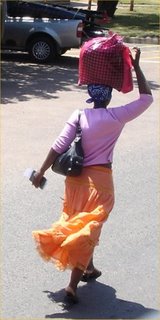 It seemed at first glance to be an affluent area but appearances can be deceiving. Poverty is endemic. However, the people were colourfully well dressed, buying goods and congregating in large happy groups. The children were beautiful – mothers carried babies on their lower backs, the babies’ legs encircling their waists and tucked in to a cotton shawl wrapped around their waists. The music attracted us – strong African rhythms, melodious voices and the locals were moving their bodies to the beat – so we went into the music store to ask what CD they were playing on the loudspeaker and promptly bought it.
It seemed at first glance to be an affluent area but appearances can be deceiving. Poverty is endemic. However, the people were colourfully well dressed, buying goods and congregating in large happy groups. The children were beautiful – mothers carried babies on their lower backs, the babies’ legs encircling their waists and tucked in to a cotton shawl wrapped around their waists. The music attracted us – strong African rhythms, melodious voices and the locals were moving their bodies to the beat – so we went into the music store to ask what CD they were playing on the loudspeaker and promptly bought it.
We passed vast sugar cane fields and sugar refineries. The sugar plants are set on fire in the fields and then the remaining sugar cane stalks are harvested. There were banana plantations, tomato fields and further south, pineapples. The speed limit is 120 kph so we roared across the lush landscape encircled with verdant mountains. Swaziland, a separate land-locked country surrounded by South Africa, is a sovereignty – they have a royal family.
 Poverty is widespread in Swaziland – however, when first entering from the north, we thought it fairly prosperous, with well-run farms – irrigated and fertilized, and sugar cane fields as far as the eye can see. To enter Swaziland, you must first sign out of South Africa – present passport, stamp, stamp, stamp. Then walk across to Swaziland customs, present passport, stamp, stamp, stamp. This process is repeated in reverse on leaving the country. While waiting in line, we educated ourselves by reading the prominent and graphic signs warnings about sexually transmitted diseases and malaria. A big basket brimming with condoms urged us to 'Help yourself'.
Poverty is widespread in Swaziland – however, when first entering from the north, we thought it fairly prosperous, with well-run farms – irrigated and fertilized, and sugar cane fields as far as the eye can see. To enter Swaziland, you must first sign out of South Africa – present passport, stamp, stamp, stamp. Then walk across to Swaziland customs, present passport, stamp, stamp, stamp. This process is repeated in reverse on leaving the country. While waiting in line, we educated ourselves by reading the prominent and graphic signs warnings about sexually transmitted diseases and malaria. A big basket brimming with condoms urged us to 'Help yourself'.
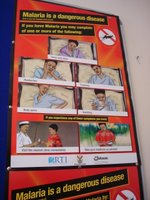
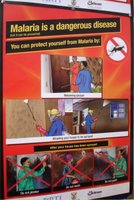
The agricultural lands diminished and we passed through mile after mile of tribal communities – round mud and thatch huts and small block hovels no more than 10’ x 10’ with outhouses a short distance away. Chickens, goats, emaciated cattle roamed at large. The only apparent transportation is their feet – people walking everywhere along the road.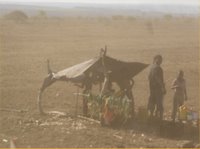 I saw a couple of bicycles and wheelbarrows to collect water but that was it. The only traffic on the road was transport trucks roaring through Swaziland.
I saw a couple of bicycles and wheelbarrows to collect water but that was it. The only traffic on the road was transport trucks roaring through Swaziland. 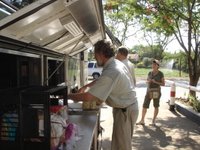 We stopped in ‘Big Bend’ to have lunch. I guess there aren’t many safe places to pull in so Dorran parked under some trees in a parking lot in front of several shops, whipped down the fold-out kitchen and we put together deli sandwiches and cut up slices of fresh pawpaw (papaya).
We stopped in ‘Big Bend’ to have lunch. I guess there aren’t many safe places to pull in so Dorran parked under some trees in a parking lot in front of several shops, whipped down the fold-out kitchen and we put together deli sandwiches and cut up slices of fresh pawpaw (papaya).
There was a bottle shop selling wine, beer and spirits. The owners spoke little English – just Swazi, so I attempted to say thank you in Swazi.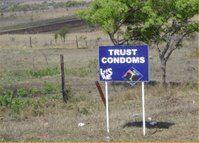 I asked the woman how to say it and she said ‘sabo’ or that’s what I thought I heard. So I said ‘Sabo’. She burst into laughter and so did her husband. “I guess my accent is funny” I thought but asked Dorran and he told me with an amused expression that it was ‘sayabonga’ phonetically. So I trotted back in went up to the desk and proudly said ‘say-a-bong-a’. This elicited more amusement but at least no uproarious laughter. ‘Crazy white lady’ is probably what they were saying as I left.
I asked the woman how to say it and she said ‘sabo’ or that’s what I thought I heard. So I said ‘Sabo’. She burst into laughter and so did her husband. “I guess my accent is funny” I thought but asked Dorran and he told me with an amused expression that it was ‘sayabonga’ phonetically. So I trotted back in went up to the desk and proudly said ‘say-a-bong-a’. This elicited more amusement but at least no uproarious laughter. ‘Crazy white lady’ is probably what they were saying as I left.

As we waited outside in line to present our passports to exit Swaziland, an elderly woman with a beat up old suitcase stood close by waiting for a ride, I suppose. Her eyes were glazed with thick cataracts which made me wonder if she was blind, but she was very proud, rubbing down the colourful material of her wraparound skirt to make sure it sat properly. She had a bright turquoise jacket topping it and shiny black plastic shoes. I said “Hello” and her face erupted into a broad smile displaying only two pointy teeth and she grabbed me and wrapped me in a huge hug. I was so touched feeling I’d made a momentary connection.
Out of Swaziland and into Zululand, which is part of South Africa. Luxuriant, tropical greenery and pineapples, bananas and sugarcane proliferated. Dorran stopped at the side of the road and bought 8 pineapples for 25 rand ($4 Cdn). Our next Drifters Inn was at HluHlue, pronounced Shlu-shlui.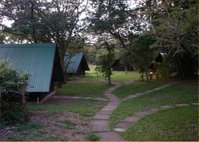 It’s in the middle of a private game reserve and our truck bumped and shimmied down a narrow dirt lane for several kilometers before our camp came into sight. This camp was the most rustic and basic of them all. Each cabin/tent was a tiny A frame with corrugated roof, screen door and window and just enough room for two bunks. Toilets and showers were a bit of a walk away, particularly at 2am. I’m not used to this kind of ‘roughing it’ but the experience is far from negative – in fact it’s freeing. As usual at Drifters, there’s an outdoor kitchen, dining area and a deck with a swimming pool sunk into it. Dinner was a huge pot of spaghetti and it was delicious.
It’s in the middle of a private game reserve and our truck bumped and shimmied down a narrow dirt lane for several kilometers before our camp came into sight. This camp was the most rustic and basic of them all. Each cabin/tent was a tiny A frame with corrugated roof, screen door and window and just enough room for two bunks. Toilets and showers were a bit of a walk away, particularly at 2am. I’m not used to this kind of ‘roughing it’ but the experience is far from negative – in fact it’s freeing. As usual at Drifters, there’s an outdoor kitchen, dining area and a deck with a swimming pool sunk into it. Dinner was a huge pot of spaghetti and it was delicious.
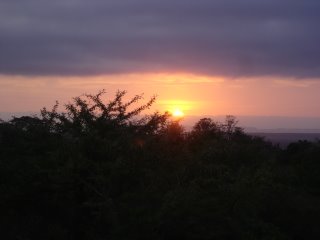
October 29, 2006 – Sunday
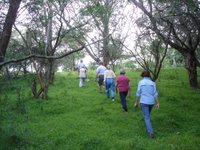 Awake at 3AM again, just couldn’t sleep. Finally got up at 4 and it was light by 5. As we were spending two nights in our little A frame huts, we had a whole day to fill with explorations. We started with a walk around the Drifters game reserve, tracking the animals on foot, trying to stay downwind and tread on our toes staying closely together in single file to be quiet and unrecognizable.
Awake at 3AM again, just couldn’t sleep. Finally got up at 4 and it was light by 5. As we were spending two nights in our little A frame huts, we had a whole day to fill with explorations. We started with a walk around the Drifters game reserve, tracking the animals on foot, trying to stay downwind and tread on our toes staying closely together in single file to be quiet and unrecognizable.  We’d watch their ears prick but be unsure of what we were – zebra, wildebeest, kudu, impala - no dangerous creatures. Watching a dung beetle in action was like watching an artist create a masterpiece. She’d work with the product and roll it into a ball at least as big as herself and use it to lay her eggs in. I had to be persuaded to actually hold a beetle.
We’d watch their ears prick but be unsure of what we were – zebra, wildebeest, kudu, impala - no dangerous creatures. Watching a dung beetle in action was like watching an artist create a masterpiece. She’d work with the product and roll it into a ball at least as big as herself and use it to lay her eggs in. I had to be persuaded to actually hold a beetle.  We didn’t pick one up from a dung pile but one just wandering in the grass – about an inch and a half in length, it was less frightening to me than smaller insects because I could decipher its physiology. I got quite a pleasant sensation as it ambled across my hand and arm – guess I’m just about ready to join ‘Geriatric Survivor’. Across meadows, through forest and we circled back to the camp, where we prepared breakfast. We were ravenous after our two-hour romp.
We didn’t pick one up from a dung pile but one just wandering in the grass – about an inch and a half in length, it was less frightening to me than smaller insects because I could decipher its physiology. I got quite a pleasant sensation as it ambled across my hand and arm – guess I’m just about ready to join ‘Geriatric Survivor’. Across meadows, through forest and we circled back to the camp, where we prepared breakfast. We were ravenous after our two-hour romp.
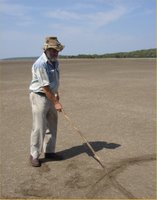 After breakfast, we headed out again – drove ten minutes to False Bay Park where we headed out again on a three hour hike through forest parched and dying in parts from the drought this area has been experiencing. St. Lucia Bay, a huge inland sea is totally dried out and it was only seven years ago that there was a vibrant tourist mecca on the beach and the lake was
After breakfast, we headed out again – drove ten minutes to False Bay Park where we headed out again on a three hour hike through forest parched and dying in parts from the drought this area has been experiencing. St. Lucia Bay, a huge inland sea is totally dried out and it was only seven years ago that there was a vibrant tourist mecca on the beach and the lake was 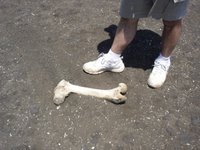 filled with crocs and hippos. Returning across the vast salt and dried mud lakebed, we came upon many skeletons of crocodiles and hippos – is this another result of global warming? The temperature rose as we progressed and we scurried across the remaining open salt flats for the shade of the shore as the sun beat mercilessly down on us.
filled with crocs and hippos. Returning across the vast salt and dried mud lakebed, we came upon many skeletons of crocodiles and hippos – is this another result of global warming? The temperature rose as we progressed and we scurried across the remaining open salt flats for the shade of the shore as the sun beat mercilessly down on us.
I was so hot when we got back to our camp, I ran into the restroom and washed my face with cold water. I didn’t have a towel so went back to the A frame and grabbed my hand towel off a hook and wiped my face with it. ‘Shriek!’ it felt like a million needles stuck in my lips and chin. I looked at the towel and a fat lime green spiky caterpillar about four inches long lay curled in a fold, his little spikes clinging to the fabric. My face was burning and I was concerned about what the venom could do to me so Fernie carried the creature up to Dorran to ask and he was reassured I wouldn’t die – the caterpillar would turn into a beautiful moth. It took three or four hours though for the distress to lessen.
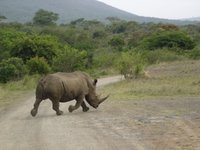 Lunch and our final wildlife foray. We split into two groups, piled into the safari jeeps – one piloted by Karen, the camp host – and drove 30 kilometers west to HluHlue National Game Park, another huge reserve teeming with animals including the big 5 – well, the big 4 to us. There were a couple of incidences that stood out from the usual sightings. A rhinoceros snorting and charging driving out other rhino interlopers from his territory. The dust flew voluminously and it was a thrilling episode to watch.
Lunch and our final wildlife foray. We split into two groups, piled into the safari jeeps – one piloted by Karen, the camp host – and drove 30 kilometers west to HluHlue National Game Park, another huge reserve teeming with animals including the big 5 – well, the big 4 to us. There were a couple of incidences that stood out from the usual sightings. A rhinoceros snorting and charging driving out other rhino interlopers from his territory. The dust flew voluminously and it was a thrilling episode to watch. 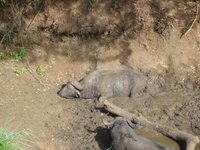 In a mud hole right beside the road, two aging buffalo bulls lay contentedly, deep in the mire - their useful days in the herd over, they’ll spend their retirement years in this jungle spa.
In a mud hole right beside the road, two aging buffalo bulls lay contentedly, deep in the mire - their useful days in the herd over, they’ll spend their retirement years in this jungle spa.
It started to get chilly as the sun went down and we huddled under fuzzy blankets, wind blasting our faces as Dorran drove back at his usual 100 kph+. We were physically exhausted but mentally energized after the long day from 6am to 6pm on the move.
Back at camp, there was a ‘boma’ beside the deck, fenced by bamboo poles; logs provided seating circling the fire that was used to barbecue chicken, pork and sausages. Fernie was sous chef again and looked after the braai while I sipped on a couple of vodka with dry lemonades and proceeded to polish off the remains of my bottle of wine. I like this arrangement.
We stayed up talking to Dorran about the wonders of Canada and the opportunities. He’s thinking of relocating temporarily and he would like to try Canada. His wife died last year and his children are grown, so he’s free to try something else new. We offered any assistance we could and will be pleased if he takes us up on our offer. In the meantime, he needs to do some research on immigration or work visa policies.
October 30, 2006 – Monday
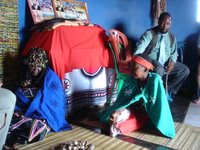 Every Zulu tribe has a ‘Sangoma’, a witch doctor of sorts but female. We were privileged to be invited to visit the Sangoma at HluHlue village – men were seated to her left and women to her right. She and her apprentice sat on the floor in a mud and thatch rondavel hut,
Every Zulu tribe has a ‘Sangoma’, a witch doctor of sorts but female. We were privileged to be invited to visit the Sangoma at HluHlue village – men were seated to her left and women to her right. She and her apprentice sat on the floor in a mud and thatch rondavel hut,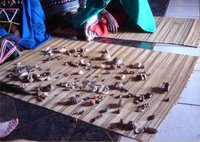 huddled in the dark recesses. Her voluminous breasts were wrapped in a shawl of black velvet and her hair was braided and threaded in multi-coloured beads. She looked at us shyly from under long eyelashes, her head tilted down. She was appraising us, readying appropriate answers for our questions. She shook up a container of mixed seashells, whistles, stones and coins and threw them across the floor like dice in a craps pit. It was then open for questions, which were translated by the schoolmaster.
huddled in the dark recesses. Her voluminous breasts were wrapped in a shawl of black velvet and her hair was braided and threaded in multi-coloured beads. She looked at us shyly from under long eyelashes, her head tilted down. She was appraising us, readying appropriate answers for our questions. She shook up a container of mixed seashells, whistles, stones and coins and threw them across the floor like dice in a craps pit. It was then open for questions, which were translated by the schoolmaster.
· “Will I have grandchildren?”
· “Will my son marry?”
· “What is my purpose in Africa?”
· “What is wrong with my legs?”
· “Will I have another heart attack?”
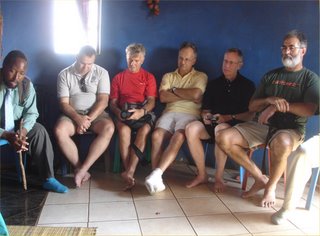
She tackled each query by looking at the pattern of the shells pointing to the individual and diagnosed with care. Not to be left out, I raked my mind for a question and finally came up with one.
· Will I ever be thin again?” I asked
The schoolmaster puzzled, asked me to repeat the question. I did and he broke into a smile as he spoke to the Sangoma in Zulu. A throaty chuckle emanated from the dark form on the floor and she looked me over and then looked at the shells. With her cane, she gestured to a round white one and answered simply.
· “No, you’ll get fatter!”
The room erupted with laughter and with that our visit was over. We all tossed the expected coins into her array of shells and headed over to the local high school where Drifters have forged a symbiotic relationship.
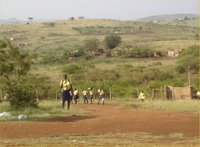 The children in their navy skirts and pants with yellow shirts and striped ties, converged on their school building high on top of a plateau. They walked miles and came from all directions. We were expected for a 2-½ hour visit and this was our opportunity to distribute our
The children in their navy skirts and pants with yellow shirts and striped ties, converged on their school building high on top of a plateau. They walked miles and came from all directions. We were expected for a 2-½ hour visit and this was our opportunity to distribute our  duffle bag of t-shirts, pens, pencils, erasers and calculators. We passed it over to the headmaster who was most appreciative and he promised to distribute to the most needy. There were 951 students attending classes and we hadn’t brought that many shirts.
duffle bag of t-shirts, pens, pencils, erasers and calculators. We passed it over to the headmaster who was most appreciative and he promised to distribute to the most needy. There were 951 students attending classes and we hadn’t brought that many shirts.
 There was a hustle and bustle as the teens organized themselves ready to entertain us with song and dance. The classroom was stifling with about thirty kids and all of us sharing the steamy atmosphere but once they started to sing, it didn’t matter. It touched my soul – the beauty and harmony of their voices and I felt a tear trickle down my cheek.
There was a hustle and bustle as the teens organized themselves ready to entertain us with song and dance. The classroom was stifling with about thirty kids and all of us sharing the steamy atmosphere but once they started to sing, it didn’t matter. It touched my soul – the beauty and harmony of their voices and I felt a tear trickle down my cheek. 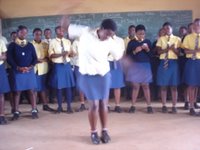 Then they broke out into a wild high-kicking dance – one at a time taking their turn at a solo performance. As we were leaving, a shy girl slunk out from the back of the group when I smiled and waved to her and she grasped me in a huge hug and I know it wasn’t choreographed. However, I’m sure they’ve been told the white tourists will donate more if they show affection.
Then they broke out into a wild high-kicking dance – one at a time taking their turn at a solo performance. As we were leaving, a shy girl slunk out from the back of the group when I smiled and waved to her and she grasped me in a huge hug and I know it wasn’t choreographed. However, I’m sure they’ve been told the white tourists will donate more if they show affection.
Last stop was the rustic headmaster’s office where we all signed in to the guest book that conveniently stood in front of the donation box. I asked the headmaster if a Canadian money donation would be ok and he said ‘No problem’. So Fernie and I tucked $20 each into the slot – not a lot I guess.

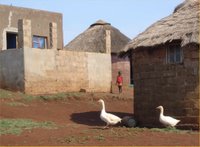
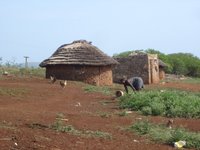
It was a short drive that day – only three hours to the Drifters Inn Dolphin Coast just 30 kilometers north of Durban, in Umdhloti (pronounced umshlotti). We could smell the sea long before we caught sight of it and as ocean addicts we were exhilarated when we rounded the corner and the vista of the Indian Ocean unfolded (azure with huge foamy breakers roaring onto the golden sand – shark infested waters however) - it was absolute bliss.
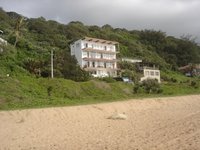 The Drifters Inn is a tall 5 story building every room with
The Drifters Inn is a tall 5 story building every room with 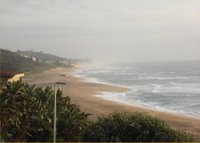 floor to ceiling, wall-to-wall windows all overlooking the spectacular coastline. Every floor had wide decks running the full length of the building. Our room #3 on floor #4 was a huge three-bedded one with ensuite. As I sat at peace out on the deck for an hour or so catching up this darn blog, dolphins skimmed along the crests of the waves and pods of whales spouted and breeched further out from the shore.
floor to ceiling, wall-to-wall windows all overlooking the spectacular coastline. Every floor had wide decks running the full length of the building. Our room #3 on floor #4 was a huge three-bedded one with ensuite. As I sat at peace out on the deck for an hour or so catching up this darn blog, dolphins skimmed along the crests of the waves and pods of whales spouted and breeched further out from the shore.
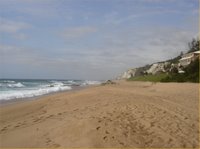 But the beach was calling us to stroll its length, picking up shells and coloured glass, edges rubbed smooth by the sand and sea. A terrific rip tide (not sure if that term is correct) could suck your feet from beneath you as the water rushed in and quickly out again. Though I’d folded my capris above my knees, one huge wave caught me by surprise and soaked me to the top of my thighs – didn’t care after that and frolicked freely – dripping wet when we got back to the hotel.
But the beach was calling us to stroll its length, picking up shells and coloured glass, edges rubbed smooth by the sand and sea. A terrific rip tide (not sure if that term is correct) could suck your feet from beneath you as the water rushed in and quickly out again. Though I’d folded my capris above my knees, one huge wave caught me by surprise and soaked me to the top of my thighs – didn’t care after that and frolicked freely – dripping wet when we got back to the hotel.
The population of this Malay coast is primarily of Indian heritage and the fishermen we met on the beach were very dark-skinned but with Indian features much like those from the south of India and Sri Lanka. I asked one young guy what he was fishing for and he answered in perfect well-spoken English “Black tail probably – about 2kg but I’ll take whatever I catch”. He smiled and his white teeth blinded me as the sun glinted off them.
There was lots of time to relax, have cocktails and generally recharge our internal batteries that were getting a bit rundown after our hectic first week. It’s hard to remember what day it is or what month or even the century – we’re removed from the doldrums of everyday life and I don’t ever want to return.
The fish braai catch of the day delivered to Dorran was a meter long hammer-headed dorado; someone said it was sometimes called mahi-mahi and it’s sometimes referred to as a ‘dolphin fish’ which disturbed me – but it was definitely not a dolphin. Dorran prepared it by rubbing it inside and out with herbs and spices and inserting lemon slices into slits in the body, wrapping it tightly in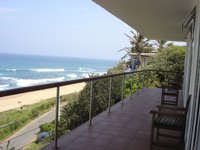 foil and then barbecued it for about an hour. It was a delicate sweetly flavoured white fish and we all sat at a long table on the lower patio and dined under the stars with the surf as our background music.
foil and then barbecued it for about an hour. It was a delicate sweetly flavoured white fish and we all sat at a long table on the lower patio and dined under the stars with the surf as our background music.
We left our patio doors wide open overnight and the curtains pulled back – I didn’t want to miss a minute of this magical place. However, having taken our weekly Larium (malaria prophylactic) with dinner, the night was filled with dreams. Fernie woke me from nightmares twice.
October 31, 2006 – Tuesday
The light woke me before 5:00am but I dozed back off until the sun rose at 5:03. It seems we only get between five and six hours sleep a night and that’s all we need. We had a slow start today giving us lots of time to stroll the beach, repack our clothes that we had laundered and I totally caught up my writing. Camera batteries and IPOD were recharged and good for another week at least.
Breakfast was elegantly prepared and served by the inn staff at 9am – none of our utilitarian stainless steel dishes. Instead china plates and mugs and glass tumblers – this must be what 5* is like. We could have easily enjoyed a second day at Umdhloti Dolphin Coast Inn but we were on the way to our next adventure. It’s hard to believe how changeable this beautiful country is – they have it all. Now we were headed for the mountains – the Drakensberg but first we’d visit Durban.
I fought sleep as forests of eucalyptus mesmerized me in their tedium. The eucalyptus trees are trained to have a single straight trunk and then they’re used for power and telephone poles. Affluent communities surround Durban’s city core. The sub-tropical climate and the environs were evocative of Hawaii – thick dense undergrowth, tropical flowers and sweetly scented air. The highway skirted the ocean and tourist beaches stretched endlessly along the coast. The Golden Mile is the beach mecca – five star hotels, fun and games, restaurants and shops galore – very Waikiki!
mesmerized me in their tedium. The eucalyptus trees are trained to have a single straight trunk and then they’re used for power and telephone poles. Affluent communities surround Durban’s city core. The sub-tropical climate and the environs were evocative of Hawaii – thick dense undergrowth, tropical flowers and sweetly scented air. The highway skirted the ocean and tourist beaches stretched endlessly along the coast. The Golden Mile is the beach mecca – five star hotels, fun and games, restaurants and shops galore – very Waikiki!
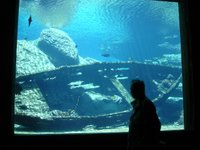 We stopped for a few hours there beside the beach near the aquarium. Dorran mentioned that we’d probably regret not visiting the aquarium, as it was world-renowned, so we paid the admission of 75 rand each ($12 Cdn). A sunken hull provides the container for the myriad of ocean creatures and the sun shone through making it a heavenly spectacle. It was well worth the admission fee. I picked up some sushi and Fernie a sandwich and some
We stopped for a few hours there beside the beach near the aquarium. Dorran mentioned that we’d probably regret not visiting the aquarium, as it was world-renowned, so we paid the admission of 75 rand each ($12 Cdn). A sunken hull provides the container for the myriad of ocean creatures and the sun shone through making it a heavenly spectacle. It was well worth the admission fee. I picked up some sushi and Fernie a sandwich and some 
drinks so we could have lunch on the truck while we traveled. Just as we were about to leave the shopping area, Fernie said with panic “Where’s my hat?” (referring to his brand new $75 Tilley – his older Tilley wasn’t good enough for Africa). With that, we had to retrace our steps but running this time as it was time to leave. So back to Wimpy’s, back to the sushi bar, back to the water shop and finally to the restroom that he’d visited last – Voila! Breathless from the panicky run, we arrived back at the truck only five minutes late but we hate to keep people waiting. We took a circuitous route through Durban on the way out to get a good look at the city with its Indian ambience, Hindu temples et al.
Due west, the drive up to the Drakensberg was a steady climb from sea level to 1700 meters at destination. Through the clouds that seemed to shroud the mountain range and out the other side, we got back to glorious sunshine and the silhouette of the Drakensberg was breathtaking.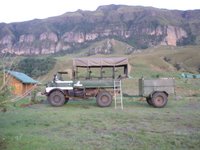 The Drifters Drakensberg Inn is high up in the mountains at the base of the sheer cliffs. We had to leave our truck below, took just what we needed for two days and all piled into a specially constructed 4x4 to jerk and clatter up - about a half an hour drive. It was an open-backed truck, canvas cover with four rows of benches with four people per row. Donny, the inn host was a lean and tanned young man with a buzz cut and a broad smile.
The Drifters Drakensberg Inn is high up in the mountains at the base of the sheer cliffs. We had to leave our truck below, took just what we needed for two days and all piled into a specially constructed 4x4 to jerk and clatter up - about a half an hour drive. It was an open-backed truck, canvas cover with four rows of benches with four people per row. Donny, the inn host was a lean and tanned young man with a buzz cut and a broad smile.
“Climb on up” he said to me.
“They told me I have to sit in the back row” I responded not quite whiningly “so I have to wait until all the rest of them are on first.”
“Oy then – you’ll just have to join me in the cab then” I didn’t stay to argue and clambered quickly up into the passenger seat.
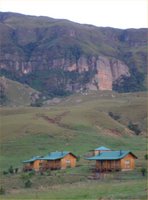 Our log cabins finally came into view after our bones had been rattled and shaken up the curving stone and dirt roadway. Situated high, they all faced the magnificence of green valleys and granite cliffs of the Drakensberg. Each cabin consists of two rooms with a shared bathroom in the centre. I immediately asked Christie and Lane if we could share and they agreed. We had a fireplace in every room, fire-starters and logs provided but it was too warm to use it. The Drakensberg Drifters Inn at 1700 meters is not that high to BC standards, but it felt as if we were in an aerie far removed from civilization.
Our log cabins finally came into view after our bones had been rattled and shaken up the curving stone and dirt roadway. Situated high, they all faced the magnificence of green valleys and granite cliffs of the Drakensberg. Each cabin consists of two rooms with a shared bathroom in the centre. I immediately asked Christie and Lane if we could share and they agreed. We had a fireplace in every room, fire-starters and logs provided but it was too warm to use it. The Drakensberg Drifters Inn at 1700 meters is not that high to BC standards, but it felt as if we were in an aerie far removed from civilization.
The central octagonal dining room, bar and deck beckoned with thoughts of a Savanna Dry, our new favourite drink. I also bought an expensive award-winning Cabernet Sauvignon and shared it with Christie for dinner. Neither Fernie nor Lane enjoy red wine – fools that they are. Donny and his partner, Adele, prepared dinner for us with the assistance of their black workers. (I refuse to refer to them as servants, which is the usual South African term – I find it deprecating). Soft candlelight lamps, china and glass, wonderful wine, good company all made our chicken dinner even more delicious. They served a crème caramel for dessert but I’m not an aficionado. Most were delighted with it. We lingered an hour after dinner chatting in the bar before exhaustion set in. It was only 8:30 when we put on our PJ’s and slipped into the comfy white-sheeted beds, our sleeping bags atop us and windows wide open. Then the most amazing sound and light show broke out – for about an hour, the lightning illuminated the sky silhouetting the mountains while thunder crashed in synchronization and it seemed to come from all directions. It was thrilling but a little fearsome – I’d never ever seen a storm like it.
It was only 8:30 when we put on our PJ’s and slipped into the comfy white-sheeted beds, our sleeping bags atop us and windows wide open. Then the most amazing sound and light show broke out – for about an hour, the lightning illuminated the sky silhouetting the mountains while thunder crashed in synchronization and it seemed to come from all directions. It was thrilling but a little fearsome – I’d never ever seen a storm like it.
I awoke every hour as usual – I had two itchy insect bites on my arm and foot and wondered if I got them in bed or before. It was too hot with the sleeping bag on and too cold with it off so I tossed and turned. Apparently, I talked in my sleep too – don’t know if I’ll take Larium for malaria again.
November 1, 2006 – Wednesday
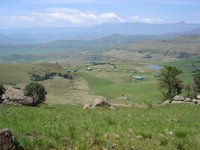 I got up just after 4:00am, got dressed and ventured out for a walk as it got light and I watched for the sunrise and it was glorious. Breakfast was served at 8 and box lunches were piled up ready for us to take on our hike. Hiking poles were suggested and they’d brought in about twenty wooden poles with African motif in varying lengths. I foolishly chose one for packability rather than usability – one that I thought would fit in my suitcase to take home –
I got up just after 4:00am, got dressed and ventured out for a walk as it got light and I watched for the sunrise and it was glorious. Breakfast was served at 8 and box lunches were piled up ready for us to take on our hike. Hiking poles were suggested and they’d brought in about twenty wooden poles with African motif in varying lengths. I foolishly chose one for packability rather than usability – one that I thought would fit in my suitcase to take home – of course it wouldn’t fit anyway. It was a long steep climb that we all took slowly, stopping to catch our breath when necessary. As we ascended, the beautiful fertile green valley and encircling stark cliffs unfolded to an exotic panorama.
of course it wouldn’t fit anyway. It was a long steep climb that we all took slowly, stopping to catch our breath when necessary. As we ascended, the beautiful fertile green valley and encircling stark cliffs unfolded to an exotic panorama.
Up we went, fording streams and clambering over rocks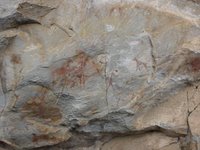 until we reached the Bushmen’s caves where the tiny Bushmen resided hundreds of years ago. A bit further along are ochre wall paintings of dogs, men and horses. During the climb, I huffed and puffed until I got my second wind. We intended to climb all the way up to the top of the cliffs to see the rare cape vulture colony. The path changed to a steep dirt and stone staircase cut into the side of the hill and a few hundred feet up, Fernie doubled over with a pain in his side – worried that he’d rupture the hernia he had repaired 9 months ago, we had to turn back. I was disappointed but surprised that it was Fernie not I that couldn’t continue.
until we reached the Bushmen’s caves where the tiny Bushmen resided hundreds of years ago. A bit further along are ochre wall paintings of dogs, men and horses. During the climb, I huffed and puffed until I got my second wind. We intended to climb all the way up to the top of the cliffs to see the rare cape vulture colony. The path changed to a steep dirt and stone staircase cut into the side of the hill and a few hundred feet up, Fernie doubled over with a pain in his side – worried that he’d rupture the hernia he had repaired 9 months ago, we had to turn back. I was disappointed but surprised that it was Fernie not I that couldn’t continue.
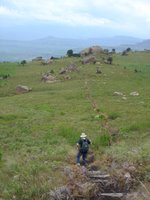
We sat down below on a big slab of rock munching on our cheese and tomato buns and bananas and watched the others reach the top through our binoculars. Several of them were on hands and knees crawling. We got back about 1:30 – a four hour hike and we were plenty tired and very happy to shower and rest up the rest of the day. Lane and Christie got back about an hour after us not managing the last six sheer meters. Thunder erupted about half an hour later and we were glad we’d come back. But it’s not unusual in the Drakensberg to experience four seasons in one day. We lit a fire in our room with Lane’s assistance – with the wind howling outside, we were so cozy and we played a game of Spite and Malice.
 The eight that carried on to the high realms of vulturedom (the intrepid ones) arrived back about three hours after us. They’d been caught in the storm and were soaking wet. The wind gusts were so high on the bluff; they said it felt as if they’d be lifted off their feet. Battling the storm, Jean who is one of the fittest, fell and trying to save herself broke her wrist. Legs both bleeding, wrist hanging, she still had to traverse down the long paths back. They drove her directly into the nearest town and then further to Bethlehem a town with a small hospital. She had surgery to put pins in her wrist and they kept her overnight.
The eight that carried on to the high realms of vulturedom (the intrepid ones) arrived back about three hours after us. They’d been caught in the storm and were soaking wet. The wind gusts were so high on the bluff; they said it felt as if they’d be lifted off their feet. Battling the storm, Jean who is one of the fittest, fell and trying to save herself broke her wrist. Legs both bleeding, wrist hanging, she still had to traverse down the long paths back. They drove her directly into the nearest town and then further to Bethlehem a town with a small hospital. She had surgery to put pins in her wrist and they kept her overnight.
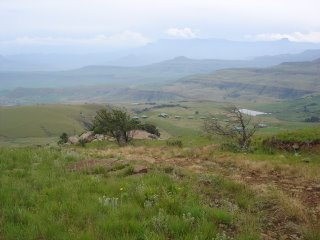
We went to bed that night with the wind whistling outside, a fire smoldering in the fireplace and we snuggled into our sleeping bags ‘as snug as bugs in a rug’.
November 2, 2006 – Thursday
It thundered and rained all night long – very conducive to a better night’s sleep – or perhaps the effects of the Larium are lessening. Got up at 5am as it got light and packed our gear. The ride down the mountain in the 4x4 was a jarring and tortuous one in the rear seat. After the rain, the creeks were overflowing but the vehicle transited them without a problem. We were back to our truck and on the way by 10 am. Dorran deposited us in the little artistic community of Clarens while he drove to Bethlehem to pick up Jean and Andre (her travel partner) from the hospital. In Clarens, it was drizzling and the arty little shops were high-priced so we joined Lane and Christie for lunch and tea (quiche for me and hake for Fernie).
We chatted to a gregarious gallery manager as we waited for Dorran to return. Lal, short for Lally, short for Hilary, appeared to be of Indian descent – I would say Anglo-Indian. She was a short rather rotund woman but extremely attractive for her age (50-60ish) with flashing black eyes. She wore a silver ‘Humpty Dumpty’ around her neck and laughingly told us how she’d made it out of an antique baby rattle. A ring on her index finger displayed her name, Lal and that’s how we delved into her real name. She regaled us with stories of her travels to the US and put on a New Jersey accent that was pretty authentic. The time passed quickly chatting to that charming woman.
Jean, in spite of her broken wrist was in good spirits and didn’t look the worse for wear – she and Andre laughed as much as ever. The rain continued to pour down as our highway skirted the northern border of Lesotho passing through Golden Gate Park. Many species of antelope and the black wildebeest inhabit the park. The sandstone mountains stood as sentinels ringing the green and golden grasslands. Rushing waterfalls tumbled mightily from the mountaintops. Rushing streams turned into rivers and etched the landscape even gushing across the road at low points.
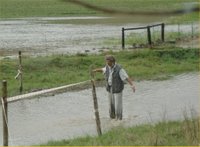 Oldenburg farm is off the highway along several kilometers of dirt roads. We forded a washout without too much trouble but a bit further on a stream had flooded its banks and washed out the main bridge and left 18 inches deep water across the road. What looked like a bamboo bridge was temporarily in place. I couldn’t possibly imagine that it would hold us. Dorran took off his shoes and socks and waded through to test the ground the other side – the water was past his knees. He attempted it anyway, gunning the truck with success. “We’re not out of the woods yet” he announced as we approached a gated sharp left turn which led directly uphill after. Water was gushing down the road forming gullies and rivulets. It was daunting. It was very quiet in the truck as we maneuvered the turn and skated precariously up the muddy hill but the rear end slid sideways into the ditch. We were on the low side and I had visions of it flipping on its side. As Dorran gently urged it back and forth, the truck just embedded itself deeper in the sucking gumbo. We heard a rumble and over the hill appeared a large blue tractor. They’d obviously expected we’d have problems traversing the road and dispatched the tractor. It took a half a dozen tries with the undersized tow chain snapping off until suddenly ‘Pop’ out we came from the mire.
Oldenburg farm is off the highway along several kilometers of dirt roads. We forded a washout without too much trouble but a bit further on a stream had flooded its banks and washed out the main bridge and left 18 inches deep water across the road. What looked like a bamboo bridge was temporarily in place. I couldn’t possibly imagine that it would hold us. Dorran took off his shoes and socks and waded through to test the ground the other side – the water was past his knees. He attempted it anyway, gunning the truck with success. “We’re not out of the woods yet” he announced as we approached a gated sharp left turn which led directly uphill after. Water was gushing down the road forming gullies and rivulets. It was daunting. It was very quiet in the truck as we maneuvered the turn and skated precariously up the muddy hill but the rear end slid sideways into the ditch. We were on the low side and I had visions of it flipping on its side. As Dorran gently urged it back and forth, the truck just embedded itself deeper in the sucking gumbo. We heard a rumble and over the hill appeared a large blue tractor. They’d obviously expected we’d have problems traversing the road and dispatched the tractor. It took a half a dozen tries with the undersized tow chain snapping off until suddenly ‘Pop’ out we came from the mire.
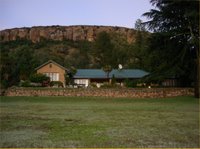 The beautiful sprawling ranch style farmhouse was over 100 years old but the interior was refurbished and modern. Fernie and I were escorted to a lovely and luxurious large room with a queen sized bed (instead of the usual singles), huge soaker tub and separate shower and multi-paned windows on two sides overlooking the gardens, swimming pool and mountain ringed valley in the distance. We didn’t need sleeping bags, pillows or towels as all were supplied. Soft sheets and big fluffy towels – it felt strange – we didn’t belong here’ we were so used to roughing it by now. But it was wonderful.
The beautiful sprawling ranch style farmhouse was over 100 years old but the interior was refurbished and modern. Fernie and I were escorted to a lovely and luxurious large room with a queen sized bed (instead of the usual singles), huge soaker tub and separate shower and multi-paned windows on two sides overlooking the gardens, swimming pool and mountain ringed valley in the distance. We didn’t need sleeping bags, pillows or towels as all were supplied. Soft sheets and big fluffy towels – it felt strange – we didn’t belong here’ we were so used to roughing it by now. But it was wonderful.
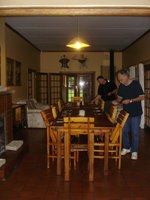
We all pitched in on making a simple dinner – fish and salads and we sat at the long ranch dining table in the manner of days gone by. Does South Africa make a bad wine? Their Cabernets are superb and tonight Christie shared hers with me.
November 3, 2006 – Friday
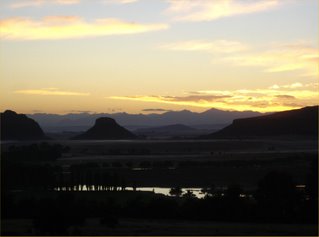
What a wonderful sleep – finally. I still got up before 5am but we were in bed by 9 so that’s to be expected. Our room faced east and the rain had passed. The sunrise was spectacular, with strips of mist across the distant mountains, trees reflected in a rosy hue in the valley bottom lake. We were on the road at 6:30am after an early breakfast prepared by the farm staff. The truck maneuvered the mud without incident but the big blue tractor followed us down just in case. It was going to be a long day with our destination the Karoo – the desert.
The fertile valleys opened up beyond Bloemfontein and flattened into arid, grassy plains – prairie. The road was a straight swathe though busy with freight carriers and not much else. An easy drive so Dorran was talking about South African history over the intercom and he lulled me blissfully to sleep. The truck stopping woke me – no motor sound as he eased it over to the shoulder. Hmmm? Out of diesel or so it seemed. Most of us climbed down to see what was happening. “Probably an air lock!” I said with humour, pulling out some of the mechanical talk that I’d gathered over the years.
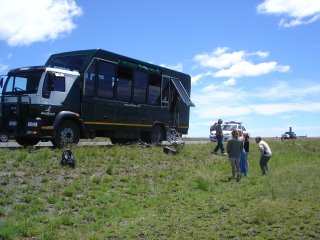
After some general tinkering, it was found that one tank was empty and the fuel wasn’t transferring from the secondary one. Dorran and some of the men took turns lying under the behemoth and manually pumping fuel across with no success. Can you believe it? My preliminary diagnosis was correct “We had an air lock”. A highway patrol car pulled over and the officer kindly stayed with us during the breakdown, giving moral support anyway. There was bright sunshine but it wasn’t warm. There was a keen wind and chill in the arid air. The motor was accessed by jacking the cab forward – so some tinkering ensued – some bleeding of lines, I suppose (that’s just more mechanical lingo that I’ve stored waiting for the chance to use it). Five minutes short of an hour, the motor started to catch and Voila!, we were on our way once again.
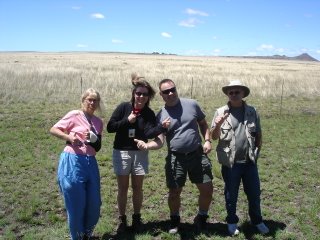
Fifteen kilometers down the road, we stopped in the little town of Trompsburg to fill our tanks. The service station was all torn up. A crane was in the process of lifting a huge tank out of the ground. Workers were crawling around like ants, lit cigarettes in hand. Dorran had to squeeze the truck in, turn it around and reverse back to the sole operational diesel pump.
Freshly shorn sheep grazed the grasslands looking skinny and naked – they’d scamper away from the road as our truck approached. Further on, the grasslands thinned exposing more and more sand. On this rocky territory, goats prevailed. Prickly pear cactus and sisal grew and ostrich and springbok roamed. The Karoo is full of a myriad of desert plants – grass is sparse and shrubs are scrubby but there are bright yellow blossoms brightening up the otherwise gray and beige landscape.
New Bethesda is a little town that time forgot. Whitewashed stone buildings and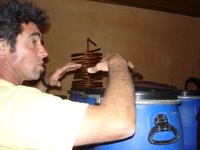 black, white and coloured children running around together. We stopped there to visit ‘Andre’s Brewery’. Andre, a young family man with three children makes home brew legally and sells it to passing tourists. He has a herd of goats and also makes a variety of goat cheeses. He served us a platter of cheeses, olives and kudu salami – that bothered me so I stuck to the cheese and olives – he probably shot the kudu himself but wouldn’t own up to it. We sampled two ales that he brews as well – quite delish.
black, white and coloured children running around together. We stopped there to visit ‘Andre’s Brewery’. Andre, a young family man with three children makes home brew legally and sells it to passing tourists. He has a herd of goats and also makes a variety of goat cheeses. He served us a platter of cheeses, olives and kudu salami – that bothered me so I stuck to the cheese and olives – he probably shot the kudu himself but wouldn’t own up to it. We sampled two ales that he brews as well – quite delish.
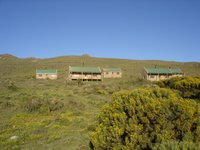 The Drifters Karoo Inn is at the end of a long and tortuous road – as usual, extremely remote. The accommodations were in little stone huts – two rooms and a shared bathroom in each. We joined Lane and Christie again – they’re so easy to get along with. Lane lit a fire in the shared antechamber and our rooms were toasty and romantic in candlelight (no electricity). We didn’t arrive until almost 7pm and dinner was served by the staff half an hour later – a spicy Malay meat dish with salad and broccoli.
The Drifters Karoo Inn is at the end of a long and tortuous road – as usual, extremely remote. The accommodations were in little stone huts – two rooms and a shared bathroom in each. We joined Lane and Christie again – they’re so easy to get along with. Lane lit a fire in the shared antechamber and our rooms were toasty and romantic in candlelight (no electricity). We didn’t arrive until almost 7pm and dinner was served by the staff half an hour later – a spicy Malay meat dish with salad and broccoli.
It got really cold overnight so we had our sleeping bags and an extra blanket over us and then I descended into oblivion for six hours straight. That’s a record.
November 4, 2006 – Saturday
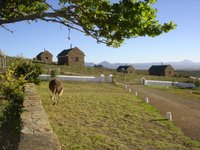 This rising with the sun has got to stop – 5:00am and I’m energized and raring to meet the day. Why am I not like this at home? Fernie and I went on a desert walk tracking some kudu and bontebok – they were ever watchful though and only allowed us so near. Ostriches strutting like Nazis took little interest but kept chowing down grass and miscellaneous debris. Little springbok were the most wary and pranced away quickly once they became aware of us.
This rising with the sun has got to stop – 5:00am and I’m energized and raring to meet the day. Why am I not like this at home? Fernie and I went on a desert walk tracking some kudu and bontebok – they were ever watchful though and only allowed us so near. Ostriches strutting like Nazis took little interest but kept chowing down grass and miscellaneous debris. Little springbok were the most wary and pranced away quickly once they became aware of us.
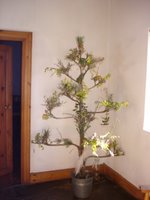 A late breakfast today 9:00am and Dorran led us on a hike around the facing mountain. Drifters, an environmentally concerned company, has removed plants that are not endemic to the Karoo and replaced them with indigenous species. The desert was awash in colour – yellow primarily but on closer look, also purple, red, orange, white and blue. Jean and I decided we’d decorate the Karoo Xmas tree – a sisal flower stalk that was standing in the dining room. So we collected desert plants as we hiked.
A late breakfast today 9:00am and Dorran led us on a hike around the facing mountain. Drifters, an environmentally concerned company, has removed plants that are not endemic to the Karoo and replaced them with indigenous species. The desert was awash in colour – yellow primarily but on closer look, also purple, red, orange, white and blue. Jean and I decided we’d decorate the Karoo Xmas tree – a sisal flower stalk that was standing in the dining room. So we collected desert plants as we hiked. 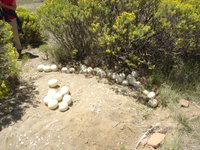 We met an array of wildlife as we walked – there are no dangerous species here unless you count ostriches which can be a bit aggressive but usually just go after shiny objects. There were bontebok, springbok, ostriches, zebra and eland (the largest of the antelopes). We climbed up to an ostrich nest. The prime female lay her egg(s) in the centre and the lesser females deposit theirs around the perimeter securing the prime females eggs from the scavengers. There were about 25 or so eggs in the single nest. It took us 2 ½ hours to complete the walk but we strolled and stopped and just took our time.
We met an array of wildlife as we walked – there are no dangerous species here unless you count ostriches which can be a bit aggressive but usually just go after shiny objects. There were bontebok, springbok, ostriches, zebra and eland (the largest of the antelopes). We climbed up to an ostrich nest. The prime female lay her egg(s) in the centre and the lesser females deposit theirs around the perimeter securing the prime females eggs from the scavengers. There were about 25 or so eggs in the single nest. It took us 2 ½ hours to complete the walk but we strolled and stopped and just took our time.
Fernie and I helped Dorran prepare lunch of hamburgers with fried eggs – Wimpy style and then we just vegged out on our verandah for the afternoon, watching the varied wildlife pass by. The ostriches of course came right up to our deck eying us with interest.

Dorran demanded that he be left alone to prepare dinner and we didn’t argue. He prepared roast beef – quite delicious but I’m aghast at the meat intake of South Africans – each meal seems to be at least 50% meat.
November 5, 2006 – Sunday
 On the road early – 7:00am, we stopped in the little town of Graaf-Reinet for a couple of hours, where we gave a cursory visit to several museums. The Karoo is full of prehistoric fossils from the Permian period – way before Jurassic. It was a hokey little museum but it had some wonderful fossils.
On the road early – 7:00am, we stopped in the little town of Graaf-Reinet for a couple of hours, where we gave a cursory visit to several museums. The Karoo is full of prehistoric fossils from the Permian period – way before Jurassic. It was a hokey little museum but it had some wonderful fossils.
Half an hour out of Graaf-Reinet, one of the passengers found she’d left her camera in a coffee shop back in town. This meant we had to turn around and go back for it, losing over an hour. As it was going to be a long day, it was decided that we not stop for lunch to compensate. We started the day in the Karoo desert ringed by hills which became sparser of plants as we progressed and then as we got to the mountains, scrubby trees started to show getting thicker and fuller until it became a full dense forest. I rode up front with Dorran across the Outenqua Mountain pass, a gravel road through a long deep gorge – a one and a half hour visually gorgeous transit. It was much like some of the roads I’d navigated Fernie over in our RV, to his chagrin.
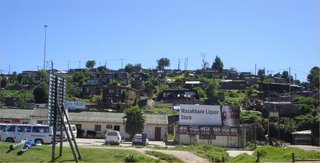 There’s a large squatter camp on the way into Knysna – mile upon mile of tumbledown, gray clapboard shacks built up the hillsides in a haphazard fashion – it reminded me of a film set. Some maybe most of the shacks were no more than 6 or 7 foot square and most had black plastic covering the roofs. Folks were cooking outside on their tumbledown porches. I don’t think there was any sort of sanitation and definitely no electricity. A quarter mile away, millionaires had built their mansions – this is the Garden Route. The polarity is very troubling.
There’s a large squatter camp on the way into Knysna – mile upon mile of tumbledown, gray clapboard shacks built up the hillsides in a haphazard fashion – it reminded me of a film set. Some maybe most of the shacks were no more than 6 or 7 foot square and most had black plastic covering the roofs. Folks were cooking outside on their tumbledown porches. I don’t think there was any sort of sanitation and definitely no electricity. A quarter mile away, millionaires had built their mansions – this is the Garden Route. The polarity is very troubling.
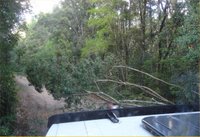 The Drifters Knysna Inn is, of course, a trifle remote….that’s the charm. Today, we encountered another obstacle – a tree had fallen across the road……it took all the able bodied to snap off branches and move it sufficiently so the truck could squeeze by.
The Drifters Knysna Inn is, of course, a trifle remote….that’s the charm. Today, we encountered another obstacle – a tree had fallen across the road……it took all the able bodied to snap off branches and move it sufficiently so the truck could squeeze by.
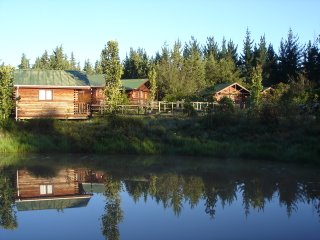 The inn was run by Hilda (from Holland) and her husband, Gavin (from Zimbabwe) with their two-year-old son. Hilda told me that they’d be going to Holland to live because they didn’t see much future for William in South Africa. However, it was going to be a long and difficult process for Gavin to emigrate. The anarchy in Zimbabwe has taken the bureaucracy into chaos and it’s taken him over a year to be able to obtain his birth certificate.
The inn was run by Hilda (from Holland) and her husband, Gavin (from Zimbabwe) with their two-year-old son. Hilda told me that they’d be going to Holland to live because they didn’t see much future for William in South Africa. However, it was going to be a long and difficult process for Gavin to emigrate. The anarchy in Zimbabwe has taken the bureaucracy into chaos and it’s taken him over a year to be able to obtain his birth certificate.
There was another group staying at the inn in the main building. We were in the chalets. There were two rooms per chalet again with a shared bathroom. Lane and Christie were once again our roommates. We’ve developed quite a comfort level with them. Set in a pine forest, we could have been in BC, if not for the strange birdcalls. The weather is cooler now and they obviously get a lot of rain – everything is so green and fertile.
Dinner was prepared by Hilda and her staff – a braai of lamb chops and sausages with salads – I swear I’m going home to a vegetarian diet. I’m so tired of meat. Dead tired, I went straight to bed and slept soundly in the cool night until my usual waking time of 5am.
November 6, 2006 – Monday
An early long walk in the woods recharged my batteries. I’ve reached the point in the trip where I’m craving ‘alone time’ and the early morning hours offer me the peace and solitude I need.
 The day was so full. We stopped at Bloukrans Bridge, the highest single span arch bridge in the world where the highest commercially operating bungy jump in the world operates. It’s situated 40km east of Plettenberg Bay along the N2 Highway. Watching the jumpers, I was so tempted to try it……if only I were 20 years younger. There were no takers in our group.
The day was so full. We stopped at Bloukrans Bridge, the highest single span arch bridge in the world where the highest commercially operating bungy jump in the world operates. It’s situated 40km east of Plettenberg Bay along the N2 Highway. Watching the jumpers, I was so tempted to try it……if only I were 20 years younger. There were no takers in our group.
 In TsiTsikamma National Park, we took a hike along the otter trail, a seaside walk, up to the point where it was miles of climbing across boulders. The Indian Ocean is wild and exciting and huge waves crashed on the rocky precipices. Dorran didn’t clearly state that we should turn around where the trail stopped and boulders began and Barbara (one of the German women) carried on for another hour. Dorran ran the trail like an antelope to bring her back while we walked the other direction to the mouth of Storm’s River where a suspension bridge crosses the wide gorge just as the river empties into the ocean.
In TsiTsikamma National Park, we took a hike along the otter trail, a seaside walk, up to the point where it was miles of climbing across boulders. The Indian Ocean is wild and exciting and huge waves crashed on the rocky precipices. Dorran didn’t clearly state that we should turn around where the trail stopped and boulders began and Barbara (one of the German women) carried on for another hour. Dorran ran the trail like an antelope to bring her back while we walked the other direction to the mouth of Storm’s River where a suspension bridge crosses the wide gorge just as the river empties into the ocean.
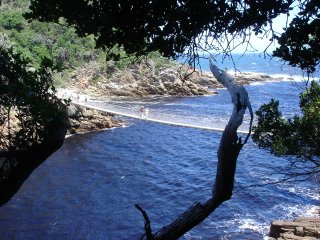
A beer and a cider and a bit of lunch at a café right on the rocks and we were revived to explore the long white sand beaches and rocky coves. On the way back, we took a drive through the town of Plettenberg Bay.
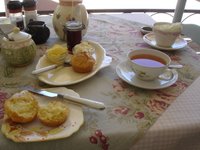 Dinner out in a restaurant – what a treat. We all dined in a seafood restaurant on the Knysna waterfront overlooking the wide lagoon. There’s always a curry on the menu in South Africa and the seafood curry was superb - just nice to get away from meat. It was almost 10:00pm by the time we got back and Fernie and I changed rooms to one where we didn’t have to share a bathroom. So even though tonight was Larium night, I fell asleep immediately and had no nightmares. Maybe I’m getting immune to the side effects of the malaria drug.
Dinner out in a restaurant – what a treat. We all dined in a seafood restaurant on the Knysna waterfront overlooking the wide lagoon. There’s always a curry on the menu in South Africa and the seafood curry was superb - just nice to get away from meat. It was almost 10:00pm by the time we got back and Fernie and I changed rooms to one where we didn’t have to share a bathroom. So even though tonight was Larium night, I fell asleep immediately and had no nightmares. Maybe I’m getting immune to the side effects of the malaria drug.
November 7, 2006 – Tuesday
 Our third night in Knysna. The world famous Garden Route runs from about Tsitsikamma National Park in the northeast to George in the west. It is so named for the fertile, lush tropical foliage and beautiful ocean beaches bordered by the statuesque Outenqua Mountains. In early spring – four weeks or so before we got there – it’s ablaze with wildflowers.
Our third night in Knysna. The world famous Garden Route runs from about Tsitsikamma National Park in the northeast to George in the west. It is so named for the fertile, lush tropical foliage and beautiful ocean beaches bordered by the statuesque Outenqua Mountains. In early spring – four weeks or so before we got there – it’s ablaze with wildflowers.
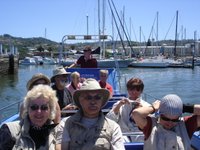 We explored Knysna today starting with a boat ride in the Drifters twelve passenger wide bottom ski boat. We were lucky that the weather cooperated and the seas were fairly calm because they can’t get out of the lagoon when it’s too windy. The narrow channel between ‘The Heads’ is treacherous. We found lots of dolphins but our search for whales was a bust. It was a great ride though slapping across the wide swells of the open Indian Ocean.
We explored Knysna today starting with a boat ride in the Drifters twelve passenger wide bottom ski boat. We were lucky that the weather cooperated and the seas were fairly calm because they can’t get out of the lagoon when it’s too windy. The narrow channel between ‘The Heads’ is treacherous. We found lots of dolphins but our search for whales was a bust. It was a great ride though slapping across the wide swells of the open Indian Ocean.
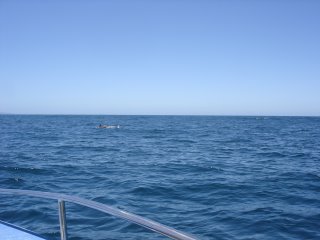
Fernie played sous chef for the last time assisting with the South African version of ‘bangers and mash’, one more high cholesterol meal – tasty though.
November 8, 2006 - Wednesday
The days have been flying by – active, exploratory and fulfilling days. I can’t wait for the next adventure and greet each day with eagerness and excitement.
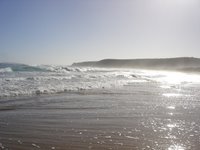 Plettenburg Bay, Knysna, George, Mossel Bay and all the other picturesque towns on the spectacular Garden Route are retirement communities primarily and tourist destinations because of the extensive white sand beaches. Today is our longest driving day and we were on the road at 6:00am grabbing a boxed breakfast to eat enroute. I was pensive as we traveled and mulled over the adventure holiday that we embarked on. It surpassed my expectations mostly and I felt we coped well with the sharing of facilities. Unlike the first day when the truck was full of excited chatter, everyone was quiet but in a comfortable and companiable way.
Plettenburg Bay, Knysna, George, Mossel Bay and all the other picturesque towns on the spectacular Garden Route are retirement communities primarily and tourist destinations because of the extensive white sand beaches. Today is our longest driving day and we were on the road at 6:00am grabbing a boxed breakfast to eat enroute. I was pensive as we traveled and mulled over the adventure holiday that we embarked on. It surpassed my expectations mostly and I felt we coped well with the sharing of facilities. Unlike the first day when the truck was full of excited chatter, everyone was quiet but in a comfortable and companiable way.
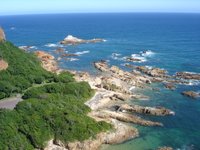 We detoured off the N2 to the consternation of some of the passengers who were starting to complain about rocky roads but it was pure pleasure for us. The bumpy and dusty roads don’t annoy us, they offer the opportunity of seeing the country unfettered by signs and commercialism. Endless farms in rolling land – wheat fields, some already harvested, sheep everywhere and also cattle. Our intended destination was DeHoop (pronounced de werp) Nature Preserve stretched along the shores of the Indian Ocean. Baboons scampered about through the fynbos (hardy vegetation only found in the dune areas of South Africa). Bontebok could be seen in the distance, but the dunes themselves were the draw – whiter than white sand looking like snow from a distance, stretching for miles. We hiked down to a cove to enjoy some beachcombing and whale watching. The whales were out quite far though. With the day being the longest travel day, every chance of a walk was embraced.
We detoured off the N2 to the consternation of some of the passengers who were starting to complain about rocky roads but it was pure pleasure for us. The bumpy and dusty roads don’t annoy us, they offer the opportunity of seeing the country unfettered by signs and commercialism. Endless farms in rolling land – wheat fields, some already harvested, sheep everywhere and also cattle. Our intended destination was DeHoop (pronounced de werp) Nature Preserve stretched along the shores of the Indian Ocean. Baboons scampered about through the fynbos (hardy vegetation only found in the dune areas of South Africa). Bontebok could be seen in the distance, but the dunes themselves were the draw – whiter than white sand looking like snow from a distance, stretching for miles. We hiked down to a cove to enjoy some beachcombing and whale watching. The whales were out quite far though. With the day being the longest travel day, every chance of a walk was embraced.
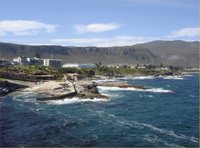 The small coastal town of Hermanus, only two hours east of Cape Town is renowned for whale watching. The ocean tumbles and boils over the rocks on the rocky headland, the wind whipping up a froth of whitecaps. It made it difficult to discern the whales at first but then suddenly a mass of flesh breeched directly in front of us only meters from the shore and it continued to put on a show as it slowly transited across the bay.
The small coastal town of Hermanus, only two hours east of Cape Town is renowned for whale watching. The ocean tumbles and boils over the rocks on the rocky headland, the wind whipping up a froth of whitecaps. It made it difficult to discern the whales at first but then suddenly a mass of flesh breeched directly in front of us only meters from the shore and it continued to put on a show as it slowly transited across the bay.
We hugged the coast line of the jade green waters of False Bay on a winding highway carved into the sides of the rugged mountains that hug the shore – reminiscent of the Big Sur in California. The sun shone brightly from clear blue skies but the wind was gale-force as I sat up in the cab with Dorran for the last leg into Cape Town. Sheets of salty spray sailed across the choppy sea steered by the keen wind. The truck was solid and stable though and the gusts didn’t seem to affect it – thank goodness.
Shantytowns proliferate on the N2 freeway leading into Cape Town. These squatter hovels constructed of any available bit of material they can get their hands on are usually topped with flapping black plastic to keep the rain out. Groups of children played soccer and other games on the grassy verge beside the freeway amongst the seldom-removed litter only inches from the speeding traffic. With a speed limit of 120 kph, it would seem impossible to cross the freeway on foot, but thousands climb the medians and dodge through the thick traffic, not all making it to the other side. The carnage is shockingly high.
The facts of life in a black South African’s life are shocking. There’s a rape every sixty seconds – often little girls ruined for life after; a murder every 29 minutes in the urban areas particularly Johannesburg; AIDS decimating the poor population and a total lack of education. Out of a 50 million total population, 40 million are black and the vast proportion of blacks live in townships and the deplorable conditions of the surrounding squatter camps. There is supposed to be mandatory primary education but where are the schools for the millions in the shantytowns. It seems an impossible task to eradicate the poverty and educate the masses.
I’m confused about the distinction between ‘Black’ and ‘Coloured’ people in South Africa. It seems that ‘Coloured’ have become their own sect and have garnered a higher level of respect from the ‘whites’. Service jobs in the Cape area are mostly held by ‘coloureds’. It’s a fine distinction and one that I’m definitely confused by. I did notice though that shopkeepers and restaurant servers were articulate and refined in manner while their skin was a lovely mocha colour. Does it hark back to the days where the ratio of white blood to black blood denoted position in the hierarchy? I noticed that most of the black and coloured shopkeepers and inn workers spoke in modulated tones and smiled shyly. Is this behavior taught by and expected by the whites of South Africa? Have they been intimidated into this submission? It’s all too much to grasp by our tolerant Canadian minds.
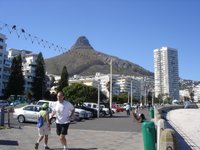 Cape Town is ranked as one of the five most beautiful cities in the world and it upheld its reputation. With Table Mountain as its backdrop and its oozing ‘tablecloth’ of cloud hovering over the sparkling city and the ocean hugging it on three sides, there can’t be a more beautiful setting. Sea Point, just ten minutes around the coastal corner from the city core, is a fairly safe community of hotels and condos, shops and restaurants and that’s where the Drifters Inn is located, just a half block from the seafront.
Cape Town is ranked as one of the five most beautiful cities in the world and it upheld its reputation. With Table Mountain as its backdrop and its oozing ‘tablecloth’ of cloud hovering over the sparkling city and the ocean hugging it on three sides, there can’t be a more beautiful setting. Sea Point, just ten minutes around the coastal corner from the city core, is a fairly safe community of hotels and condos, shops and restaurants and that’s where the Drifters Inn is located, just a half block from the seafront.
 Nicole, a statuesque German blonde has been running that inn for six years. After coming to South Africa to visit her uncle, she loved it so much that she stayed. We were assigned a small but comfortable room on the second floor with its own bathroom. YEAH! Downstairs, there’s a lovely old sitting room/library ringed with big comfy leather sofas and chairs. Beside it is the dining room set beautifully with china and linen and just outside is a patio where we’d sit and enjoy a convivial drink.
Nicole, a statuesque German blonde has been running that inn for six years. After coming to South Africa to visit her uncle, she loved it so much that she stayed. We were assigned a small but comfortable room on the second floor with its own bathroom. YEAH! Downstairs, there’s a lovely old sitting room/library ringed with big comfy leather sofas and chairs. Beside it is the dining room set beautifully with china and linen and just outside is a patio where we’d sit and enjoy a convivial drink.
November 9, 2006 – Thursday
I woke up singing that old Beatles song “When I’m 64”. I never thought I’d reach such a ripe old age when I first heard it forty years ago and here I am feeling no older than I did then.
 We’re not on our own yet – we still have Dorran for two more days until 4pm tomorrow. Of course, we could elect to head off by ourselves if we want and a few did but there was a wonderful planned day in store so we hung in.. With plans to hike up Table Mountain and take the cable car down after, we were disappointed that the wind was so high up top that it was closed. I guess we could have hiked up but we’d have to walk down too which would have eaten up too much time. However, Table Mountain was more glorious than usual with its tablecloth of cloud coating it like seeping dry ice at a rock concert.
We’re not on our own yet – we still have Dorran for two more days until 4pm tomorrow. Of course, we could elect to head off by ourselves if we want and a few did but there was a wonderful planned day in store so we hung in.. With plans to hike up Table Mountain and take the cable car down after, we were disappointed that the wind was so high up top that it was closed. I guess we could have hiked up but we’d have to walk down too which would have eaten up too much time. However, Table Mountain was more glorious than usual with its tablecloth of cloud coating it like seeping dry ice at a rock concert.
 With a little extra time, we stopped at Hout Bay for a stroll and we mooched around the markets there. I told myself that I wasn’t going to buy any tourist trash but I weakened and bought a painted ostrich egg when I found out part of the profits was going to an ecological cause, the seal rescue. Fernie bought me a pair of originally crafted copper earrings for my birthday – they’re gorgeous and I wore them the rest of the day even though they looked a bit out of place with my scruffy clothing.
With a little extra time, we stopped at Hout Bay for a stroll and we mooched around the markets there. I told myself that I wasn’t going to buy any tourist trash but I weakened and bought a painted ostrich egg when I found out part of the profits was going to an ecological cause, the seal rescue. Fernie bought me a pair of originally crafted copper earrings for my birthday – they’re gorgeous and I wore them the rest of the day even though they looked a bit out of place with my scruffy clothing.
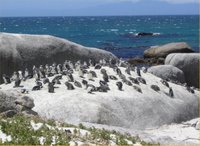 The South African penguins are a tiny species and they choose to abide in a tiny cove, Boulders Beach, south of Simonstown on False Bay, on the eastern coast of the Cape Peninsula. The trouble is they don’t stay down at the beach but wander uphill crossing the highway to end up as road kill. We spent a bit of amused time watching the little darlings mosey around like wind-up toys.
The South African penguins are a tiny species and they choose to abide in a tiny cove, Boulders Beach, south of Simonstown on False Bay, on the eastern coast of the Cape Peninsula. The trouble is they don’t stay down at the beach but wander uphill crossing the highway to end up as road kill. We spent a bit of amused time watching the little darlings mosey around like wind-up toys.
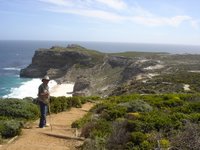 Table Mountain National Park is at the southern end of the peninsula and the endemic fynbos is protected and beautiful as it covers the moors and slopes down to the sea. Dorran parked the truck at Cape Point and we walked up, rather than take the funicular, to the lighthouse. The view was spectacular overlooking the Cape of Good Hope a couple of kilometers to the west. We had the choice of driving over with Dorran or hiking across the rocky and windy headland and being picked up at the bottom, at the Cape of Good Hope.
Table Mountain National Park is at the southern end of the peninsula and the endemic fynbos is protected and beautiful as it covers the moors and slopes down to the sea. Dorran parked the truck at Cape Point and we walked up, rather than take the funicular, to the lighthouse. The view was spectacular overlooking the Cape of Good Hope a couple of kilometers to the west. We had the choice of driving over with Dorran or hiking across the rocky and windy headland and being picked up at the bottom, at the Cape of Good Hope.
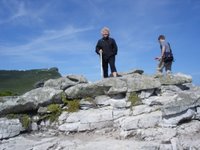 We grabbed a couple of takeout sandwiches, our walking sticks and headed off, just the two of us across the blustery cape – it was awe-inspiring but there were moments I thought the wind would carry us away. The actual most southerly point of Africa is 50 or more kilometers east at Cape Agulhas but it is not anywhere near as dramatic as here.
We grabbed a couple of takeout sandwiches, our walking sticks and headed off, just the two of us across the blustery cape – it was awe-inspiring but there were moments I thought the wind would carry us away. The actual most southerly point of Africa is 50 or more kilometers east at Cape Agulhas but it is not anywhere near as dramatic as here. 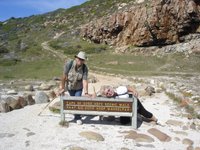 We sat on the rocks high above secluded sandy coves munching our sandwiches and agreed that ‘Life ain’t at all bad’. The worst part of the trail was the last 500 meters down a steep and narrow rocky path. I concentrated only on my next step because otherwise all I could see was the rocks and ocean below, which gave me a bit of vertigo.
We sat on the rocks high above secluded sandy coves munching our sandwiches and agreed that ‘Life ain’t at all bad’. The worst part of the trail was the last 500 meters down a steep and narrow rocky path. I concentrated only on my next step because otherwise all I could see was the rocks and ocean below, which gave me a bit of vertigo.
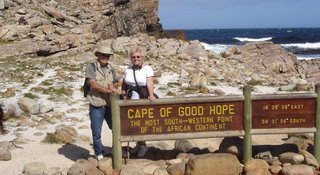
The winelands of Constantia sit on the north end of the peninsula just south of Cape Town. We didn’t stop but drove through the stunning green hills twisting through the vineyards – my mouth was salivating at the thought of some wine tastings – Tomorrow!
What a great day we had – I want to bottle that feeling!
It was time for the group’s last dinner together so we all jumped on the public bus which runs along the oceanfront around the corner to the Victoria and Alfred (I always thought is was Albert) Waterfront which is a reclaimed wharf area now teeming with hotels, restaurants, shops and tourist attractions. Masses of tourists and daytrippers crammed the area and after spending so many days with just the wonders of nature, I was horrified by the crass behaviour of the loud and obnoxious sightseers.
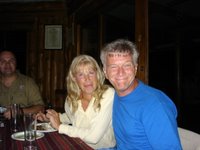 Quay 4 was a lovely seafood restaurant right on the seafront. We sat at a round table with our favourites, Christie and Lane, Jean and Andre and Dorran while the rest were at a long table beside us. A martini to start and a superb Cabernet accompanied my seared tuna – Yummy! I was secretly enjoying my 64th birthday - - - or so I thought. Jean passed me a parcel wrapped in tissue and raffia with a card signed by the whole gang. I was glad the lights were dim because the combination of the fabulous day, the martini, the new friends and Jean’s thoughtfulness brought tears to my eyes. Could anyone ask for a better 64th birthday?
Quay 4 was a lovely seafood restaurant right on the seafront. We sat at a round table with our favourites, Christie and Lane, Jean and Andre and Dorran while the rest were at a long table beside us. A martini to start and a superb Cabernet accompanied my seared tuna – Yummy! I was secretly enjoying my 64th birthday - - - or so I thought. Jean passed me a parcel wrapped in tissue and raffia with a card signed by the whole gang. I was glad the lights were dim because the combination of the fabulous day, the martini, the new friends and Jean’s thoughtfulness brought tears to my eyes. Could anyone ask for a better 64th birthday?
November 10, 2006 – Friday
Things are winding down now – this is our last day with the group. Two of them elected to skip our proposed wine tour to Stellenbosch – not us!
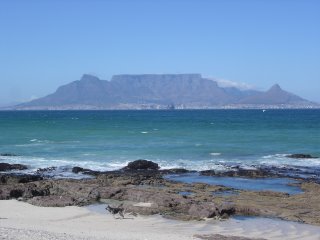
Before heading off to the winelands, we took a drive around Table Bay as far as Tableview – aptly named for its picture postcard view of Cape Town and Table Mountain. There are so many gorgeous and affordable seafront properties – it would be a tempting place to buy and live if we could overlook the poverty, crime and politics – but we couldn’t.
Morgenhof Wineries is one of the oldest in the Stellenbosch area and have vast underground cellars filled with French Oak casks. The tastings were very generous and I didn’t spit or pour out – I drank the lot – the sign of a true WINO! We sampled a Rose, a Sauvignon Blanc, a Cabernet and their Premiere Red finishing off with a late harvest. The Cabernet was superlative so I bought a bottle for Jean and Andre who sadly missed the day. Jean had to go back to hospital to have a cast put on her broken wrist.
 We visited a Raptor Rehab Centre in the afternoon where we had some interaction with falcons, owls, eagles and kites. One of the fellows who runs the facility put on a display of each bird’s skills. I wandered over to a bench and no sooner had I sat down but a falcon landed on my head,
We visited a Raptor Rehab Centre in the afternoon where we had some interaction with falcons, owls, eagles and kites. One of the fellows who runs the facility put on a display of each bird’s skills. I wandered over to a bench and no sooner had I sat down but a falcon landed on my head, 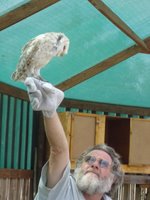 hoping for some food I guess. But I felt quite silly sitting there with a bird on my head. A cheetah rehab compound sat beside the raptor centre and we wandered through but apparently they weren’t going to be reintroduced to the wild and they were being bred in captivity and I didn’t understand why - so we didn’t give it our attention.
hoping for some food I guess. But I felt quite silly sitting there with a bird on my head. A cheetah rehab compound sat beside the raptor centre and we wandered through but apparently they weren’t going to be reintroduced to the wild and they were being bred in captivity and I didn’t understand why - so we didn’t give it our attention.
I nicely asked the German women to vacate the front seat beside Dorran. They had been up there for two days and I wanted to sit up front for the last hour of our expedition. Such complaints ensued.
“I have a chest cold” said one and pointed to her throat wrapped in a scarf (in 25 degree weather). “I can’t ride in the back where the windows will be open”.
Whine and complain, that’s all they did. I guess the eighteen days of togetherness has been a bit too much – the natives are restless. After severely pointing out that we all must cooperate and we take turns, they finally gave in when I snapped “If you insist on riding up there, I can’t forcibly remove you”, and I threw up my arms in dramatic disgust as I climbed into the back of the truck. I guess I made them feel guilty because with that they moved to the back – what a damned fuss!
I did enjoy the last hour chatting to Dorran as we drove back to Seapoint – Fernie prefered to stay in the back and snooze. I was full of mixed feelings – happy that F&I would be on our own now – sad that we were leaving some of our fellow passengers and Dorran – happy to be planning future expeditions - sad that the wonderful journey in the ‘Jolly Green Giant’ was over.
We spent an hour repacking our bags when we got back to the inn, so that we’d live out of the single smaller suitcase for the next week. We then headed down to the patio for a glass of wine and beer. Dorran still hadn’t left for Johannesburg and he said “I just got two bits of bad news”. We urged him to continue. “Jean has gone back into surgery – they had to replace the pins” he seemed so worried about her. “…..and, they’ve cancelled my days off between trips, so when I get back to Johannesburg, I do an immediate turn around with a brand new group”. So after eighteen days of sixteen hours each, he has to drive two days back to Johannesburg and immediately repeat the same journey – I don’t know how the guides don’t burn out but I guess they probably do.
Christie and Lane were flying home that night so we joined them for dinner at the Spur, a hamburger joint across the road from the inn. Exhausted, we said our goodbyes, promised to email each other and we had an early night.
November 11, 2006 - Saturday
Andre was down for breakfast and he filled us in on Jean’s condition. She was kept in hospital overnight but he was going to pick her up soon. One of the bridge women, the aggravating one, sat down with us too and started nitpicking – she’s like a dog with a bone. I asked her to desist but she wouldn’t shut up; I then suggested she move to another table, which she wouldn’t, so we ignored her and then excused ourselves. She was one that we could have done without.
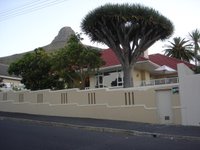
The Drifters Inn was overbooked so Nicole moved us to a B&B several blocks away – Sundown Manor. It was a definite upgrade – a lovely large room with king sized bed, huge shower and all the amenities and the house and grounds were beautiful. The move was done quickly as we were being picked up for a ‘Township Tour’ at 8:30.
There were seven others on the tour and Sean, the tour driver. The others were all young – in their twenties, I’d guess. It was a fulfilling experience – very moving and I think it should be mandatory for everyone that visits South Africa. The townships of displaced blacks started when the Group Areas Act, passed in the 1950s, prohibited Blacks from living in the cities. However, the true beginnings were in 1901 when Bubonic plague hit and blacks were considered carriers of the disease and therefore resettled away from the white population. Then in 1918, as a result of the Spanish flu, blacks were once again segregated to separate compounds.
District 6, a central area of Cape Town was a lively black and coloured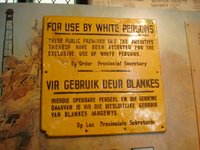 community in 1960 when it was decided they should all be forcibly removed and relocated to the Cape Flats, thirty kilometers away so that ‘white folks’ could build and reside there. So the ages old homes were razed but somehow it never got redeveloped. It stands now as mostly vacant land and they are building a few small homes for some of the displaced persons. However, most of them are dead or too old now. The bare land stands as a stark reminder of the atrocity. Just a few blocks down the road, the old Methodist church has been turned into The District 6 Museum chronicling those awful times. Most moving is a huge scroll inscribed by the affected, articulately expressing how it felt to be considered less than a person.
community in 1960 when it was decided they should all be forcibly removed and relocated to the Cape Flats, thirty kilometers away so that ‘white folks’ could build and reside there. So the ages old homes were razed but somehow it never got redeveloped. It stands now as mostly vacant land and they are building a few small homes for some of the displaced persons. However, most of them are dead or too old now. The bare land stands as a stark reminder of the atrocity. Just a few blocks down the road, the old Methodist church has been turned into The District 6 Museum chronicling those awful times. Most moving is a huge scroll inscribed by the affected, articulately expressing how it felt to be considered less than a person.
Our next visit was to the Langa (meaning ‘sun’) Township, one of the oldest in the area. The residents are squashed into mostly squalid conditions. A township is made up of government built projects, prefab shacks and squatter huts thrown up by the newer arrivals who don’t qualify for anything. The squatter shacks are made of old bits of wood, plastic and whatever they can scrounge or steal. They are lucky if they have six-foot square of space, extremely fortunate if there’s an outhouse not too far away and if they have electricity, they’re the upper echelon. There’s a long list for RDP (Reconstruction and Development Programme) houses and it gets longer every day.
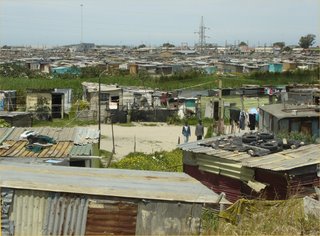
Alongside the townships, an empty tract of land (the bush) is kept for ‘the initiation process’ of young men 16 to 18 years of age, much as traditionally happened in the wild tribal days. The boys are sent out, usually roughly circumcised without anesthetic, allowed only a loin cloth and must stay out there for a pre-determined time. The ‘bush’ beside the Langa Township is right beside the N2 freeway and we spied what looked to be rough shelters made of newspapers here and there.
In 2003, Sean drove Oprah to Langa – or say he says. It was there that she offered to pay the wages of all teachers for one year to focus the residents on education. Apparently, she continues her support and has enlisted several other large corporations to donate
Each township is a functioning community with entrepreneurial businesses run out of their sordid little shacks. There’s a proliferation of one type of business and that’s hairdressers – with fancy names such as ‘Ebony Coiffures’. No matter how poor, a black woman must have her hair looking good.
We were taken to a drinking establishment, a shebeen - an illicit beer hall, the name taken from the Irish apparently. A dark dirt-floored hovel greeted us. We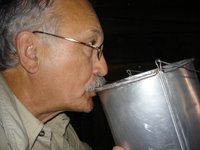 were ushered in to sit on battered wooden benches, hardly room to fit us all. The two women brought a galvanized pail of foaming home-brewed ale and placed it on the floor in the centre of the room and we were all asked to take a drink right out of the pail. Fernie started and I, next, first of all said ‘No thank you’ but was convinced to try it. It was a sour, foamy and quite nasty brew – Yuck! I prayed I wouldn’t get sick from it. The town men pay either six or nine rand and for that they can drink as much as they want all day up until either 6pm or 9pm. How sad their lives are if they choose to sit all day in that dim and musty pit sloshing down that disgusting potion.
were ushered in to sit on battered wooden benches, hardly room to fit us all. The two women brought a galvanized pail of foaming home-brewed ale and placed it on the floor in the centre of the room and we were all asked to take a drink right out of the pail. Fernie started and I, next, first of all said ‘No thank you’ but was convinced to try it. It was a sour, foamy and quite nasty brew – Yuck! I prayed I wouldn’t get sick from it. The town men pay either six or nine rand and for that they can drink as much as they want all day up until either 6pm or 9pm. How sad their lives are if they choose to sit all day in that dim and musty pit sloshing down that disgusting potion.
 Sheep’s heads – a delicacy? No I think it’s because they get them very cheaply or maybe for nothing from the abattoir. A small fierce-looking woman, her face and arms smeared grotesquely with calamine lotion threw the heads onto a large grill with leaping flames which burned off the wool and cooked the little bits of flesh on the skull. Tongues are the favoured bit, but all gets used including the eyeballs.
Sheep’s heads – a delicacy? No I think it’s because they get them very cheaply or maybe for nothing from the abattoir. A small fierce-looking woman, her face and arms smeared grotesquely with calamine lotion threw the heads onto a large grill with leaping flames which burned off the wool and cooked the little bits of flesh on the skull. Tongues are the favoured bit, but all gets used including the eyeballs.
An elementary school had been set up in several brightly painted shipping containers – no windows – no electricity – how on earth could they see inside? We weren’t shown. South African law states that all children must go to school but how is that possible in some of the rural townships where schools don’t exist. Their chances of education are at least better in the urban environment.
Quite a few years ago, a young woman arrived in Cape Town without education or money and she ended up in the largest (1.5 million population) township in the Cape Town area, Khayelitsha (meaning ‘new home’). A surprisingly eloquent woman, Rosie now has two children of her own (19 and 21 years old) and she’s well-known for the soup kitchen for children that she started out of her home with the help of personal donations and corporate help. Her house was a proper brick structure with appliances and comfortable furniture. Her garish and ostentatious sofa and chair were tightly covered in thick clear plastic – which did double duty, it protected the fabric from soil and wear while showing the ‘beauty’ of the colour and design. Our driver Sean loved Rosie and said several times that he wished his wife was more like her. Dressed in blue jeans, she stood elegantly in her living room, while we sat on her plastic covered sofa and told us about her soup kitchen and her life in the Mikasa area of Khayelitsha. We were pleased to donate to the cause – actually personally felt it mandatory.
A surprisingly eloquent woman, Rosie now has two children of her own (19 and 21 years old) and she’s well-known for the soup kitchen for children that she started out of her home with the help of personal donations and corporate help. Her house was a proper brick structure with appliances and comfortable furniture. Her garish and ostentatious sofa and chair were tightly covered in thick clear plastic – which did double duty, it protected the fabric from soil and wear while showing the ‘beauty’ of the colour and design. Our driver Sean loved Rosie and said several times that he wished his wife was more like her. Dressed in blue jeans, she stood elegantly in her living room, while we sat on her plastic covered sofa and told us about her soup kitchen and her life in the Mikasa area of Khayelitsha. We were pleased to donate to the cause – actually personally felt it mandatory.
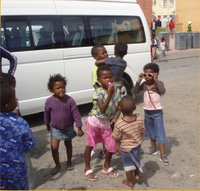 Wherever we went in the township, the little children horded around us like hungry dogs. They were shiny clean, their clothes sparkling as if they were in a Tide commercial. There’s a lot of pride in the community.
Wherever we went in the township, the little children horded around us like hungry dogs. They were shiny clean, their clothes sparkling as if they were in a Tide commercial. There’s a lot of pride in the community.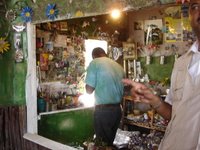 Next, a recycling entrepreneurship – a man uses tin cans to make colourful flowers. He demonstrated how he used very basic tools to make a flower out of a Coca-Cola can in just a few minutes. I had to buy one – a daisy for 15 rand ($2.50 Cdn).
Next, a recycling entrepreneurship – a man uses tin cans to make colourful flowers. He demonstrated how he used very basic tools to make a flower out of a Coca-Cola can in just a few minutes. I had to buy one – a daisy for 15 rand ($2.50 Cdn).
Betsy, a garrulous young woman from Colorado (rare to meet Americans traveling away from 5* hotels – mostly Germans, French, Belgian, Dutch and Canadians – strangely didn’t meet any Australians) was visiting Cape Town on business but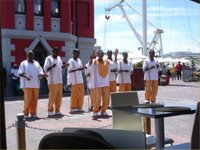 found time to sightsee. She’s on the Paralympic Committee. We chatted while on the township tour and she said she was unable to get a ticket for Robben Island – totally booked. We had reserved tickets several days earlier and suggested that she see if there were any last-minute cancellations. So she got off with us at the V&A Waterfront and joined us for lunch at a Pannekoek café on the patio with circulating buskers entertaining us. I had a pancake wrapped Bobotie – the spicy Malay/South African dish which was quite memorable. There were no cancellations for Robben Island initially but just as we were boarding the ferry, along came Betsy waving a ticket, happy as could be.
found time to sightsee. She’s on the Paralympic Committee. We chatted while on the township tour and she said she was unable to get a ticket for Robben Island – totally booked. We had reserved tickets several days earlier and suggested that she see if there were any last-minute cancellations. So she got off with us at the V&A Waterfront and joined us for lunch at a Pannekoek café on the patio with circulating buskers entertaining us. I had a pancake wrapped Bobotie – the spicy Malay/South African dish which was quite memorable. There were no cancellations for Robben Island initially but just as we were boarding the ferry, along came Betsy waving a ticket, happy as could be.
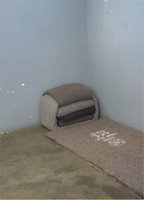
 Robben Island lies just outside Table Bay and the crossing is just 35 minutes. It was hot and windless on the top deck and we enjoyed the calm crossing. Nelson Mandela and many other political activists were imprisoned on the island for so many years but at the outset it was used in the very early days as a compound for domestic animals – cows and sheep, and then for the incarceration of naughty sailors. All tours on the island are on buses between the buildings. It’s a World Heritage Site that is being tightly protected from the ravages of tourism. The guides were apparently all ex-cons formerly imprisoned there so their stories were accurate and poignant. The groups were much too large though and the opportunity of one-on-one conversations with them was impossible.
Robben Island lies just outside Table Bay and the crossing is just 35 minutes. It was hot and windless on the top deck and we enjoyed the calm crossing. Nelson Mandela and many other political activists were imprisoned on the island for so many years but at the outset it was used in the very early days as a compound for domestic animals – cows and sheep, and then for the incarceration of naughty sailors. All tours on the island are on buses between the buildings. It’s a World Heritage Site that is being tightly protected from the ravages of tourism. The guides were apparently all ex-cons formerly imprisoned there so their stories were accurate and poignant. The groups were much too large though and the opportunity of one-on-one conversations with them was impossible.
A prison - is a prison - is a prison! It seems to me there’s not much difference between them (we could easily be in Alcatraz) only the reasons for imprisonment and the unfair treatment that blacks and coloureds received. The designation of being ‘coloured’ covers blacks with whites, blacks with Indians, blacks with the aboriginal San and Khoisan but they get lumped under the one term ‘coloured’ and were segregated from the blacks and the whites. The ‘Cape Coloured’ were whites with San or Khoisan, the African bushmen. The San were the hunter-gatherers while the Khoisan were the herders. They both originally spoke with the ‘click’ sound in their language.
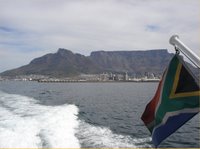
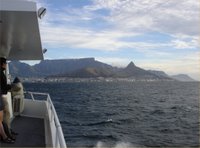 What a change in the sea for our return journey – windy and wild, chopping the waters and making for a blustery and cold ride. We dug out our windbreakers and put the hoods up to protect us from the cold and spray. Almost 7pm by then, we waved goodbye to Betsy and stopped for a quick dinner of kingclip and calamari before catching the bus back to Sea Point. We got off at the wrong stop for our new hotel and had to walk quite a way. We were exhausted when we finally arrived.
What a change in the sea for our return journey – windy and wild, chopping the waters and making for a blustery and cold ride. We dug out our windbreakers and put the hoods up to protect us from the cold and spray. Almost 7pm by then, we waved goodbye to Betsy and stopped for a quick dinner of kingclip and calamari before catching the bus back to Sea Point. We got off at the wrong stop for our new hotel and had to walk quite a way. We were exhausted when we finally arrived.
Andre and Jean had also been moved to the same B&B but they were out to dinner when we got there so I put the bottle of Cabernet that I bought for them at Morgenhof, on their doorknob. I hope they got it ok as they left for the airport before we got up next morning.
November 12, 2006 – Sunday
What a wonderful sleep we had in that enveloping king-sized bed with the crisp white linens. Breakfast was served on the patio overlooking the swimming pool and we chatted to Gary the 45ish owner. He and his wife and two children were from Zimbabwe and had owned a farm there. The farm was confiscated by the Mugabe government and not $1 was given to them. Obviously by the lovely hotel they owned in Capetown, they had been aware and prepared by hiding money out of the country. I guess they were lucky not to have been shot and burned out as happened to many white farmers there.
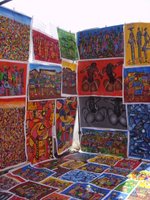
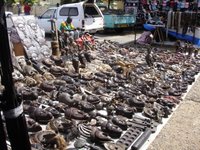 We walked from Sea Point to Green Point for the massive weekend marketplace running for about a kilometer on the Green Point parkland. Fernie had one thing in mind – he wanted an African tablecloth for our dining room table. With the new culinary skills gleaned from his apprenticeship with Dorran and his keen interest in ‘crockpot cookery’ he’s becoming quite the domestic man and I’m terrifically pleased. We couldn’t find a three meter tablecloth so ended up with two – two meter ones which we’ll overlap.
We walked from Sea Point to Green Point for the massive weekend marketplace running for about a kilometer on the Green Point parkland. Fernie had one thing in mind – he wanted an African tablecloth for our dining room table. With the new culinary skills gleaned from his apprenticeship with Dorran and his keen interest in ‘crockpot cookery’ he’s becoming quite the domestic man and I’m terrifically pleased. We couldn’t find a three meter tablecloth so ended up with two – two meter ones which we’ll overlap.

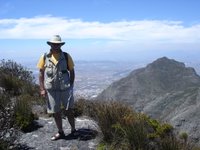 We were more than half way to the V&A Waterfront by this time so we carried on – on foot. We’d received Cape Town Passes delivered to our hotel. The passes covered many tourist attractions, activities and tours and the ‘Hop-on-Hop-off bus”, an open topped double decker with a guide who gave a narrated tour of the city. We hopped off at Table Mountain and finally the cable car was open – the winds moderate and no cloud tablecloth – it was clear as a bell. At the top, it is as flat as it appears from below and it’s been developed into some wonderful walks. The 360 degrees of views were phenomenal – from the city centre right to Cape Point and we spent a couple of hours exploring the trails before descending and ‘hopping on’ the bus again. We didn’t have time for any museums – the day flew by – but we did ‘hop in’ to the aquarium. It wasn’t a patch on the one in Durban though.
We were more than half way to the V&A Waterfront by this time so we carried on – on foot. We’d received Cape Town Passes delivered to our hotel. The passes covered many tourist attractions, activities and tours and the ‘Hop-on-Hop-off bus”, an open topped double decker with a guide who gave a narrated tour of the city. We hopped off at Table Mountain and finally the cable car was open – the winds moderate and no cloud tablecloth – it was clear as a bell. At the top, it is as flat as it appears from below and it’s been developed into some wonderful walks. The 360 degrees of views were phenomenal – from the city centre right to Cape Point and we spent a couple of hours exploring the trails before descending and ‘hopping on’ the bus again. We didn’t have time for any museums – the day flew by – but we did ‘hop in’ to the aquarium. It wasn’t a patch on the one in Durban though.
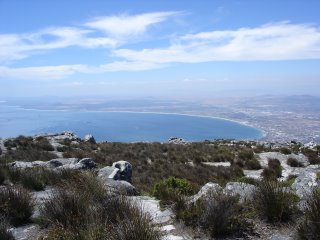
While briskly walking through Sea Point later on, we encountered a tall and stately, elderly (70+ish) gentlemen sporting a handlebar moustache. He greeted us with a barked
“Are you part of the Irish walking tour?”. He obviously had an interest in walking because he carried a worn and bent walking stick.
”No, we’re on our own” I answered, wondering at his question.
”Well, you certainly look Irish and you have a lovely lilt to your voice” he said to me flirtatiously, ignoring Fernie. He spoke in an upper crust English accent – or so I thought.
”Where are you from?” I asked in friendliness.
”Rhodesia” he barked, straightening his bent spine as if he’d been a military man.
”Zimbabwe?” I replied.
”Rhodesia” he determinedly answered “It will always be Rhodesia” and then he carried on an oratory about the previous Ian Smith government and the current Mugabe regime. “…..and the natives thought it would get better with Mugabe” he bellowed “Hrmph!”
Another seafood dinner at the Ocean Basket a couple of blocks from our hotel was fabulous – mussels, calamari and baby kingclip. Our tiny server’s name was Adelaide and she sparkled with happiness and charm – she so reminded us of our daughter-in-law, Janet. Fernie, as was I, was totally taken with her
”So you’re a Zulu?” Fernie asked her after hearing an adolescent boy at a neighbouring table ask her.
”Yes – I am a Zulu” she proudly rose to her full five foot of height. “You were listening…”
She told us she was a student studying at university “Accounting” she said proudly, obviously full of ambition and enthusiasm.
November 13, 2006 – Monday
6:00am What a Godforsaken time to have a flight. It meant having to get up by 3:30am for pickup at 4. But we were up battling hordes of mosquitoes that invaded our room from 1:00am. Why don’t south Africans have screens on their windows?
We were in Joberg or Jozie, as those that are familiar refer to their largest city, by 8:00am. We’d booked one overnight in the Drifters Inn and a tour of the city to become acquainted with it.
Mpho (pronounced Umpo), a charming and gentle young man (26) dressed in a black suit and tie, was our escort for the day. He lived in Soweto and regaled us with stories of his village (4.5 million live there – it’s mind boggling) as he drove us around. We didn’t see one white face as we drove street after street in the downtown core. Mpho said “I won’t take you to that area over there – that’s where the Nigerians live with their crime and their drugs and corruption – it’s very dangerous over there”.
“I take you to ‘Top of Africa’ now” he said “tallest building in all of Africa”. The Carleton Tower – 50 stories with a viewing area on the top floor was accessed through an underground parking lot and a shopping mall above.
”Why are the mannequins all white?” I asked, still not seeing a white face anywhere.
”I don’t know – I never noticed before” he answered.
I suggested that they should be painted black and he laughed uproariously, mentioning it again later and laughing heartily again. The view from the top was marred by the dark clouds quickly gathering over the city core but we got an idea how vast the city was.
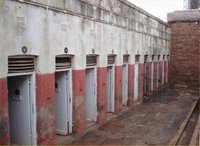 Constitution Hall, formerly the prison where Mahatma Gandhi and Nelson Mandela were held is now the Supreme Court but parts of the squalid prison are left intact as a memorial. While visiting it under the tutelage of a strong African woman with shaved head, deep voice and manly attire, thunder roared, lighting flashed and the heavens opened up. We got soaking wet as we ran for cover and it got suddenly very cold. We huddled in a depressing and dank cement room while the roar of the storm masked the audio of the film being shown of interviews with the excons. Luckily, subtitles were shown.
Constitution Hall, formerly the prison where Mahatma Gandhi and Nelson Mandela were held is now the Supreme Court but parts of the squalid prison are left intact as a memorial. While visiting it under the tutelage of a strong African woman with shaved head, deep voice and manly attire, thunder roared, lighting flashed and the heavens opened up. We got soaking wet as we ran for cover and it got suddenly very cold. We huddled in a depressing and dank cement room while the roar of the storm masked the audio of the film being shown of interviews with the excons. Luckily, subtitles were shown.
Storm over, we progressed to the Nelson Mandela Bridge and the Gandhi Memorial Square. So there wasn’t really too much to see but we got an overall impression of a city that’s seen better times – however, a good infrastructure and definitely not third world. More tales of his home life ensued and especially of his girlfriend who’s studying to be a doctor.
”We have a huge hospital in Soweto for all the people who get hurt – broken bones all the time” he said. That’s where she will work.
”And I want to have my own tour company with my own cars” he said ambitiously. Good luck to them all.
We didn’t expect to see Dorran again but his new tour was meeting that evening at the Drifters Inn. It was strange to see the new ones taking our places in ‘our’ truck. This was a much younger group – 20’s to 40’s I’d guess. He’ll have an easier time with them, I think. We had a quick chat with Dorran after we got back from dinner at an Indian restaurant just down the road and wished him all the best.
November 14, 2006 – Tuesday
 An early (but not too early) flight at 9:30am got us quickly to Victoria Falls in 1 ½ hours but the process came to a halt there at the Zimbabwean Immigration. There are three classes of countries when it comes to purchasing entry visas and Canada is in the most expensive class – I guess and I hope that Canada doesn’t show approval for the current regime. Some paid $25 US each; US citizens paid $50 US each; we were charged $65 US each. The trouble was they wouldn’t accept US travelers cheques, Visa or Mastercard, South African Rand, Canadian $ or even Zimbabwean $. It had to be paid in US cash. We only had $100 US cash – we were $30 short. Why weren’t we forewarned? We had a bad travel agent.
An early (but not too early) flight at 9:30am got us quickly to Victoria Falls in 1 ½ hours but the process came to a halt there at the Zimbabwean Immigration. There are three classes of countries when it comes to purchasing entry visas and Canada is in the most expensive class – I guess and I hope that Canada doesn’t show approval for the current regime. Some paid $25 US each; US citizens paid $50 US each; we were charged $65 US each. The trouble was they wouldn’t accept US travelers cheques, Visa or Mastercard, South African Rand, Canadian $ or even Zimbabwean $. It had to be paid in US cash. We only had $100 US cash – we were $30 short. Why weren’t we forewarned? We had a bad travel agent.
“What do we do now?” I asked the disinterested official, as the crowds behind us got impatient.
Initially, he just shrugged his shoulders then he said “Bank outside”. So I left Fernie and our passports behind at the immigration, asked the man in the exit kiosk permission and went out to the terminal bank.
”We can only give you Zimbabwean $ for your travelers cheques” I was told – that was totally useless and of course ATM’s only dispense Zimbabwean $ too. I explained my dilemma.
”Sorry, can’t help you.” chorused the bland faces. Back to immigration.
”What do I do now?” I asked, thinking my next step would be to go begging as if we were on The Amazing Race.
”Who’s picking you up?” he asked lazily not giving a damn whether we ever got into the country.
”Ilala Lodge” I said.
”Well, go ask them for money”
Out I went again leaving Fernie et al behind and looked for a sign from the Ilala Lodge. Finally I noticed a young woman waving a sign that said ‘Lock x 2’ and I said “That’s me!”
”Where the other one?” she questioned
I told the story all over again and asked her if she could lend me $30 US. She prattled to her young male partner/driver, Paka and he eventually pulled out his wallet and handed me $30 cash. I wanted to kiss him.
Thanking him profusely, I ran back to claim my husband, passports and luggage. But when it came to leaving the bonded area, a small man in a security uniform bawled me out for ‘leaving the area without his permission’.
”I asked that man in the kiosk” I said pointing to the guy in the box “He said OK”.
”He’s not security – you should have asked me” he stated officiously.
What I wanted to say at this point is unprintable and would have got us thrown out. Instead, I retold the story again, smiling and groveling while I really wanted to slap him across his insolent face. I guess I humbled myself sufficiently because he finally let us go.

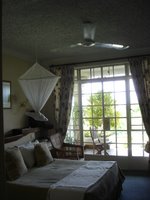 Sixteen kilometers to the hotel and what a charming little abode the Ilala Lodge is. We were ushered to a lovely cool, clean well-appointed room with a shady patio and shrubberies and a view of the misty spray emanating from the Falls. The Ilala is the closest hotel to the falls. A large circular mosquito net was ready to cover us in bed – no more 1am battles with the pesky insects.
Sixteen kilometers to the hotel and what a charming little abode the Ilala Lodge is. We were ushered to a lovely cool, clean well-appointed room with a shady patio and shrubberies and a view of the misty spray emanating from the Falls. The Ilala is the closest hotel to the falls. A large circular mosquito net was ready to cover us in bed – no more 1am battles with the pesky insects.
“Can I change $100 US travelers cheque to $100 US cash?” I asked at reception.
”No, sorry Ma’am – we are only allowed by law to give you Zimbabwean $”
I explained that I needed $30 US cash to repay Paka, the helpful guide who lent me money.
”Sorry, there’s nothing we can do.”
We were in a quandary.
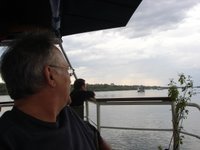
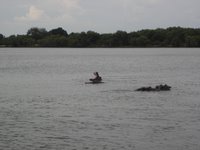 We had a tour included in our Ilala Lodge package, a sunset cruise on the Zambezi River and we were picked up at 4pm. It was on a pontoon boat with about 24 comfy directors chairs around six tables and a bar setup at the rear. All the wine / beer / sodas you could drink and they brought around platters of hors d’oeuvres while we slowly motored along the wide river. Some baby crocodiles snoozed on the riverbank as we nosed in for a closer look. Further along in the middle of the river, a large family of hippos were spotted. We cruised up very close and they were totally unperturbed by our intrusion, submerging, surfacing, yawning and bellowing to our delight.
We had a tour included in our Ilala Lodge package, a sunset cruise on the Zambezi River and we were picked up at 4pm. It was on a pontoon boat with about 24 comfy directors chairs around six tables and a bar setup at the rear. All the wine / beer / sodas you could drink and they brought around platters of hors d’oeuvres while we slowly motored along the wide river. Some baby crocodiles snoozed on the riverbank as we nosed in for a closer look. Further along in the middle of the river, a large family of hippos were spotted. We cruised up very close and they were totally unperturbed by our intrusion, submerging, surfacing, yawning and bellowing to our delight.

We shared our table with a delightful Japanese couple from Sapporo – a 63-year-old pediatrician and his wife, quite fluent in English. We chatted about our last year’s holiday in Japan and they told us that their home was a wooden structure prefabricated in British Columbia, Canada. They asked us all about our South African overland tour and overhearing my soliloquy, a Korean woman joined in thrilled about my stories of our travels. I said it while in Japan last year and I’ll say it again “The Japanese are the most honest, friendly, hospitable and gracious people in the world”.
We had no dollars, Zimbabwean or US to tip with so we slunk off the boat in the middle of the crowd. I approached reception again about obtaining US$ and a different woman was on duty.
”Are you having dinner at the hotel?” she asked
”Yes” we answered.
”Well, maybe you should use a traveler’s cheque to pay for your dinner and we’ll have to give you US$ in change” she said helpfully. Finally, a way to get money!
”Thank you so very much”.
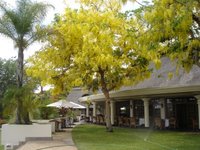 Dinner on the patio was exotic and romantic with an $8 US bottle of Zimbabwean Chardonnay (that gave us a laugh). It wouldn’t win any prizes or gold medals but it washed down our delicious dinner of bream (fish) and veg very well. We went to reception after to pay with our $100 US traveler’s cheque and a man was on duty. “Sorry can’t do that – I don’t have enough US $ to give you change” he was obviously lying. I told him the whole story and how finally the woman on duty two hours earlier had promised to do it for us. With that, he said, “Well let me see what I can do” We hung around and finally he came up with US $ change. We put $30 + $5 tip aside for Paka and pocketed the remainder. We’ll horde it for emergencies. We tried to stay up late but were fast asleep by 9:30pm.
Dinner on the patio was exotic and romantic with an $8 US bottle of Zimbabwean Chardonnay (that gave us a laugh). It wouldn’t win any prizes or gold medals but it washed down our delicious dinner of bream (fish) and veg very well. We went to reception after to pay with our $100 US traveler’s cheque and a man was on duty. “Sorry can’t do that – I don’t have enough US $ to give you change” he was obviously lying. I told him the whole story and how finally the woman on duty two hours earlier had promised to do it for us. With that, he said, “Well let me see what I can do” We hung around and finally he came up with US $ change. We put $30 + $5 tip aside for Paka and pocketed the remainder. We’ll horde it for emergencies. We tried to stay up late but were fast asleep by 9:30pm.
November 15, 2006 – Wednesday
We lingered in bed – didn’t get up until 7:30am – it was such a treat. After a luscious breakfast served on the verandah, we were picked up by ‘Polite’ for another included tour of the town, the National Park, the falls and a craft market. Along came a rattletrap open air, old safari vehicle, not the fancy air conditioned tour buses that everyone else seemed to be traveling in – it suited our rugged outlook!
It’s the beginning of summer in Zimbabwe and the shrubs are thick with greenery. Polite (so named by his father and who portrays his name nobly) tried to apologize for the inability to see wildlife other than monkeys and baboons “If you’d come in winter you’d have seen elephants, giraffes, zebra……..”. We’d seen enough wildlife in South Africa so enjoyed the drive for the flowers and birds and trees, like the giant baobobs. The walk along the Victoria Falls trail is 1.7 kilometers to the bridge to Zambia and even at 10:00am it was hot and steamy. We watched the crazy bungee jumpers going off the bridge into the gorge, their screams reverberating off the rock walls. The rainy season doesn’t start until midsummer and so the bridge end of the falls were dry but we could feel the spray blown from a long distance. The Zimbabwean name for the falls is so much more descriptive – it translates to ‘Smoking Thunder”.
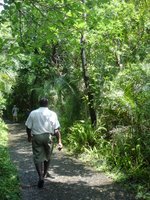
 As we got closer to the thundering rush of water, the spray got heavier and we couldn’t figure out if we were sweating or just wet from the spray. The jungle became dense and luscious with sweet smelling blossoms and thick ferns and the bright red Hebo lilies grew in profusion. With all the beauty, the rope vine swings and the frolicking monkeys, Dr. Livingstone must have thought he’d found Paradise in 1859 (or thereabouts).
As we got closer to the thundering rush of water, the spray got heavier and we couldn’t figure out if we were sweating or just wet from the spray. The jungle became dense and luscious with sweet smelling blossoms and thick ferns and the bright red Hebo lilies grew in profusion. With all the beauty, the rope vine swings and the frolicking monkeys, Dr. Livingstone must have thought he’d found Paradise in 1859 (or thereabouts).
Polite was a member of the Ndbheli (not sure about the spelling) tribe. “Very much like the Zulu” he said. He has a wife and one 7-year-old son and works everyday of the year if work is available. If he goes on holiday, it’s to see his mother who lives in a tiny tribal village about 200 kilometers away. The town of Victoria Falls has a population of 60 to 80 thousand and tourism is the only industry providing steady work for guides like Polite.
Down a steep staircase of 73 steps was a spectacular view of the ‘Cataract Falls’. The steps were long and difficult to navigate with short legs but the view was worth it.
We drove through the craft market telling Polite that we didn’t want to stop. “No money to spend” we said but we didn’t want carved hippos or giraffes or wire baskets “been there, done that”. We preferred to get back to the hotel for a shower.

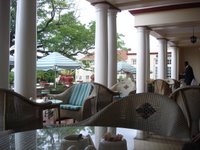 Having heard the Victoria Falls Hotel has ‘high tea’ on the verandah, we strolled over later that afternoon – it was only a short block away. A traditional three-tier dish of sandwiches, scones and pastries with a pot of Earl Grey tea was served us. “We have no cream today” announced the quietly spoken waitress. How on earth can they have ‘no cream’, we wondered and ‘what good are the scones without cream?” but we said nothing – what was the point?
Having heard the Victoria Falls Hotel has ‘high tea’ on the verandah, we strolled over later that afternoon – it was only a short block away. A traditional three-tier dish of sandwiches, scones and pastries with a pot of Earl Grey tea was served us. “We have no cream today” announced the quietly spoken waitress. How on earth can they have ‘no cream’, we wondered and ‘what good are the scones without cream?” but we said nothing – what was the point?
Two young English men and a young woman sat down for tea at the table beside us with a similar three-tier plate of goodies and I offered them the top layer of our dish, the one with all the pastries that we were unable to eat. “There are three of you, so I thought perhaps you would like them”.
”Damn right, we’ll happily scoff the lot” said one gratefully.
When it came time to pay the bill, we noticed it was in Zimbabwean $ - Z$7,250 and we asked if we could pay by a US$ traveler’s cheque and get change in US$. “No, sorry” was the answer but they took our credit card and ran it through in Z$. With the crazy fluctuations in their $, I wonder how much it will come through as. They said $29 US but who knows. We were quoted 250 Z$ to $1US. However, on the street you can illegally buy Z$ for 1,600 to $1US. We’ve been told that the only worth to the Z$ is as wallpaper. The funny thing is that everything paid in US$ is discounted 15% when it comes time to pay.
* It came through on our credit card statement at $28.91 US so all is well.
There were other tours available from Victoria Falls but they didn’t appeal to us.
· Chobe National Park in Botswana for a single day – we’d seen enough wildlife.
· Elephant rides – I can’t bear to torture the beautiful animals we’ve been viewing in the wild by harnessing and saddling them and turning them into beasts of burden purely for a tourist’s thrill
· Helicopter tour over the falls = Hmmm – too darn expensive. Now if they’d offered hot air balloon rides over the savannah………..
The dinner special that night was wart hog. Other wild game was offered too – I can’t eat the animals we’ve been admiring, so we had Zimbabwean vegetable curry – delish! We asked reception to phone Paka, the man who lent us the $30 US to get into the country and arranged a meeting with him tomorrow morning. The manager of the lodge, Jonathan, a 30ish white native Zimbabwean who was more English than the English, overheard us relate the tale of our difficult entry and he asked us to write our experience down so he could take it up with the tourism council.
November 16, 2006 – Thursday
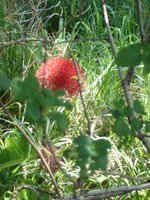
I stretched and looked out our French doors as I crawled out of bed and a big warthog was grazing in the parkland just below. I wanted to yell at him “Get outa here or you’ll be tonight’s dinner special”. We had a leisurely breakfast before we packed our bags, settled our account at reception and we were ready to go – thirty six hours from now we’ll be home – Yikes! Paka arrived and I repaid him the $30 US and gave him a $5 tip. He was overjoyed and pumped our hands with glee. About ten minutes later, Polite arrived to take us to the airport for our 12:30pm flight to Johannesburg then on to Washington, DC and finally Vancouver.
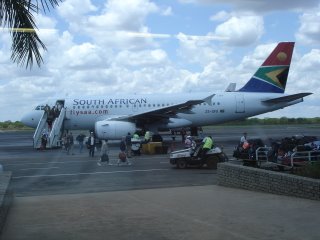
Epilogue
There is so much more to see in South Africa than the game reserves, Kruger and Cape Town and I feel we did much more than scratch the surface on our wonderful overland adventure. It exceeded our expectations and the memories will stay with us forever. My senses are overwhelmed when I think of what we’ve experienced – the game reserves and parks overflowing with wildlife, the Indian Ocean coastline with its explosive seas, the majestic mountains of the Drakensberg, the desert of the Karoo, the luxuriant Garden Route, the pristine coves and beaches with silky white powder sand, the fertile winelands and farmlands, the tropical jungles, the velvet valleys, the smiling faces. This trip energized us – I feel younger than ever. So, what next?
· Shall we take the Qinghai-Tibet railway, the world's highest from Beijing to Llasa? The problem is the politics – will it be used by China to assert control over a contested border region. Does the line threaten the delicate Himalayan environment and the ancient Tibetan culture. Should we support such a contentious issue?
http://news.bbc.co.uk/2/hi/asia-pacific/5140514.stm
· Shall we trek through Borneo to see the orangutans? http://www.toursexplore.com/phpWeb/index.php?module=pagemaster&PAGE_user_op=view_page&PAGE_id=39
· Should we visit Uganda to see the gorillas
http://www.wildland.com/trips/details/122/uganda_itin.aspx
· Shall we return to India to further explore – Rajasthan http://www.gapadventures.com/tour/AHRA
· or perhaps Kathmandu to Delhi http://www.trekescapes.com/trip-details.cfm?TripID=1451
· or what about the Pushkar Camel Fair http://www.trekescapes.com/trip-details.cfm?TripID=1453
· or Australia still beckons – Uluru, Alice Springs, Great Barrier Reef, Cairns, Darwin………


Our Entire Photo Album

Prologue:
The anticipation of our South African adventure was somewhat sullied by the length of the air travel there and back. Actually the journey to South Africa was not so bad as it was spread over two days with a hotel layover in Washington, DC. It was the return trip that was daunting – three flights over a 36-hour period.
Packing was easy – t-shirts, jeans and shorts being the backbone of our wardrobe. We packed an extra collapsible duffle bag full of t-shirts and school supplies (pens, pencils, erasers, calculators, etc.) that we’d collected with the help of caring friends. These items, so we’d heard, were welcomed in poor villages. And then there was the extra bonus of my having to fill it to take home – that’ll be no problem.
October 21, 2006 – Saturday
We’ve never traveled ‘United’ and been satisfied and this flight didn’t change our opinion – if rating airlines on a one to five star basis, I’d find it very difficult to give them more than half a star. The first leg of our journey was ‘United’ – Vancouver to Washington, DC, a five hour flight.
My first aggravation was several weeks previous when I phoned to get seat assignments. South Africa Airlines assigned seats for all our flights, international and domestic and I was so thrilled when I found out that the configurations was to be 2-4-2 and we’d have window and aisle on the 18 1/2-hour flights Washington to Johannesburg and return. United was a different story.
“Sorry Ma’am” the agent drawled “the seats will be assigned at the airport on the day of the flight”
“However, if you call again in a week, perhaps they (who are they?) will have released some seats.” She continued.
I phoned again a week later and after maneuvering through the many tiers of automated menus and finally reaching a person, I received exactly the same response, verbatim. So I kept trying – one week prior, four days ahead, the day before.
“Well Ma’am, I guess you’d just better get to the airport 2 ½ to 3 hours before the flight.” We did better than that and arrived 3 ½ hours early. It didn’t help though; the only two seats they had together were in the last row in a 3-3 Airbus configuration – window and centre. In retrospect, we should have split up and taken two aisle seats because the seats in the back row don’t recline – the backs are perpendicular. Neither Fernie nor I are long-legged but our knees wedged against the seats in front unless we pushed our derrieres tightly back into the seat. We kept our fingers crossed that the people in front of us didn’t recline – but of course they did. We were then captive – couldn’t pick up anything from the floor without extreme contortions. That’s when I discovered that my seat was broken and the cushion separated from the frame and slid forward. The good news was (and we were desperate for good news) the pilot announced that they’d be improving on the time and be arriving early – 4 ¾ hours instead of 5.
But it was an extremely uncomfortable flight. The heat seemed to pool in our corner especially when half the planeload lined up for the restrooms. It was stifling. We passed the time watching “The Devil Wears Prada” on a tiny screen three rows ahead of us. Amusing bit of fluff – our eleven-year-old granddaughter saw it several months ago and highly recommended it to us so it wasn’t exactly sophisticated entertainment – but we were desperate to get our minds off our discomfort. The standout, Meryl Streep portrayed a parody of a cold and demanding businesswoman in the fashion industry. She played the role fairly subtly and never went over the top. A second film, Prairie Home Companion was a strange one – only watched a bit of it but was amazed again by Meryl Streep – as a country singer of bygone days in the tradition of those old time singers like Loretta Lynn or maybe June Carter (I’m not a connoisseur of country music). She and Lily Tomlin played singing sisters from Minnesota – loved their accents – and Meryl’s singing voice is amazing.
I almost cheered when the plane descended and it’s landing gear engaged. Hope tomorrow’s flight is better. A night at an airport hotel with no restaurant for two miles meant dinner was an order-in pizza – which left me with my usual dyspepsia.
October 22 and 23, 2006 - Sunday and Monday
Before boarding for a 1pm departure, we walked steadily up and down the airport for over an hour until our legs were dead tired. We then donned our new ‘compression socks’ (I’ve read enough scary stories about blood clots and quick deaths on long flights), stocked up on bottled water and mentally prepared for the 17 hour flight to Johannesburg. What a difference in airplanes – and the service was superb on South Africa Airlines. We had our window and aisle seats on the side, interactive video in every seat back with a vast variety of films, TV, games, etc. Fernie played poker almost all the way. There was a neat little videocam mounted on the tail of the plane – we watched as it taxied and took off – quite thrilling from that perspective (I’m quite childlike in my delights).
I was a bit worried when we first tried out the entertainment module because we couldn’t access any films but with several ‘reboots’ they got it operational and I proceeded to watch three consecutive movies while I sipped on some fine South African Cabernet/Merlot with a chaser of mineral water. So the first seven-hour leg to Dakar, Senegal went pretty smoothly. It was midnight when we arrived so I was disappointed that there was no view of the city from the porthole. Refueling took about an hour and a quarter but we were held captive on the plane.
The final leg was interminable – I couldn’t sleep because it was still only evening at home and it was too warm on the plane. To top it off, the video system conked out again – luckily for Fernie, poker was still accessible. I watched the map and data screens and exercised along with the little cartoon man – toes up, toes down, circle left, circle right, and so on. I finally got tired a couple of hours before we got to Johannesburg but I just dozed off and the lights came on and breakfast was served. It was 11:30am when we landed – Yikes! Can’t go to bed for at least ten hours. As the plane banked on its final approach, I noticed large rectangular tracts filled with what looked like thousands of orderly mirrors glinting in the sun – they were the corrugated metal roofs of the huts in the townships.
Johannesburg airport can’t keep up to the air traffic. There are new terminal buildings under construction and planes were docked at incomplete buildings. There was no room for our plane so it was parked out in the field and buses transferred us to the terminal. Customs was a breeze – no questions, just stamp/stamp/stamp – Welcome to South Africa!
While waiting for the Drifters’ driver to pick us up, we were accosted by dozens of men wanting to taxi us to our hotel. A bidding war was breaking out just as our driver showed up. The Drifters’ Johannesburg Inn
 is 45 minutes from the airport – across the other side of the city in the pleasant northwestern suburban of Northcliff. Drifters’ head office is situated in a stately home on the same property as the inn. It was an utterly charming locale – thick and lush with tropical foliage and the air was sweetly scented. The inn was a large thatch-roofed building circled on both levels by spacious verandahs with comfy chairs in the shade. A wide expanse of emerald lawn with chaise lounges led us through a tunnel of greenery to an azure pool. Drifters’ tours both start and finish at the Johannesburg Inn – self-drive tours as well as the overland truck groups such as what we were about to embark on.
is 45 minutes from the airport – across the other side of the city in the pleasant northwestern suburban of Northcliff. Drifters’ head office is situated in a stately home on the same property as the inn. It was an utterly charming locale – thick and lush with tropical foliage and the air was sweetly scented. The inn was a large thatch-roofed building circled on both levels by spacious verandahs with comfy chairs in the shade. A wide expanse of emerald lawn with chaise lounges led us through a tunnel of greenery to an azure pool. Drifters’ tours both start and finish at the Johannesburg Inn – self-drive tours as well as the overland truck groups such as what we were about to embark on.We were assigned room #16 on the ground
 level, a small quaint room with two single beds and a picture window overlooking the tropical garden. Our huge shower with open thatched roof above was built of natural stone that sloped to the drain like a forest pool. It felt as if we were under a tropical waterfall. Now about 2pm on Monday and after two continuous days of travel, exhaustion was setting in. Wanting to quickly acclimatize ourselves to the new time zone, we only allowed ourselves a one-hour nap in our cool room.
level, a small quaint room with two single beds and a picture window overlooking the tropical garden. Our huge shower with open thatched roof above was built of natural stone that sloped to the drain like a forest pool. It felt as if we were under a tropical waterfall. Now about 2pm on Monday and after two continuous days of travel, exhaustion was setting in. Wanting to quickly acclimatize ourselves to the new time zone, we only allowed ourselves a one-hour nap in our cool room. The bar opened at 5pm and we were really thirsty. The bartender recommended that I have ‘the ladies’ beer’, Savanna Dry cider made from Granny Smith apples. That was it! I’m now addicted to the lovely light-amber concoction that only has a hint of apple flavour. http://www.savanna.co.za/. I’m gonna have to ask our BC liquor stores to import it. We sat on the verandah mellowing out with our drinks and watched the sun go down so happy to finally be in South Africa.
At 7pm, half of our group met for dinner in the inn’s dining room before meeting our guide, Dorran Bungay who briefed us about our pending expedition. The usual age of Drifters’ patrons is young – 45 at most but our group was a special for the ‘older folk’ – the suggestion was for ages 40 to 70. That puts us in the ‘way older’ bracket. Our bunch ranged from 42 to 65 – 13 Canadians (BC and Alberta) 2 Germans and 1 Belgian.
A side verandah held a circle of rattan sofas with plump cushions that we settled in for our briefing. Dorran, at 55 definitely the oldest guide, sported longish curly-hair and an untamed wild gray beard. He’d lost his wife a year ago, quit his engineering position and took the job of guide with Drifters. It’s a grueling job – he drives the truck, lectures, guides, shops for groceries, cooks, performs first aid if required and anything else that’s required. His normal day starts at 5am and finishes around 9pm. We were so lucky to get him.
“So, have all of you brought your sleeping bags?” he inquired rhetorically. He was flabbergasted when I gasped “What do you mean? I thought they were to be supplied”. Apparently, if we wanted Drifters to supply the gear, our agent had to put in an order in advance. Our ineffectual agent didn’t even mention the subject and none of the documentation did either. Two of the couples had kits ordered and waiting for them. “That’s never happened before” Dorran muttered. He checked with the Drifters staff for us but there was no gear available. He asked if we would mind buying some if he could find a shop en route the next day. “You’ll need it for twelve out of the seventeen nights” he said. A sense of panic overtook the anger I was feeling at the agent’s negligence but we hoped it would all work out.
October 24, 2006 – Tuesday

A huge green behemoth of a vehicle was ready and waiting for us in the driveway. It had four pairs of reclining seats each side, floor to ceiling windows that opened down halfway, sixteen huge lockers at the rear that easily held our luggage individually, refrigerated compartments to keep our drinks cold – I think we’re going to be mighty comfortable. It was less than six months old and to my eye, it was beautiful. In my idiosyncratic way, I nicknamed it “The Jolly Green Giant”.

We all grouped together in front of it to have our photo taken before heading off for a long driving day – seventeen strangers soon to become very familiar with each other. The final destination was Drifters’ privately owned 30,000-hectare Balule Game Reserve bordering Kruger National Park on the western perimeter 17 kilometers north of Hoedspruit (pronounced ‘hoodsprate’).
We headed east out of Johannesburg, then north through Pretoria and east through the high veld grasslands. A long stretch of the highway runs through coal mining territory – the coal only inches below the surface.
 We stopped at the little town of Belfast to shop for sleeping bags, etc. and found some at the hardware shop for only 150 rand each (about $23 Cdn) and no sales taxes – such a pleasant surprise. That was much cheaper than renting – Drifters was charging $18 Cdn a week. We then trotted down the road (not wanting to keep everyone waiting) to a linen shop where we bought pillows, pillow slips and bath towels for about $12 Canadian for the lot – what a deal! The shopkeepers spoke Afrikaans as their first language but switched instantly to flawless English. South Africa has eleven official languages – Afrikaans, English and nine tribal languages (Isindebele, IsiXhosa, IsiZulu, Northern Sotho, Sesotho, Setswana, SiSwati, Tshivenda, Xitsonga) – and no one speaks Swahili.
We stopped at the little town of Belfast to shop for sleeping bags, etc. and found some at the hardware shop for only 150 rand each (about $23 Cdn) and no sales taxes – such a pleasant surprise. That was much cheaper than renting – Drifters was charging $18 Cdn a week. We then trotted down the road (not wanting to keep everyone waiting) to a linen shop where we bought pillows, pillow slips and bath towels for about $12 Canadian for the lot – what a deal! The shopkeepers spoke Afrikaans as their first language but switched instantly to flawless English. South Africa has eleven official languages – Afrikaans, English and nine tribal languages (Isindebele, IsiXhosa, IsiZulu, Northern Sotho, Sesotho, Setswana, SiSwati, Tshivenda, Xitsonga) – and no one speaks Swahili. Pilgrims Rest, a historic gold mining town is nestled ,in a valley of the Drakensberg Mountains. This quaint village situated on a hillside provided an interesting array of shops and refurbished buildings to browse and stretch our legs. Dorran chose a ‘pancake’ restaurant for us all to have lunch – pancake in the British style known as crepes in North America. A Thai curry pancake, the crepe wrapped around the filling like an enchilada, with a beautiful robust merlot to wash it down - - - - - oh, but here I go again off on a food ecstasy.
Pilgrims Rest, a historic gold mining town is nestled ,in a valley of the Drakensberg Mountains. This quaint village situated on a hillside provided an interesting array of shops and refurbished buildings to browse and stretch our legs. Dorran chose a ‘pancake’ restaurant for us all to have lunch – pancake in the British style known as crepes in North America. A Thai curry pancake, the crepe wrapped around the filling like an enchilada, with a beautiful robust merlot to wash it down - - - - - oh, but here I go again off on a food ecstasy.
The terrain was changeable as we wound through the Drakensburg Mountains and the elevation plunged to the east and temperatures soared – it got quite tropical, very humid even though they haven’t had rain for a long stretch. Blyde River Canyon with its unique rock formations was our next stop. We dabbled our feet in Bourke's Luck Potholes which were shaped millions of years ago by erosion and just below the wide river narrowed and snaked through the rocky passage. Further along the canyon, the Three Rondavels (it seems that everything round in South Africa is called a ‘rondavel’), a trio of high circular rock formations stood majestically above the deep crevasse of the canyon. The viewpoint was at the edge of a steep high precipice and strangely, at the far end, there was no fence – it looked like a lover’s leap.

Thirteen hours had elapsed by the time we arrived at Balule Game Reserve and the sun was almost down. As we left the highway, the dirt road was smooth for the first fifteen kilometers and then we turned onto a rough and rocky stretch, which wove through the sparsely treed and arid bushveld. Our truck rocked and rolled precariously but we finally arrived unscathed.
“This is Africa at its wildest” Dorran proclaimed.
 The Balule Drifters Camp was comprised of a thatched roof central compound with a massive deck overlooking the forest and a watering hole about 20 meters below. A small swimming pool was sunk into the centre of the deck and a tree grew through it shading one end. It made for a welcome meeting place. Ten permanently tented huts were spread along the ridge overlooking the waterhole. Thatched roofs covered each one, a wooden screened door set in the canvas, Velcro covers over huge mesh windows and behind the rear flap, a full bathroom. Solar panels created sufficient light for the electrical needs including pumping of water from
The Balule Drifters Camp was comprised of a thatched roof central compound with a massive deck overlooking the forest and a watering hole about 20 meters below. A small swimming pool was sunk into the centre of the deck and a tree grew through it shading one end. It made for a welcome meeting place. Ten permanently tented huts were spread along the ridge overlooking the waterhole. Thatched roofs covered each one, a wooden screened door set in the canvas, Velcro covers over huge mesh windows and behind the rear flap, a full bathroom. Solar panels created sufficient light for the electrical needs including pumping of water from  beneath the ground so we could have showers. Two bunks with bare plastic mattresses made us oh so pleased that we’d found sleeping bags. Our unit was right down the end along a couple of hundred meters of trail winding through the bush. Cleverly, I did have the foresight to pack a flashlight or we’d never have found our way after sunset. The darkness was total, not brightened by the lights of civilization.
beneath the ground so we could have showers. Two bunks with bare plastic mattresses made us oh so pleased that we’d found sleeping bags. Our unit was right down the end along a couple of hundred meters of trail winding through the bush. Cleverly, I did have the foresight to pack a flashlight or we’d never have found our way after sunset. The darkness was total, not brightened by the lights of civilization.Dinner that night was an African barbecue on the deck, known as a ‘braai’ – beef kabobs, lamb chops and some sort of sausage. Not being much of a red meat eater, I just sampled bits of each. Accompanying the dinner was a staple of the South African diet – Pap, about as tasty as it sounds. It’s made from ground white maize (corn) and reconstituted with water – not too palatable to me but it was innocuous. I loaded up on salad. Every Drifters Inn has a bar of sorts – this one just a refrigerator stocked with soft drinks, beer, my favourite Savanna Dry and bottled waters. Also, always on hand, are some decent bottles of wine. I chose a bottle of merlot that would do me for the two nights we’d be there, while Fernie stuck to beer. On re-reading this, it sounds as if I’m a major imbiber……….
Our body clocks not internally adjusted yet, exhaustion set in early (aided by the wine) and we meandered home down the dark trail with our trusty flashlight. The beam picked out some monstrous beetles that scurried off, more afraid of us than we of them and a dead snake which at first appeared to be slithering in the light. I did feel glad we’d worn closed shoes. We realized too that the camp was open to the wilds and a lion, elephant or other frightening creature could at any moment loom out of the darkness. So our adrenaline was running in a thrilling way. I had earlier marked the side trail down to our tent with a large white rock and thank goodness I did because it would be easy to become disoriented. The night was still and now we were away from the group and its chatter, the animal sounds echoed through the air. There was a snuffling and snorting just below us – sounded about ten or twenty feet away; strange calls answered by other unfamiliar sounds lulled us to sleep.
October 25, 2006 – Wednesday
2:00am – Thunk! Something hit the side of the tent. I bounded out of bed but looking out of the windows was useless – total darkness. A rustling in the trees to the side though made me very aware we’d had some sort of visitor. Of course, I couldn’t sleep after that – not because of fear
 but excitement to be in this locale.
but excitement to be in this locale.5:00am – A lightening in the eastern sky, so I slid out of my sleeping bag and as I stood stretching in front of one of the giant picture windows, a lone giraffe sauntered by only about six meters away.
“Wake up!” I croaked to Fernie “Giraffe!”
With that, he grabbed his glasses and leapt out of bed. We scurried out to our raised deck in awe of the beautiful creature silhouetted against rosy hues of the dawn sky. It stopped to nibble at branches overhead and seemed unaware of our presence. What an exciting way to start the day.
7:00am – We headed out after coffee and tea on our first game drive.
 Drifters has two open-sided jeeps that held eight in each. I promised myself that I wouldn’t make comparisons to Kenya with its prolific wildlife but for the first while we didn’t see much. Then all of a sudden there were zebra, impala, kudu, more giraffes, steenbok and a herd of wildebeest (AKA gnus) lurking at a waterhole. The gnus were skittish as we drove in and stopped but then settled down to drink when we stayed still and quiet.
Drifters has two open-sided jeeps that held eight in each. I promised myself that I wouldn’t make comparisons to Kenya with its prolific wildlife but for the first while we didn’t see much. Then all of a sudden there were zebra, impala, kudu, more giraffes, steenbok and a herd of wildebeest (AKA gnus) lurking at a waterhole. The gnus were skittish as we drove in and stopped but then settled down to drink when we stayed still and quiet.
Determined to find elephants, we carried on.
 The park is overrun with them and they are the hooligans of the reserves. They’ll tear down a large tree to eat one sprig or to tear off a slice of bark, leaving a graveyard of uprooted and cracked trees in their wake. The overpopulation is causing chaos but herd management is not practiced – initially, that made me happy but the realization is that they are ruining the savanna for other species. We finally glimpsed one off at a distance. We’d been out for 4 ½ hours by this time and our rear ends were beaten black and blue by the 4x4 bouncing up and down and sideways on the bumpy roads so we headed back. As we spied the waterhole in front of our camp, there was a rotund elephant (nicknamed Fats Domino by Fernie) and a lone giraffe (Long Tall Sally) cohabiting at the waterhole – How miraculous!
The park is overrun with them and they are the hooligans of the reserves. They’ll tear down a large tree to eat one sprig or to tear off a slice of bark, leaving a graveyard of uprooted and cracked trees in their wake. The overpopulation is causing chaos but herd management is not practiced – initially, that made me happy but the realization is that they are ruining the savanna for other species. We finally glimpsed one off at a distance. We’d been out for 4 ½ hours by this time and our rear ends were beaten black and blue by the 4x4 bouncing up and down and sideways on the bumpy roads so we headed back. As we spied the waterhole in front of our camp, there was a rotund elephant (nicknamed Fats Domino by Fernie) and a lone giraffe (Long Tall Sally) cohabiting at the waterhole – How miraculous!
In the outdoor kitchen adjacent to the deck, Dorran cooked up a massive brunch of bacon, ostrich eggs and toast with all of us pitching in to help. I believe only two ostrich eggs fed the lot of us. They were so tasty – they made chicken eggs bland in comparison.

The day became terribly hot and oppressive as it wore on. Humidity was high in spite of the arid conditions and lack of rain.
 So a siesta was called for and just lazing the day away on our own little deck that was so close to the waterhole and its constant activity. We waited for it to get a bit cooler for Dorran, Isaac and Busie (the two black managers of the camp) to take us out on a bush walk to track game and get familiar with wild Africa. The guides did not carry weapons, so I did wonder what would happen if we encountered a pride of lions but I realized later that they knew the signs to watch out for.
So a siesta was called for and just lazing the day away on our own little deck that was so close to the waterhole and its constant activity. We waited for it to get a bit cooler for Dorran, Isaac and Busie (the two black managers of the camp) to take us out on a bush walk to track game and get familiar with wild Africa. The guides did not carry weapons, so I did wonder what would happen if we encountered a pride of lions but I realized later that they knew the signs to watch out for.We were instructed to walk single
 file and on our toes as much as possible to quietly make our way unobserved. Dorran led the parade and Isaac took the rear. We inspected ‘dung’ – yes, that’s right poopies! I personally chose not to handle it. We saw that elephants don’t digest most of the bulk they gorge on for twenty hours a day. It was full of sticks and thorns. We learned to tell how fresh it was. We came across giraffe dung, zebra dung and went through the same inspection process. Finally Dorran and Isaac showed us a game played by Zulus in the bush – using impala dung, which were small round stony pellets.
file and on our toes as much as possible to quietly make our way unobserved. Dorran led the parade and Isaac took the rear. We inspected ‘dung’ – yes, that’s right poopies! I personally chose not to handle it. We saw that elephants don’t digest most of the bulk they gorge on for twenty hours a day. It was full of sticks and thorns. We learned to tell how fresh it was. We came across giraffe dung, zebra dung and went through the same inspection process. Finally Dorran and Isaac showed us a game played by Zulus in the bush – using impala dung, which were small round stony pellets.  They put a pellet in their mouths (I know – YUCK!) and spit them as far as they could.
They put a pellet in their mouths (I know – YUCK!) and spit them as far as they could. “Any takers?” he asked with a grin.
I almost fell over when Fernie (a true adventurous spirit) took the challenge and his went further than either of theirs. A couple more tried it (not me – no thank you) and Fernie was still the champ until Dorran tried again.
We inspected and became familiar with the different trees and shrubs and their uses and importance to the scheme of things. One tree (I forget its true name) is known as the ‘toilet paper tree’ by the natives, so we committed that important detail to memory, never knowing when it would become useful. We discussed the geology and looked at stones – I am always on the lookout for something special I can use in lapidary but nothing caught my fancy. I guess we’d strolled and talked and explored for a couple of hours; the sun was about to set so it was time to get back. We were thoroughly content.
 Cocktail time! (you can take the girl out of the city but you can’t take away her ‘happy hour’) For me, the remainder of the red wine, which I had chilled in the fridge – I know, that’s not kosher but it tasted great in the heat. Dinner was curried lamb and rice. Wow, can Dorran cook – it was fabulous. The cleanup was a big job – seventeen of everything plus those giant cast iron pots and skillets but Fernie volunteered to wash and I and a couple of others dried and tidied up. This participatory traveling is so bonding – I never thought I would enjoy it so much.
Cocktail time! (you can take the girl out of the city but you can’t take away her ‘happy hour’) For me, the remainder of the red wine, which I had chilled in the fridge – I know, that’s not kosher but it tasted great in the heat. Dinner was curried lamb and rice. Wow, can Dorran cook – it was fabulous. The cleanup was a big job – seventeen of everything plus those giant cast iron pots and skillets but Fernie volunteered to wash and I and a couple of others dried and tidied up. This participatory traveling is so bonding – I never thought I would enjoy it so much.
But the day wasn’t over;
 we split up again – eight in each jeep – and headed out on a night bush drive. Bucie up front shone a huge spotlight and swung it side to side and we quietly watched for the glint of eyes in the darkness. I now truly understand the expression ‘deer in the headlights’ because a small herd of impala that would have bounded away in the daylight were totally disoriented and just stood there only twenty feet from us staring into the light. We encountered cape buffalo, giraffe, some small rodents and the best of the lot – a tiny white-headed owl at our eye level right beside the truck. After 2 ½ hours, we were exhausted and on one huge bump, I hit my head on one of the overhead pipes that held the canvas shade – I saw stars!
we split up again – eight in each jeep – and headed out on a night bush drive. Bucie up front shone a huge spotlight and swung it side to side and we quietly watched for the glint of eyes in the darkness. I now truly understand the expression ‘deer in the headlights’ because a small herd of impala that would have bounded away in the daylight were totally disoriented and just stood there only twenty feet from us staring into the light. We encountered cape buffalo, giraffe, some small rodents and the best of the lot – a tiny white-headed owl at our eye level right beside the truck. After 2 ½ hours, we were exhausted and on one huge bump, I hit my head on one of the overhead pipes that held the canvas shade – I saw stars!Bed was so welcome – I was asleep as soon as my head touched the pillow.
October 26, 2006 – Thursday
 Dorran has a native drum that he beats to summon us to meals and wake us in the morning. But almost all of us were up ahead of the drum this morning. A breakfast of cereal, fruit and toast and we were on our way to Hazyview.
Dorran has a native drum that he beats to summon us to meals and wake us in the morning. But almost all of us were up ahead of the drum this morning. A breakfast of cereal, fruit and toast and we were on our way to Hazyview.The first stretch of highway 40 south was riddled with entrances to hundreds of other private game reserves bordering Kruger National Park - some of them extremely expensive upscale ones. Further on a bit it was townships as far as the eye could see. Not one white person lives in this area. This polarity between rich and poor is a troubling constant. The roads through the townships are a colourful sight – people walking everywhere. The main mode of transportation is taxi vans, as no one owns a car. The homes vary from very basic little huts to the occasional ‘nice’ home. Outhouses prevail. Wheelbarrows are a proud possession and are used to transport water in large plastic containers. There is almost no water or electricity in these townships and they’ll walk several kilometers to a water station. It was a constant fascination watching the passing scene:
* Women chatting volubly while washing clothes in the creeks
* Entrepreneurial individuals setting up acetylene tanks at roadside to do welding and repairs
* Another selling recycled tires
* A structure made of thick branches covered with a blanket and the scrawled words ‘Car Wash’
* Laughter everywhere
* Smiling faces with glistening white teeth
* Folks dressed in wildly colourful and spotlessly washed clothes waving to us as we whizzed by.
With all this, it’s hard to believe that it would be dangerous to venture in alone on foot. However, with such extreme poverty, some would look at us as a source of income – we affluent travelers. And, I can’t say I actually blame them.
At Hazyview, we were dropped off at an outdoor shopping plaza, Peri Bridge I think it was called, while Dorran zipped up to the supermarket to stock up on groceries. Some went into the Internet café but we chose to sprawl in big comfy chairs under the palms with a beer to quench our thirst – the area is so lush and tropical. I’ve made a concerted resolution to not touch a computer for the entire time in Africa – it’s very freeing. I don’t need to check email; those that want to find me have our itinerary and could track us down if necessary.
 Drifters Inn Hazyview is a beautiful large, thatched log structure deep in jungle, just high enough on a ridge overlooking the rushing Sabie River where hippos and crocodiles live together in harmony. Our rooms exited directly onto a covered deck running the entire length of the building, in the centre of which was a cozy little bar leading in to a high open-beamed great room and massive kitchen.
Drifters Inn Hazyview is a beautiful large, thatched log structure deep in jungle, just high enough on a ridge overlooking the rushing Sabie River where hippos and crocodiles live together in harmony. Our rooms exited directly onto a covered deck running the entire length of the building, in the centre of which was a cozy little bar leading in to a high open-beamed great room and massive kitchen.  Lemon orchards thrive in this moist environment and the scent perfumed the air. Electric fences circle the entire compound and sadly there was a need to have a rifle-carrying guard at the main gate (animals weren’t the only threat). When we arrived, we were greeted by Nandy, one of two resident ostriches. She immediately took a liking to Fernie and pecked gently at him, at his wedding ring, his watch – shiny things.
Lemon orchards thrive in this moist environment and the scent perfumed the air. Electric fences circle the entire compound and sadly there was a need to have a rifle-carrying guard at the main gate (animals weren’t the only threat). When we arrived, we were greeted by Nandy, one of two resident ostriches. She immediately took a liking to Fernie and pecked gently at him, at his wedding ring, his watch – shiny things.
I spent a couple of hours mostly alone at
 the swimming pool writing – sitting on the edge of the pool with my legs dangling in the water. All of a sudden, Nandy came out of the thick shrubbery from behind me and right beside me stuck her beak in the pool to get a drink. She scared me half to death but it made me giggle to see her gulp, lift her long neck high and a tennis ball lump of water would snake down her throat and then she’d repeat it. The young couple who run the lodge also have a snake house which I was disappointed we couldn’t visit and handle the snakes. They had just eaten (yesterday!) and might regurgitate. I’d never thought of snakes having indigestion before – it humanized them and made me feel more of an affinity. A little daschund, a cat and a loveable and friendly little mongoose freely wandering around completed the menagerie.
the swimming pool writing – sitting on the edge of the pool with my legs dangling in the water. All of a sudden, Nandy came out of the thick shrubbery from behind me and right beside me stuck her beak in the pool to get a drink. She scared me half to death but it made me giggle to see her gulp, lift her long neck high and a tennis ball lump of water would snake down her throat and then she’d repeat it. The young couple who run the lodge also have a snake house which I was disappointed we couldn’t visit and handle the snakes. They had just eaten (yesterday!) and might regurgitate. I’d never thought of snakes having indigestion before – it humanized them and made me feel more of an affinity. A little daschund, a cat and a loveable and friendly little mongoose freely wandering around completed the menagerie.In the late afternoon when it didn’t
 seem any cooler (later on I heard it was 40 degrees C), Dorran took us on a walk down through the jungle to the river to look for hippos and crocs ----- and to perform his threatened and ominous ‘Test’. This word set up immediate angst in most of us. Just standing still, the sweat dribbled like running sap from every pore of my body. I had a cotton scarf
seem any cooler (later on I heard it was 40 degrees C), Dorran took us on a walk down through the jungle to the river to look for hippos and crocs ----- and to perform his threatened and ominous ‘Test’. This word set up immediate angst in most of us. Just standing still, the sweat dribbled like running sap from every pore of my body. I had a cotton scarf  emblazoned with ‘Sturgis Bike Rally 06’ that I soaked in the river and tied around my neck but it ended up Rambo style around my head. It kept the salty sweat out of my eyes. There were fresh hippo tracks but no hippos that afternoon and we walked about 300 meters upstream to no avail.
emblazoned with ‘Sturgis Bike Rally 06’ that I soaked in the river and tied around my neck but it ended up Rambo style around my head. It kept the salty sweat out of my eyes. There were fresh hippo tracks but no hippos that afternoon and we walked about 300 meters upstream to no avail. We retraced our steps to participate in the dreaded unknown ‘Test’. Only one of the group didn’t take the phantom challenge. We assumed it would be a steep and arduous hike up the hill in the extreme heat. Dorran had warned that he wanted to make sure we were capable of tackling the ascent to the vultures in the Drakensburg Mountains and the climb up Table Mountain in Cape Town. But our ‘Test’ was ‘bushwhacking’, an all-encompassing term of climbing, forging through untamed undergrowth, through muddy rivulets, across narrow logs,
 up steep dirt embankments and down again and not on our backsides. He watched how we all managed and was very pleased that we had a good and happy attitude throughout. It was a lot of sweaty and dirty fun. He declared us all ‘capable’ of the future mountain climbs. No hippos or crocs downstream either, so we bushwhacked back up river, up the steep stairs, past the lodge for a more calm nature walk. We inspected indigenous trees and plants, animal tracks and insects – we even handled long shiny black millipedes.
up steep dirt embankments and down again and not on our backsides. He watched how we all managed and was very pleased that we had a good and happy attitude throughout. It was a lot of sweaty and dirty fun. He declared us all ‘capable’ of the future mountain climbs. No hippos or crocs downstream either, so we bushwhacked back up river, up the steep stairs, past the lodge for a more calm nature walk. We inspected indigenous trees and plants, animal tracks and insects – we even handled long shiny black millipedes.We ran for the showers after the slogging afternoon and it was pure ecstasy to stand under the cooling spray. A couple of Savanna Drys at the bar hit the spot before dinner was served in the lovely high-ceilinged dining room – tonight beef stroganoff. How on earth does Dorran do it? There was also salad and mini squash filled with peas and cheese. Ice cream and chocolate syrup after – Fernie was delighted but I passed on it – I don’t like ice cream (thank goodness). We lingered chatting and writing in the great room for a couple of hours sipping on tea. While Fernie watched ‘the bridge ladies’ playing bridge, I talked with Dorran – an interesting conversation that evolved into his ‘faith’. As well as being an engineer, he had been a minister, which really surprised me. So we shared our philosophies, he not shrinking from my atheistic and evolutionist beliefs and I interested in his description of his personal Christian faith. It made for an open and friendly debate, neither one of us veering from our ideologies but respecting each other’s convictions. Great flashes of lightning and deep rolls of thunder preceded a downpour and with that tiredness overtook us and we called it a night.
We foolishly left our unscreened window and patio French doors wide open and when we went back found some small black flying beetles had taken up residence. Fernie went on the attack and killed them all or so we thought. The ceilings were of high open thatch, so we couldn’t’ really tell what was up there but we slipped into our comfy beds, turned off the lights, the large ceiling fan overhead cooling us – when ‘Plop’ right into my cleavage! “Screech!” and I jumped out of bed doing the horrified jiggle dance to dislodge whatever dropped into my nightie. It was another beetle so one more attempt at decimating the resident population and we settled back down. We realized that they had been attracted to the lights so kept them off and opened our window and door so we could enjoy the sound of the rain and the rushing river below. That was foolish I suppose – a snake or lizard or rodent could have easily joined us – but if they did, they left before we woke in the morning.
October 27, 2006 – Friday
3:00am Wide Awake! I enjoyed lying there for a while listening to the jungle sounds and dripping rain but when I started tossing about I got up and took my journal out to the covered bar on the deck – 4:00am by this time. With my trusty little book light, I wrote until the first signs of life appeared – Fernie, who brought me a hot cup of tea. What a guy!
Breakfast was prepared by the lodge staff today so we didn’t have to do a thing except pour our coffee, tea and juice and congregate around the long rustic table. We were on the road by 7:30am only having to drive about half an hour before entering Kruger National Park. I bought myself a Kruger guide at the gate to keep track and help identify the birds, animals, reptiles, etc. It was a wonderful day of sighting. We encountered so many species but only four of the Big Five. Leopards are nocturnal creatures and are the most difficult to spot.
 · Rhinoceros - #1 of the Big Five- only ten minutes into the park, we happened upon two ‘white rhinos’ (they aren’t actually white or even light in colour – it’s an evolution of the word ‘wide’ which described their jaw). Only about 3 meters off the road, they grazed and nipped at each other in oblivion of the human interlopers. This seemed to be the case with most of the wildlife, which were in abundance.
· Rhinoceros - #1 of the Big Five- only ten minutes into the park, we happened upon two ‘white rhinos’ (they aren’t actually white or even light in colour – it’s an evolution of the word ‘wide’ which described their jaw). Only about 3 meters off the road, they grazed and nipped at each other in oblivion of the human interlopers. This seemed to be the case with most of the wildlife, which were in abundance.  · The prolific impala – 100,000 + in the park with shiny tan fur, featherlike tails whisking away the flies, black markings on their rumps in the shape of MacDonald’s golden arches.
· The prolific impala – 100,000 + in the park with shiny tan fur, featherlike tails whisking away the flies, black markings on their rumps in the shape of MacDonald’s golden arches. · Hippopotamus – many up close sightings mostly in the water. At first you only see what looks like a rock but then make out perky little ears and two revolving eyes, with sometimes a snout and nostrils above water. They can submerge for five minutes and then gracefully rise displaying their rotund bodies and then retreat to ‘periscope’ position. It’s so funny to see a row of little ears and eyes looking at you. A couple of times, we met some out of water grazing on the banks and saw them in their full glory.
· Hippopotamus – many up close sightings mostly in the water. At first you only see what looks like a rock but then make out perky little ears and two revolving eyes, with sometimes a snout and nostrils above water. They can submerge for five minutes and then gracefully rise displaying their rotund bodies and then retreat to ‘periscope’ position. It’s so funny to see a row of little ears and eyes looking at you. A couple of times, we met some out of water grazing on the banks and saw them in their full glory. · Warthogs – pugnacious, bristly little ‘piggies’. One of our fellow passengers, Jean (a delightful blonde) called out ‘piggies on the left!’, which made us roar with laughter.
· Warthogs – pugnacious, bristly little ‘piggies’. One of our fellow passengers, Jean (a delightful blonde) called out ‘piggies on the left!’, which made us roar with laughter. · Elephants - #2 of the Big Five - in abundance. We watched them as they vandalized the forest – tearing limbs and bark from trees. “CRACK” we’d hear as they snapped tree trunks with ease. Three babies climbed on to each other’s backs playfully as if they were in the circus.
· Elephants - #2 of the Big Five - in abundance. We watched them as they vandalized the forest – tearing limbs and bark from trees. “CRACK” we’d hear as they snapped tree trunks with ease. Three babies climbed on to each other’s backs playfully as if they were in the circus. · Leopard tortoise – they’d amble away from the road into the long grass as vehicles approached but so slowly that we could easily get a good look.
· Leopard tortoise – they’d amble away from the road into the long grass as vehicles approached but so slowly that we could easily get a good look. · Blue wildebeest – AKA gnus. Ungainly creatures so named for the noise they make when frightened “Gnuuuuuuuuu”
· Blue wildebeest – AKA gnus. Ungainly creatures so named for the noise they make when frightened “Gnuuuuuuuuu” · Giraffe – at a distance but since we’d had many close encounters at the Bushveld Camp, we weren’t disappointed.
· Giraffe – at a distance but since we’d had many close encounters at the Bushveld Camp, we weren’t disappointed. · Lion - #3 of the Big Five – several encounters. Elegant, calm, unafraid, they permitted a bevy of vehicles to view them from about ten meters. A large pride with a magnificent male, we watched youngsters frolic but not wildly, more a gentle rolling and pawing.
· Lion - #3 of the Big Five – several encounters. Elegant, calm, unafraid, they permitted a bevy of vehicles to view them from about ten meters. A large pride with a magnificent male, we watched youngsters frolic but not wildly, more a gentle rolling and pawing.
 · Kudu - Kudu dung spitting (Bokdrol Spoeg in Afrikaans) is a sport in the bushveld of South Africa - small, hard pellets of dung from the Kudu are spat, with the furthest distance reached being the winner - and to think I have a champion right in the family.
· Kudu - Kudu dung spitting (Bokdrol Spoeg in Afrikaans) is a sport in the bushveld of South Africa - small, hard pellets of dung from the Kudu are spat, with the furthest distance reached being the winner - and to think I have a champion right in the family. · Nyala – another antelope, similar to the kudu but smaller
· Nyala – another antelope, similar to the kudu but smaller · Waterbuck – and yet another antelope, again similar to the kudu but larger
· Waterbuck – and yet another antelope, again similar to the kudu but larger · Buffalo - #4 of the Big Five – massive beasts with their long curling horns, they are one of the most dangerous African animals.
· Buffalo - #4 of the Big Five – massive beasts with their long curling horns, they are one of the most dangerous African animals.· Terrapin – hmmmm, not much to describe – swims and ????? swims.
 · Baboons – delightful, family-oriented beggars. A large male sat displaying his manhood cupped in his hands while the females and young groomed each other and scurried about. One little baboon snoozed sitting up like a little old man. Big Daddy sauntered over to the truck and plopped back down on his haunches obviously hoping for a handout. Suddenly, the whole troop were on the move along the dry riverbed, reminiscent of Planet of the Apes.
· Baboons – delightful, family-oriented beggars. A large male sat displaying his manhood cupped in his hands while the females and young groomed each other and scurried about. One little baboon snoozed sitting up like a little old man. Big Daddy sauntered over to the truck and plopped back down on his haunches obviously hoping for a handout. Suddenly, the whole troop were on the move along the dry riverbed, reminiscent of Planet of the Apes. · Steenbok – a small member of the antelope family, big ears and eyes. They don’t seem to roam in herds but travel alone.
· Steenbok – a small member of the antelope family, big ears and eyes. They don’t seem to roam in herds but travel alone. · Hyena – ugly, vicious critters, we found one lying in the long grass, sleeping beside the road. Well-camouflaged, only the twitch of his ears and tail gave away his location.
· Hyena – ugly, vicious critters, we found one lying in the long grass, sleeping beside the road. Well-camouflaged, only the twitch of his ears and tail gave away his location. · Zebra – very skittish and their stripes tend to make them fade into the background. They hang around with giraffes, wildebeest and impala.
· Zebra – very skittish and their stripes tend to make them fade into the background. They hang around with giraffes, wildebeest and impala. · Klipspringer – another small antelope, they live in rocky hills. They have hollow hooves that grip the rocks and run uphill when frightened instead of downhill like the rest of the antelopes.
· Klipspringer – another small antelope, they live in rocky hills. They have hollow hooves that grip the rocks and run uphill when frightened instead of downhill like the rest of the antelopes. · Ground hornbill – large black bird with a red face. They are an endangered species, lay only two eggs every eight years and then only accept one of them. They don’t seem to worry about their precarious position.
· Ground hornbill – large black bird with a red face. They are an endangered species, lay only two eggs every eight years and then only accept one of them. They don’t seem to worry about their precarious position.· Birds galore – eagles, storks, barbets, starling, francolin, owl, etc., etc.,
 · Vervet monkey – we stopped for lunch on the banks of the Sabie River and the aggressive little primates watched for their opportunity to steal food. Signs proclaimed, “Do not feed the monkeys, they become dangerous and we must kill them”. They were repeatedly thwarted in their barrage of attempts but persevered. Their gray and white faces expressed their aggressiveness and stubbornness. Lunch was cleared up and a fellow passenger and I still sat at a table finishing our fruit. In front of me, I tucked peels into a plastic bag and folded and tucked it partially under my plate. Suddenly a monkey descended from the tree overhead, so quickly and landed on the table, bruising my shoulder in his descent and in the same motion grabbed my garbage bag with one hand while trying to snatch my orange with the other – all in a split second. I, of course did what any red-blooded woman would - I let out a blood-curdling shriek. The nasty little thief flew through the branches and onto the roof of an adjoining building but when he inspected his ‘haul’ he discarded it with contempt.
· Vervet monkey – we stopped for lunch on the banks of the Sabie River and the aggressive little primates watched for their opportunity to steal food. Signs proclaimed, “Do not feed the monkeys, they become dangerous and we must kill them”. They were repeatedly thwarted in their barrage of attempts but persevered. Their gray and white faces expressed their aggressiveness and stubbornness. Lunch was cleared up and a fellow passenger and I still sat at a table finishing our fruit. In front of me, I tucked peels into a plastic bag and folded and tucked it partially under my plate. Suddenly a monkey descended from the tree overhead, so quickly and landed on the table, bruising my shoulder in his descent and in the same motion grabbed my garbage bag with one hand while trying to snatch my orange with the other – all in a split second. I, of course did what any red-blooded woman would - I let out a blood-curdling shriek. The nasty little thief flew through the branches and onto the roof of an adjoining building but when he inspected his ‘haul’ he discarded it with contempt.After lunch a travelmate and I went over to the washroom and a woman coming out said “Aye – there’s a man in there – in the ladies”. So, we peeked in and a stall door opened and a tall, elegantly dressed man with an arrogant manner stepped out. “You’re in the wrong room,” we chorused. He just sneered and raised his eyebrows arrogantly. That immediately raised my ire and I confronted him with my scorn and derision. “No doubt with your background, you haven’t been taught manners and decency” I said in my most imperious manner. Obviously not expecting confrontation, he scuttled out of there fast, back to his posh busload of wealthy sightseers. A simple apology would have averted all of this.
 That night we spent in Pretoriuskop Camp, one of many in the national park. Round huts – rondavels, scattered about were our rooms. The truck was parked beside an open-sided rondavel, a kitchen complete with hotplates, sink, instant hot water – modern and utilitarian. Dorran pulled a huge stainless steel table and 16 chairs out of the truck’s underbelly – what an amazingly outfitted vehicle it is.
That night we spent in Pretoriuskop Camp, one of many in the national park. Round huts – rondavels, scattered about were our rooms. The truck was parked beside an open-sided rondavel, a kitchen complete with hotplates, sink, instant hot water – modern and utilitarian. Dorran pulled a huge stainless steel table and 16 chairs out of the truck’s underbelly – what an amazingly outfitted vehicle it is. Fernie was sous chef again – he’s learning a lot from Dorran and enjoys working with him. South African Kentucky Fried Chicken – Fernie battered the pieces and manned the deep fryer. I managed to get to the camp store just before it closed and snafued a bottle of Cabernet/Merlot, which I shared, with some of the others. The kitchen was two-sided, two full workstations. A large South African chap was sautéing a scrumptious looking meal – I (as usual) struck up conversation with him and found him to be a garrulous and jovial chap. We joked and chatted and his wife arrived to help with the finishing touches. She was just as gregarious and when I asked her where they lived, she said “We’re Malallapipes” meaning ‘we sleep in pipes’ or homeless. They had recently sold their home, put their goods into storage and now live out of their SUV working here and there in the bush at camps. I told them that we called ourselves ‘nomads’ since we’d bought an RV and were roaming North America willy-nilly. So they suggested we swap expressions – Fernie and I are now Malallapipes and they’re Nomads. He was a chef by trade and got out of the ‘hotel’ business as it was too controlled – no allowance for a freedom of expression. But in camps, he does as he likes at the front end (cooking) while his wife does the back end (cleanup).
I found out all this by opening up with “you’re much too young to retire”.
She then proceeded to say with pride “Oy – I’m 56 and I got myself a young un’ – he’s only 42 yer know?”
”Oh yeah” he jumped in “I thought I got meself a sugar mommy and I sure ain’t getting’ no sugar” laughing uproariously. They trotted off back to their rondavel with their aromatic meal.
As we didn’t have a toilet in our hut, it meant walking to the bathhouse when I awoke at 3am. With my little flashlight, I made my way over – there was a most unusual insect in the stall – beetle like, about 3 inches long with a pointy tail and a hunch back. I scuffled my feet to frighten it away but the gutsy thing slunk over to get a closer look at me. I had sandals on and didn’t want it attacking my toes and I couldn’t bear to squash it. After all, it has more right to be there than I. It’s different with little bugs – I can happily squash them but when you can see their features, it personalizes them. So, I chose a different stall.
October 28, 2006 – Saturday
 It was a long drive south through Kruger and out at Malelene. We stopped for Dorran to shop for groceries and that gave us an hour to browse a large outdoor shopping centre.
It was a long drive south through Kruger and out at Malelene. We stopped for Dorran to shop for groceries and that gave us an hour to browse a large outdoor shopping centre.  It seemed at first glance to be an affluent area but appearances can be deceiving. Poverty is endemic. However, the people were colourfully well dressed, buying goods and congregating in large happy groups. The children were beautiful – mothers carried babies on their lower backs, the babies’ legs encircling their waists and tucked in to a cotton shawl wrapped around their waists. The music attracted us – strong African rhythms, melodious voices and the locals were moving their bodies to the beat – so we went into the music store to ask what CD they were playing on the loudspeaker and promptly bought it.
It seemed at first glance to be an affluent area but appearances can be deceiving. Poverty is endemic. However, the people were colourfully well dressed, buying goods and congregating in large happy groups. The children were beautiful – mothers carried babies on their lower backs, the babies’ legs encircling their waists and tucked in to a cotton shawl wrapped around their waists. The music attracted us – strong African rhythms, melodious voices and the locals were moving their bodies to the beat – so we went into the music store to ask what CD they were playing on the loudspeaker and promptly bought it. We passed vast sugar cane fields and sugar refineries. The sugar plants are set on fire in the fields and then the remaining sugar cane stalks are harvested. There were banana plantations, tomato fields and further south, pineapples. The speed limit is 120 kph so we roared across the lush landscape encircled with verdant mountains. Swaziland, a separate land-locked country surrounded by South Africa, is a sovereignty – they have a royal family.

 Poverty is widespread in Swaziland – however, when first entering from the north, we thought it fairly prosperous, with well-run farms – irrigated and fertilized, and sugar cane fields as far as the eye can see. To enter Swaziland, you must first sign out of South Africa – present passport, stamp, stamp, stamp. Then walk across to Swaziland customs, present passport, stamp, stamp, stamp. This process is repeated in reverse on leaving the country. While waiting in line, we educated ourselves by reading the prominent and graphic signs warnings about sexually transmitted diseases and malaria. A big basket brimming with condoms urged us to 'Help yourself'.
Poverty is widespread in Swaziland – however, when first entering from the north, we thought it fairly prosperous, with well-run farms – irrigated and fertilized, and sugar cane fields as far as the eye can see. To enter Swaziland, you must first sign out of South Africa – present passport, stamp, stamp, stamp. Then walk across to Swaziland customs, present passport, stamp, stamp, stamp. This process is repeated in reverse on leaving the country. While waiting in line, we educated ourselves by reading the prominent and graphic signs warnings about sexually transmitted diseases and malaria. A big basket brimming with condoms urged us to 'Help yourself'.

The agricultural lands diminished and we passed through mile after mile of tribal communities – round mud and thatch huts and small block hovels no more than 10’ x 10’ with outhouses a short distance away. Chickens, goats, emaciated cattle roamed at large. The only apparent transportation is their feet – people walking everywhere along the road.
 I saw a couple of bicycles and wheelbarrows to collect water but that was it. The only traffic on the road was transport trucks roaring through Swaziland.
I saw a couple of bicycles and wheelbarrows to collect water but that was it. The only traffic on the road was transport trucks roaring through Swaziland.  We stopped in ‘Big Bend’ to have lunch. I guess there aren’t many safe places to pull in so Dorran parked under some trees in a parking lot in front of several shops, whipped down the fold-out kitchen and we put together deli sandwiches and cut up slices of fresh pawpaw (papaya).
We stopped in ‘Big Bend’ to have lunch. I guess there aren’t many safe places to pull in so Dorran parked under some trees in a parking lot in front of several shops, whipped down the fold-out kitchen and we put together deli sandwiches and cut up slices of fresh pawpaw (papaya).There was a bottle shop selling wine, beer and spirits. The owners spoke little English – just Swazi, so I attempted to say thank you in Swazi.
 I asked the woman how to say it and she said ‘sabo’ or that’s what I thought I heard. So I said ‘Sabo’. She burst into laughter and so did her husband. “I guess my accent is funny” I thought but asked Dorran and he told me with an amused expression that it was ‘sayabonga’ phonetically. So I trotted back in went up to the desk and proudly said ‘say-a-bong-a’. This elicited more amusement but at least no uproarious laughter. ‘Crazy white lady’ is probably what they were saying as I left.
I asked the woman how to say it and she said ‘sabo’ or that’s what I thought I heard. So I said ‘Sabo’. She burst into laughter and so did her husband. “I guess my accent is funny” I thought but asked Dorran and he told me with an amused expression that it was ‘sayabonga’ phonetically. So I trotted back in went up to the desk and proudly said ‘say-a-bong-a’. This elicited more amusement but at least no uproarious laughter. ‘Crazy white lady’ is probably what they were saying as I left.
As we waited outside in line to present our passports to exit Swaziland, an elderly woman with a beat up old suitcase stood close by waiting for a ride, I suppose. Her eyes were glazed with thick cataracts which made me wonder if she was blind, but she was very proud, rubbing down the colourful material of her wraparound skirt to make sure it sat properly. She had a bright turquoise jacket topping it and shiny black plastic shoes. I said “Hello” and her face erupted into a broad smile displaying only two pointy teeth and she grabbed me and wrapped me in a huge hug. I was so touched feeling I’d made a momentary connection.
Out of Swaziland and into Zululand, which is part of South Africa. Luxuriant, tropical greenery and pineapples, bananas and sugarcane proliferated. Dorran stopped at the side of the road and bought 8 pineapples for 25 rand ($4 Cdn). Our next Drifters Inn was at HluHlue, pronounced Shlu-shlui.
 It’s in the middle of a private game reserve and our truck bumped and shimmied down a narrow dirt lane for several kilometers before our camp came into sight. This camp was the most rustic and basic of them all. Each cabin/tent was a tiny A frame with corrugated roof, screen door and window and just enough room for two bunks. Toilets and showers were a bit of a walk away, particularly at 2am. I’m not used to this kind of ‘roughing it’ but the experience is far from negative – in fact it’s freeing. As usual at Drifters, there’s an outdoor kitchen, dining area and a deck with a swimming pool sunk into it. Dinner was a huge pot of spaghetti and it was delicious.
It’s in the middle of a private game reserve and our truck bumped and shimmied down a narrow dirt lane for several kilometers before our camp came into sight. This camp was the most rustic and basic of them all. Each cabin/tent was a tiny A frame with corrugated roof, screen door and window and just enough room for two bunks. Toilets and showers were a bit of a walk away, particularly at 2am. I’m not used to this kind of ‘roughing it’ but the experience is far from negative – in fact it’s freeing. As usual at Drifters, there’s an outdoor kitchen, dining area and a deck with a swimming pool sunk into it. Dinner was a huge pot of spaghetti and it was delicious.
October 29, 2006 – Sunday
 Awake at 3AM again, just couldn’t sleep. Finally got up at 4 and it was light by 5. As we were spending two nights in our little A frame huts, we had a whole day to fill with explorations. We started with a walk around the Drifters game reserve, tracking the animals on foot, trying to stay downwind and tread on our toes staying closely together in single file to be quiet and unrecognizable.
Awake at 3AM again, just couldn’t sleep. Finally got up at 4 and it was light by 5. As we were spending two nights in our little A frame huts, we had a whole day to fill with explorations. We started with a walk around the Drifters game reserve, tracking the animals on foot, trying to stay downwind and tread on our toes staying closely together in single file to be quiet and unrecognizable.  We’d watch their ears prick but be unsure of what we were – zebra, wildebeest, kudu, impala - no dangerous creatures. Watching a dung beetle in action was like watching an artist create a masterpiece. She’d work with the product and roll it into a ball at least as big as herself and use it to lay her eggs in. I had to be persuaded to actually hold a beetle.
We’d watch their ears prick but be unsure of what we were – zebra, wildebeest, kudu, impala - no dangerous creatures. Watching a dung beetle in action was like watching an artist create a masterpiece. She’d work with the product and roll it into a ball at least as big as herself and use it to lay her eggs in. I had to be persuaded to actually hold a beetle.  We didn’t pick one up from a dung pile but one just wandering in the grass – about an inch and a half in length, it was less frightening to me than smaller insects because I could decipher its physiology. I got quite a pleasant sensation as it ambled across my hand and arm – guess I’m just about ready to join ‘Geriatric Survivor’. Across meadows, through forest and we circled back to the camp, where we prepared breakfast. We were ravenous after our two-hour romp.
We didn’t pick one up from a dung pile but one just wandering in the grass – about an inch and a half in length, it was less frightening to me than smaller insects because I could decipher its physiology. I got quite a pleasant sensation as it ambled across my hand and arm – guess I’m just about ready to join ‘Geriatric Survivor’. Across meadows, through forest and we circled back to the camp, where we prepared breakfast. We were ravenous after our two-hour romp. After breakfast, we headed out again – drove ten minutes to False Bay Park where we headed out again on a three hour hike through forest parched and dying in parts from the drought this area has been experiencing. St. Lucia Bay, a huge inland sea is totally dried out and it was only seven years ago that there was a vibrant tourist mecca on the beach and the lake was
After breakfast, we headed out again – drove ten minutes to False Bay Park where we headed out again on a three hour hike through forest parched and dying in parts from the drought this area has been experiencing. St. Lucia Bay, a huge inland sea is totally dried out and it was only seven years ago that there was a vibrant tourist mecca on the beach and the lake was  filled with crocs and hippos. Returning across the vast salt and dried mud lakebed, we came upon many skeletons of crocodiles and hippos – is this another result of global warming? The temperature rose as we progressed and we scurried across the remaining open salt flats for the shade of the shore as the sun beat mercilessly down on us.
filled with crocs and hippos. Returning across the vast salt and dried mud lakebed, we came upon many skeletons of crocodiles and hippos – is this another result of global warming? The temperature rose as we progressed and we scurried across the remaining open salt flats for the shade of the shore as the sun beat mercilessly down on us.I was so hot when we got back to our camp, I ran into the restroom and washed my face with cold water. I didn’t have a towel so went back to the A frame and grabbed my hand towel off a hook and wiped my face with it. ‘Shriek!’ it felt like a million needles stuck in my lips and chin. I looked at the towel and a fat lime green spiky caterpillar about four inches long lay curled in a fold, his little spikes clinging to the fabric. My face was burning and I was concerned about what the venom could do to me so Fernie carried the creature up to Dorran to ask and he was reassured I wouldn’t die – the caterpillar would turn into a beautiful moth. It took three or four hours though for the distress to lessen.
 Lunch and our final wildlife foray. We split into two groups, piled into the safari jeeps – one piloted by Karen, the camp host – and drove 30 kilometers west to HluHlue National Game Park, another huge reserve teeming with animals including the big 5 – well, the big 4 to us. There were a couple of incidences that stood out from the usual sightings. A rhinoceros snorting and charging driving out other rhino interlopers from his territory. The dust flew voluminously and it was a thrilling episode to watch.
Lunch and our final wildlife foray. We split into two groups, piled into the safari jeeps – one piloted by Karen, the camp host – and drove 30 kilometers west to HluHlue National Game Park, another huge reserve teeming with animals including the big 5 – well, the big 4 to us. There were a couple of incidences that stood out from the usual sightings. A rhinoceros snorting and charging driving out other rhino interlopers from his territory. The dust flew voluminously and it was a thrilling episode to watch.  In a mud hole right beside the road, two aging buffalo bulls lay contentedly, deep in the mire - their useful days in the herd over, they’ll spend their retirement years in this jungle spa.
In a mud hole right beside the road, two aging buffalo bulls lay contentedly, deep in the mire - their useful days in the herd over, they’ll spend their retirement years in this jungle spa.It started to get chilly as the sun went down and we huddled under fuzzy blankets, wind blasting our faces as Dorran drove back at his usual 100 kph+. We were physically exhausted but mentally energized after the long day from 6am to 6pm on the move.
Back at camp, there was a ‘boma’ beside the deck, fenced by bamboo poles; logs provided seating circling the fire that was used to barbecue chicken, pork and sausages. Fernie was sous chef again and looked after the braai while I sipped on a couple of vodka with dry lemonades and proceeded to polish off the remains of my bottle of wine. I like this arrangement.
We stayed up talking to Dorran about the wonders of Canada and the opportunities. He’s thinking of relocating temporarily and he would like to try Canada. His wife died last year and his children are grown, so he’s free to try something else new. We offered any assistance we could and will be pleased if he takes us up on our offer. In the meantime, he needs to do some research on immigration or work visa policies.
October 30, 2006 – Monday
 Every Zulu tribe has a ‘Sangoma’, a witch doctor of sorts but female. We were privileged to be invited to visit the Sangoma at HluHlue village – men were seated to her left and women to her right. She and her apprentice sat on the floor in a mud and thatch rondavel hut,
Every Zulu tribe has a ‘Sangoma’, a witch doctor of sorts but female. We were privileged to be invited to visit the Sangoma at HluHlue village – men were seated to her left and women to her right. She and her apprentice sat on the floor in a mud and thatch rondavel hut, huddled in the dark recesses. Her voluminous breasts were wrapped in a shawl of black velvet and her hair was braided and threaded in multi-coloured beads. She looked at us shyly from under long eyelashes, her head tilted down. She was appraising us, readying appropriate answers for our questions. She shook up a container of mixed seashells, whistles, stones and coins and threw them across the floor like dice in a craps pit. It was then open for questions, which were translated by the schoolmaster.
huddled in the dark recesses. Her voluminous breasts were wrapped in a shawl of black velvet and her hair was braided and threaded in multi-coloured beads. She looked at us shyly from under long eyelashes, her head tilted down. She was appraising us, readying appropriate answers for our questions. She shook up a container of mixed seashells, whistles, stones and coins and threw them across the floor like dice in a craps pit. It was then open for questions, which were translated by the schoolmaster.· “Will I have grandchildren?”
· “Will my son marry?”
· “What is my purpose in Africa?”
· “What is wrong with my legs?”
· “Will I have another heart attack?”

She tackled each query by looking at the pattern of the shells pointing to the individual and diagnosed with care. Not to be left out, I raked my mind for a question and finally came up with one.
· Will I ever be thin again?” I asked
The schoolmaster puzzled, asked me to repeat the question. I did and he broke into a smile as he spoke to the Sangoma in Zulu. A throaty chuckle emanated from the dark form on the floor and she looked me over and then looked at the shells. With her cane, she gestured to a round white one and answered simply.
· “No, you’ll get fatter!”
The room erupted with laughter and with that our visit was over. We all tossed the expected coins into her array of shells and headed over to the local high school where Drifters have forged a symbiotic relationship.
 The children in their navy skirts and pants with yellow shirts and striped ties, converged on their school building high on top of a plateau. They walked miles and came from all directions. We were expected for a 2-½ hour visit and this was our opportunity to distribute our
The children in their navy skirts and pants with yellow shirts and striped ties, converged on their school building high on top of a plateau. They walked miles and came from all directions. We were expected for a 2-½ hour visit and this was our opportunity to distribute our  duffle bag of t-shirts, pens, pencils, erasers and calculators. We passed it over to the headmaster who was most appreciative and he promised to distribute to the most needy. There were 951 students attending classes and we hadn’t brought that many shirts.
duffle bag of t-shirts, pens, pencils, erasers and calculators. We passed it over to the headmaster who was most appreciative and he promised to distribute to the most needy. There were 951 students attending classes and we hadn’t brought that many shirts. There was a hustle and bustle as the teens organized themselves ready to entertain us with song and dance. The classroom was stifling with about thirty kids and all of us sharing the steamy atmosphere but once they started to sing, it didn’t matter. It touched my soul – the beauty and harmony of their voices and I felt a tear trickle down my cheek.
There was a hustle and bustle as the teens organized themselves ready to entertain us with song and dance. The classroom was stifling with about thirty kids and all of us sharing the steamy atmosphere but once they started to sing, it didn’t matter. It touched my soul – the beauty and harmony of their voices and I felt a tear trickle down my cheek.  Then they broke out into a wild high-kicking dance – one at a time taking their turn at a solo performance. As we were leaving, a shy girl slunk out from the back of the group when I smiled and waved to her and she grasped me in a huge hug and I know it wasn’t choreographed. However, I’m sure they’ve been told the white tourists will donate more if they show affection.
Then they broke out into a wild high-kicking dance – one at a time taking their turn at a solo performance. As we were leaving, a shy girl slunk out from the back of the group when I smiled and waved to her and she grasped me in a huge hug and I know it wasn’t choreographed. However, I’m sure they’ve been told the white tourists will donate more if they show affection.Last stop was the rustic headmaster’s office where we all signed in to the guest book that conveniently stood in front of the donation box. I asked the headmaster if a Canadian money donation would be ok and he said ‘No problem’. So Fernie and I tucked $20 each into the slot – not a lot I guess.



It was a short drive that day – only three hours to the Drifters Inn Dolphin Coast just 30 kilometers north of Durban, in Umdhloti (pronounced umshlotti). We could smell the sea long before we caught sight of it and as ocean addicts we were exhilarated when we rounded the corner and the vista of the Indian Ocean unfolded (azure with huge foamy breakers roaring onto the golden sand – shark infested waters however) - it was absolute bliss.
 The Drifters Inn is a tall 5 story building every room with
The Drifters Inn is a tall 5 story building every room with  floor to ceiling, wall-to-wall windows all overlooking the spectacular coastline. Every floor had wide decks running the full length of the building. Our room #3 on floor #4 was a huge three-bedded one with ensuite. As I sat at peace out on the deck for an hour or so catching up this darn blog, dolphins skimmed along the crests of the waves and pods of whales spouted and breeched further out from the shore.
floor to ceiling, wall-to-wall windows all overlooking the spectacular coastline. Every floor had wide decks running the full length of the building. Our room #3 on floor #4 was a huge three-bedded one with ensuite. As I sat at peace out on the deck for an hour or so catching up this darn blog, dolphins skimmed along the crests of the waves and pods of whales spouted and breeched further out from the shore. But the beach was calling us to stroll its length, picking up shells and coloured glass, edges rubbed smooth by the sand and sea. A terrific rip tide (not sure if that term is correct) could suck your feet from beneath you as the water rushed in and quickly out again. Though I’d folded my capris above my knees, one huge wave caught me by surprise and soaked me to the top of my thighs – didn’t care after that and frolicked freely – dripping wet when we got back to the hotel.
But the beach was calling us to stroll its length, picking up shells and coloured glass, edges rubbed smooth by the sand and sea. A terrific rip tide (not sure if that term is correct) could suck your feet from beneath you as the water rushed in and quickly out again. Though I’d folded my capris above my knees, one huge wave caught me by surprise and soaked me to the top of my thighs – didn’t care after that and frolicked freely – dripping wet when we got back to the hotel.The population of this Malay coast is primarily of Indian heritage and the fishermen we met on the beach were very dark-skinned but with Indian features much like those from the south of India and Sri Lanka. I asked one young guy what he was fishing for and he answered in perfect well-spoken English “Black tail probably – about 2kg but I’ll take whatever I catch”. He smiled and his white teeth blinded me as the sun glinted off them.
There was lots of time to relax, have cocktails and generally recharge our internal batteries that were getting a bit rundown after our hectic first week. It’s hard to remember what day it is or what month or even the century – we’re removed from the doldrums of everyday life and I don’t ever want to return.
The fish braai catch of the day delivered to Dorran was a meter long hammer-headed dorado; someone said it was sometimes called mahi-mahi and it’s sometimes referred to as a ‘dolphin fish’ which disturbed me – but it was definitely not a dolphin. Dorran prepared it by rubbing it inside and out with herbs and spices and inserting lemon slices into slits in the body, wrapping it tightly in
 foil and then barbecued it for about an hour. It was a delicate sweetly flavoured white fish and we all sat at a long table on the lower patio and dined under the stars with the surf as our background music.
foil and then barbecued it for about an hour. It was a delicate sweetly flavoured white fish and we all sat at a long table on the lower patio and dined under the stars with the surf as our background music.We left our patio doors wide open overnight and the curtains pulled back – I didn’t want to miss a minute of this magical place. However, having taken our weekly Larium (malaria prophylactic) with dinner, the night was filled with dreams. Fernie woke me from nightmares twice.
October 31, 2006 – Tuesday
The light woke me before 5:00am but I dozed back off until the sun rose at 5:03. It seems we only get between five and six hours sleep a night and that’s all we need. We had a slow start today giving us lots of time to stroll the beach, repack our clothes that we had laundered and I totally caught up my writing. Camera batteries and IPOD were recharged and good for another week at least.
Breakfast was elegantly prepared and served by the inn staff at 9am – none of our utilitarian stainless steel dishes. Instead china plates and mugs and glass tumblers – this must be what 5* is like. We could have easily enjoyed a second day at Umdhloti Dolphin Coast Inn but we were on the way to our next adventure. It’s hard to believe how changeable this beautiful country is – they have it all. Now we were headed for the mountains – the Drakensberg but first we’d visit Durban.
I fought sleep as forests of eucalyptus
 mesmerized me in their tedium. The eucalyptus trees are trained to have a single straight trunk and then they’re used for power and telephone poles. Affluent communities surround Durban’s city core. The sub-tropical climate and the environs were evocative of Hawaii – thick dense undergrowth, tropical flowers and sweetly scented air. The highway skirted the ocean and tourist beaches stretched endlessly along the coast. The Golden Mile is the beach mecca – five star hotels, fun and games, restaurants and shops galore – very Waikiki!
mesmerized me in their tedium. The eucalyptus trees are trained to have a single straight trunk and then they’re used for power and telephone poles. Affluent communities surround Durban’s city core. The sub-tropical climate and the environs were evocative of Hawaii – thick dense undergrowth, tropical flowers and sweetly scented air. The highway skirted the ocean and tourist beaches stretched endlessly along the coast. The Golden Mile is the beach mecca – five star hotels, fun and games, restaurants and shops galore – very Waikiki! We stopped for a few hours there beside the beach near the aquarium. Dorran mentioned that we’d probably regret not visiting the aquarium, as it was world-renowned, so we paid the admission of 75 rand each ($12 Cdn). A sunken hull provides the container for the myriad of ocean creatures and the sun shone through making it a heavenly spectacle. It was well worth the admission fee. I picked up some sushi and Fernie a sandwich and some
We stopped for a few hours there beside the beach near the aquarium. Dorran mentioned that we’d probably regret not visiting the aquarium, as it was world-renowned, so we paid the admission of 75 rand each ($12 Cdn). A sunken hull provides the container for the myriad of ocean creatures and the sun shone through making it a heavenly spectacle. It was well worth the admission fee. I picked up some sushi and Fernie a sandwich and some 
drinks so we could have lunch on the truck while we traveled. Just as we were about to leave the shopping area, Fernie said with panic “Where’s my hat?” (referring to his brand new $75 Tilley – his older Tilley wasn’t good enough for Africa). With that, we had to retrace our steps but running this time as it was time to leave. So back to Wimpy’s, back to the sushi bar, back to the water shop and finally to the restroom that he’d visited last – Voila! Breathless from the panicky run, we arrived back at the truck only five minutes late but we hate to keep people waiting. We took a circuitous route through Durban on the way out to get a good look at the city with its Indian ambience, Hindu temples et al.
Due west, the drive up to the Drakensberg was a steady climb from sea level to 1700 meters at destination. Through the clouds that seemed to shroud the mountain range and out the other side, we got back to glorious sunshine and the silhouette of the Drakensberg was breathtaking.
 The Drifters Drakensberg Inn is high up in the mountains at the base of the sheer cliffs. We had to leave our truck below, took just what we needed for two days and all piled into a specially constructed 4x4 to jerk and clatter up - about a half an hour drive. It was an open-backed truck, canvas cover with four rows of benches with four people per row. Donny, the inn host was a lean and tanned young man with a buzz cut and a broad smile.
The Drifters Drakensberg Inn is high up in the mountains at the base of the sheer cliffs. We had to leave our truck below, took just what we needed for two days and all piled into a specially constructed 4x4 to jerk and clatter up - about a half an hour drive. It was an open-backed truck, canvas cover with four rows of benches with four people per row. Donny, the inn host was a lean and tanned young man with a buzz cut and a broad smile. “Climb on up” he said to me.
“They told me I have to sit in the back row” I responded not quite whiningly “so I have to wait until all the rest of them are on first.”
“Oy then – you’ll just have to join me in the cab then” I didn’t stay to argue and clambered quickly up into the passenger seat.
 Our log cabins finally came into view after our bones had been rattled and shaken up the curving stone and dirt roadway. Situated high, they all faced the magnificence of green valleys and granite cliffs of the Drakensberg. Each cabin consists of two rooms with a shared bathroom in the centre. I immediately asked Christie and Lane if we could share and they agreed. We had a fireplace in every room, fire-starters and logs provided but it was too warm to use it. The Drakensberg Drifters Inn at 1700 meters is not that high to BC standards, but it felt as if we were in an aerie far removed from civilization.
Our log cabins finally came into view after our bones had been rattled and shaken up the curving stone and dirt roadway. Situated high, they all faced the magnificence of green valleys and granite cliffs of the Drakensberg. Each cabin consists of two rooms with a shared bathroom in the centre. I immediately asked Christie and Lane if we could share and they agreed. We had a fireplace in every room, fire-starters and logs provided but it was too warm to use it. The Drakensberg Drifters Inn at 1700 meters is not that high to BC standards, but it felt as if we were in an aerie far removed from civilization. The central octagonal dining room, bar and deck beckoned with thoughts of a Savanna Dry, our new favourite drink. I also bought an expensive award-winning Cabernet Sauvignon and shared it with Christie for dinner. Neither Fernie nor Lane enjoy red wine – fools that they are. Donny and his partner, Adele, prepared dinner for us with the assistance of their black workers. (I refuse to refer to them as servants, which is the usual South African term – I find it deprecating). Soft candlelight lamps, china and glass, wonderful wine, good company all made our chicken dinner even more delicious. They served a crème caramel for dessert but I’m not an aficionado. Most were delighted with it. We lingered an hour after dinner chatting in the bar before exhaustion set in.
 It was only 8:30 when we put on our PJ’s and slipped into the comfy white-sheeted beds, our sleeping bags atop us and windows wide open. Then the most amazing sound and light show broke out – for about an hour, the lightning illuminated the sky silhouetting the mountains while thunder crashed in synchronization and it seemed to come from all directions. It was thrilling but a little fearsome – I’d never ever seen a storm like it.
It was only 8:30 when we put on our PJ’s and slipped into the comfy white-sheeted beds, our sleeping bags atop us and windows wide open. Then the most amazing sound and light show broke out – for about an hour, the lightning illuminated the sky silhouetting the mountains while thunder crashed in synchronization and it seemed to come from all directions. It was thrilling but a little fearsome – I’d never ever seen a storm like it.I awoke every hour as usual – I had two itchy insect bites on my arm and foot and wondered if I got them in bed or before. It was too hot with the sleeping bag on and too cold with it off so I tossed and turned. Apparently, I talked in my sleep too – don’t know if I’ll take Larium for malaria again.
November 1, 2006 – Wednesday
 I got up just after 4:00am, got dressed and ventured out for a walk as it got light and I watched for the sunrise and it was glorious. Breakfast was served at 8 and box lunches were piled up ready for us to take on our hike. Hiking poles were suggested and they’d brought in about twenty wooden poles with African motif in varying lengths. I foolishly chose one for packability rather than usability – one that I thought would fit in my suitcase to take home –
I got up just after 4:00am, got dressed and ventured out for a walk as it got light and I watched for the sunrise and it was glorious. Breakfast was served at 8 and box lunches were piled up ready for us to take on our hike. Hiking poles were suggested and they’d brought in about twenty wooden poles with African motif in varying lengths. I foolishly chose one for packability rather than usability – one that I thought would fit in my suitcase to take home – of course it wouldn’t fit anyway. It was a long steep climb that we all took slowly, stopping to catch our breath when necessary. As we ascended, the beautiful fertile green valley and encircling stark cliffs unfolded to an exotic panorama.
of course it wouldn’t fit anyway. It was a long steep climb that we all took slowly, stopping to catch our breath when necessary. As we ascended, the beautiful fertile green valley and encircling stark cliffs unfolded to an exotic panorama.Up we went, fording streams and clambering over rocks
 until we reached the Bushmen’s caves where the tiny Bushmen resided hundreds of years ago. A bit further along are ochre wall paintings of dogs, men and horses. During the climb, I huffed and puffed until I got my second wind. We intended to climb all the way up to the top of the cliffs to see the rare cape vulture colony. The path changed to a steep dirt and stone staircase cut into the side of the hill and a few hundred feet up, Fernie doubled over with a pain in his side – worried that he’d rupture the hernia he had repaired 9 months ago, we had to turn back. I was disappointed but surprised that it was Fernie not I that couldn’t continue.
until we reached the Bushmen’s caves where the tiny Bushmen resided hundreds of years ago. A bit further along are ochre wall paintings of dogs, men and horses. During the climb, I huffed and puffed until I got my second wind. We intended to climb all the way up to the top of the cliffs to see the rare cape vulture colony. The path changed to a steep dirt and stone staircase cut into the side of the hill and a few hundred feet up, Fernie doubled over with a pain in his side – worried that he’d rupture the hernia he had repaired 9 months ago, we had to turn back. I was disappointed but surprised that it was Fernie not I that couldn’t continue.
We sat down below on a big slab of rock munching on our cheese and tomato buns and bananas and watched the others reach the top through our binoculars. Several of them were on hands and knees crawling. We got back about 1:30 – a four hour hike and we were plenty tired and very happy to shower and rest up the rest of the day. Lane and Christie got back about an hour after us not managing the last six sheer meters. Thunder erupted about half an hour later and we were glad we’d come back. But it’s not unusual in the Drakensberg to experience four seasons in one day. We lit a fire in our room with Lane’s assistance – with the wind howling outside, we were so cozy and we played a game of Spite and Malice.
 The eight that carried on to the high realms of vulturedom (the intrepid ones) arrived back about three hours after us. They’d been caught in the storm and were soaking wet. The wind gusts were so high on the bluff; they said it felt as if they’d be lifted off their feet. Battling the storm, Jean who is one of the fittest, fell and trying to save herself broke her wrist. Legs both bleeding, wrist hanging, she still had to traverse down the long paths back. They drove her directly into the nearest town and then further to Bethlehem a town with a small hospital. She had surgery to put pins in her wrist and they kept her overnight.
The eight that carried on to the high realms of vulturedom (the intrepid ones) arrived back about three hours after us. They’d been caught in the storm and were soaking wet. The wind gusts were so high on the bluff; they said it felt as if they’d be lifted off their feet. Battling the storm, Jean who is one of the fittest, fell and trying to save herself broke her wrist. Legs both bleeding, wrist hanging, she still had to traverse down the long paths back. They drove her directly into the nearest town and then further to Bethlehem a town with a small hospital. She had surgery to put pins in her wrist and they kept her overnight.
We went to bed that night with the wind whistling outside, a fire smoldering in the fireplace and we snuggled into our sleeping bags ‘as snug as bugs in a rug’.
November 2, 2006 – Thursday
It thundered and rained all night long – very conducive to a better night’s sleep – or perhaps the effects of the Larium are lessening. Got up at 5am as it got light and packed our gear. The ride down the mountain in the 4x4 was a jarring and tortuous one in the rear seat. After the rain, the creeks were overflowing but the vehicle transited them without a problem. We were back to our truck and on the way by 10 am. Dorran deposited us in the little artistic community of Clarens while he drove to Bethlehem to pick up Jean and Andre (her travel partner) from the hospital. In Clarens, it was drizzling and the arty little shops were high-priced so we joined Lane and Christie for lunch and tea (quiche for me and hake for Fernie).
We chatted to a gregarious gallery manager as we waited for Dorran to return. Lal, short for Lally, short for Hilary, appeared to be of Indian descent – I would say Anglo-Indian. She was a short rather rotund woman but extremely attractive for her age (50-60ish) with flashing black eyes. She wore a silver ‘Humpty Dumpty’ around her neck and laughingly told us how she’d made it out of an antique baby rattle. A ring on her index finger displayed her name, Lal and that’s how we delved into her real name. She regaled us with stories of her travels to the US and put on a New Jersey accent that was pretty authentic. The time passed quickly chatting to that charming woman.
Jean, in spite of her broken wrist was in good spirits and didn’t look the worse for wear – she and Andre laughed as much as ever. The rain continued to pour down as our highway skirted the northern border of Lesotho passing through Golden Gate Park. Many species of antelope and the black wildebeest inhabit the park. The sandstone mountains stood as sentinels ringing the green and golden grasslands. Rushing waterfalls tumbled mightily from the mountaintops. Rushing streams turned into rivers and etched the landscape even gushing across the road at low points.
 Oldenburg farm is off the highway along several kilometers of dirt roads. We forded a washout without too much trouble but a bit further on a stream had flooded its banks and washed out the main bridge and left 18 inches deep water across the road. What looked like a bamboo bridge was temporarily in place. I couldn’t possibly imagine that it would hold us. Dorran took off his shoes and socks and waded through to test the ground the other side – the water was past his knees. He attempted it anyway, gunning the truck with success. “We’re not out of the woods yet” he announced as we approached a gated sharp left turn which led directly uphill after. Water was gushing down the road forming gullies and rivulets. It was daunting. It was very quiet in the truck as we maneuvered the turn and skated precariously up the muddy hill but the rear end slid sideways into the ditch. We were on the low side and I had visions of it flipping on its side. As Dorran gently urged it back and forth, the truck just embedded itself deeper in the sucking gumbo. We heard a rumble and over the hill appeared a large blue tractor. They’d obviously expected we’d have problems traversing the road and dispatched the tractor. It took a half a dozen tries with the undersized tow chain snapping off until suddenly ‘Pop’ out we came from the mire.
Oldenburg farm is off the highway along several kilometers of dirt roads. We forded a washout without too much trouble but a bit further on a stream had flooded its banks and washed out the main bridge and left 18 inches deep water across the road. What looked like a bamboo bridge was temporarily in place. I couldn’t possibly imagine that it would hold us. Dorran took off his shoes and socks and waded through to test the ground the other side – the water was past his knees. He attempted it anyway, gunning the truck with success. “We’re not out of the woods yet” he announced as we approached a gated sharp left turn which led directly uphill after. Water was gushing down the road forming gullies and rivulets. It was daunting. It was very quiet in the truck as we maneuvered the turn and skated precariously up the muddy hill but the rear end slid sideways into the ditch. We were on the low side and I had visions of it flipping on its side. As Dorran gently urged it back and forth, the truck just embedded itself deeper in the sucking gumbo. We heard a rumble and over the hill appeared a large blue tractor. They’d obviously expected we’d have problems traversing the road and dispatched the tractor. It took a half a dozen tries with the undersized tow chain snapping off until suddenly ‘Pop’ out we came from the mire. The beautiful sprawling ranch style farmhouse was over 100 years old but the interior was refurbished and modern. Fernie and I were escorted to a lovely and luxurious large room with a queen sized bed (instead of the usual singles), huge soaker tub and separate shower and multi-paned windows on two sides overlooking the gardens, swimming pool and mountain ringed valley in the distance. We didn’t need sleeping bags, pillows or towels as all were supplied. Soft sheets and big fluffy towels – it felt strange – we didn’t belong here’ we were so used to roughing it by now. But it was wonderful.
The beautiful sprawling ranch style farmhouse was over 100 years old but the interior was refurbished and modern. Fernie and I were escorted to a lovely and luxurious large room with a queen sized bed (instead of the usual singles), huge soaker tub and separate shower and multi-paned windows on two sides overlooking the gardens, swimming pool and mountain ringed valley in the distance. We didn’t need sleeping bags, pillows or towels as all were supplied. Soft sheets and big fluffy towels – it felt strange – we didn’t belong here’ we were so used to roughing it by now. But it was wonderful.
We all pitched in on making a simple dinner – fish and salads and we sat at the long ranch dining table in the manner of days gone by. Does South Africa make a bad wine? Their Cabernets are superb and tonight Christie shared hers with me.
November 3, 2006 – Friday

What a wonderful sleep – finally. I still got up before 5am but we were in bed by 9 so that’s to be expected. Our room faced east and the rain had passed. The sunrise was spectacular, with strips of mist across the distant mountains, trees reflected in a rosy hue in the valley bottom lake. We were on the road at 6:30am after an early breakfast prepared by the farm staff. The truck maneuvered the mud without incident but the big blue tractor followed us down just in case. It was going to be a long day with our destination the Karoo – the desert.
The fertile valleys opened up beyond Bloemfontein and flattened into arid, grassy plains – prairie. The road was a straight swathe though busy with freight carriers and not much else. An easy drive so Dorran was talking about South African history over the intercom and he lulled me blissfully to sleep. The truck stopping woke me – no motor sound as he eased it over to the shoulder. Hmmm? Out of diesel or so it seemed. Most of us climbed down to see what was happening. “Probably an air lock!” I said with humour, pulling out some of the mechanical talk that I’d gathered over the years.

After some general tinkering, it was found that one tank was empty and the fuel wasn’t transferring from the secondary one. Dorran and some of the men took turns lying under the behemoth and manually pumping fuel across with no success. Can you believe it? My preliminary diagnosis was correct “We had an air lock”. A highway patrol car pulled over and the officer kindly stayed with us during the breakdown, giving moral support anyway. There was bright sunshine but it wasn’t warm. There was a keen wind and chill in the arid air. The motor was accessed by jacking the cab forward – so some tinkering ensued – some bleeding of lines, I suppose (that’s just more mechanical lingo that I’ve stored waiting for the chance to use it). Five minutes short of an hour, the motor started to catch and Voila!, we were on our way once again.

Fifteen kilometers down the road, we stopped in the little town of Trompsburg to fill our tanks. The service station was all torn up. A crane was in the process of lifting a huge tank out of the ground. Workers were crawling around like ants, lit cigarettes in hand. Dorran had to squeeze the truck in, turn it around and reverse back to the sole operational diesel pump.
Freshly shorn sheep grazed the grasslands looking skinny and naked – they’d scamper away from the road as our truck approached. Further on, the grasslands thinned exposing more and more sand. On this rocky territory, goats prevailed. Prickly pear cactus and sisal grew and ostrich and springbok roamed. The Karoo is full of a myriad of desert plants – grass is sparse and shrubs are scrubby but there are bright yellow blossoms brightening up the otherwise gray and beige landscape.
New Bethesda is a little town that time forgot. Whitewashed stone buildings and
 black, white and coloured children running around together. We stopped there to visit ‘Andre’s Brewery’. Andre, a young family man with three children makes home brew legally and sells it to passing tourists. He has a herd of goats and also makes a variety of goat cheeses. He served us a platter of cheeses, olives and kudu salami – that bothered me so I stuck to the cheese and olives – he probably shot the kudu himself but wouldn’t own up to it. We sampled two ales that he brews as well – quite delish.
black, white and coloured children running around together. We stopped there to visit ‘Andre’s Brewery’. Andre, a young family man with three children makes home brew legally and sells it to passing tourists. He has a herd of goats and also makes a variety of goat cheeses. He served us a platter of cheeses, olives and kudu salami – that bothered me so I stuck to the cheese and olives – he probably shot the kudu himself but wouldn’t own up to it. We sampled two ales that he brews as well – quite delish. The Drifters Karoo Inn is at the end of a long and tortuous road – as usual, extremely remote. The accommodations were in little stone huts – two rooms and a shared bathroom in each. We joined Lane and Christie again – they’re so easy to get along with. Lane lit a fire in the shared antechamber and our rooms were toasty and romantic in candlelight (no electricity). We didn’t arrive until almost 7pm and dinner was served by the staff half an hour later – a spicy Malay meat dish with salad and broccoli.
The Drifters Karoo Inn is at the end of a long and tortuous road – as usual, extremely remote. The accommodations were in little stone huts – two rooms and a shared bathroom in each. We joined Lane and Christie again – they’re so easy to get along with. Lane lit a fire in the shared antechamber and our rooms were toasty and romantic in candlelight (no electricity). We didn’t arrive until almost 7pm and dinner was served by the staff half an hour later – a spicy Malay meat dish with salad and broccoli.It got really cold overnight so we had our sleeping bags and an extra blanket over us and then I descended into oblivion for six hours straight. That’s a record.
November 4, 2006 – Saturday
 This rising with the sun has got to stop – 5:00am and I’m energized and raring to meet the day. Why am I not like this at home? Fernie and I went on a desert walk tracking some kudu and bontebok – they were ever watchful though and only allowed us so near. Ostriches strutting like Nazis took little interest but kept chowing down grass and miscellaneous debris. Little springbok were the most wary and pranced away quickly once they became aware of us.
This rising with the sun has got to stop – 5:00am and I’m energized and raring to meet the day. Why am I not like this at home? Fernie and I went on a desert walk tracking some kudu and bontebok – they were ever watchful though and only allowed us so near. Ostriches strutting like Nazis took little interest but kept chowing down grass and miscellaneous debris. Little springbok were the most wary and pranced away quickly once they became aware of us.  A late breakfast today 9:00am and Dorran led us on a hike around the facing mountain. Drifters, an environmentally concerned company, has removed plants that are not endemic to the Karoo and replaced them with indigenous species. The desert was awash in colour – yellow primarily but on closer look, also purple, red, orange, white and blue. Jean and I decided we’d decorate the Karoo Xmas tree – a sisal flower stalk that was standing in the dining room. So we collected desert plants as we hiked.
A late breakfast today 9:00am and Dorran led us on a hike around the facing mountain. Drifters, an environmentally concerned company, has removed plants that are not endemic to the Karoo and replaced them with indigenous species. The desert was awash in colour – yellow primarily but on closer look, also purple, red, orange, white and blue. Jean and I decided we’d decorate the Karoo Xmas tree – a sisal flower stalk that was standing in the dining room. So we collected desert plants as we hiked.  We met an array of wildlife as we walked – there are no dangerous species here unless you count ostriches which can be a bit aggressive but usually just go after shiny objects. There were bontebok, springbok, ostriches, zebra and eland (the largest of the antelopes). We climbed up to an ostrich nest. The prime female lay her egg(s) in the centre and the lesser females deposit theirs around the perimeter securing the prime females eggs from the scavengers. There were about 25 or so eggs in the single nest. It took us 2 ½ hours to complete the walk but we strolled and stopped and just took our time.
We met an array of wildlife as we walked – there are no dangerous species here unless you count ostriches which can be a bit aggressive but usually just go after shiny objects. There were bontebok, springbok, ostriches, zebra and eland (the largest of the antelopes). We climbed up to an ostrich nest. The prime female lay her egg(s) in the centre and the lesser females deposit theirs around the perimeter securing the prime females eggs from the scavengers. There were about 25 or so eggs in the single nest. It took us 2 ½ hours to complete the walk but we strolled and stopped and just took our time.Fernie and I helped Dorran prepare lunch of hamburgers with fried eggs – Wimpy style and then we just vegged out on our verandah for the afternoon, watching the varied wildlife pass by. The ostriches of course came right up to our deck eying us with interest.

Dorran demanded that he be left alone to prepare dinner and we didn’t argue. He prepared roast beef – quite delicious but I’m aghast at the meat intake of South Africans – each meal seems to be at least 50% meat.
November 5, 2006 – Sunday
 On the road early – 7:00am, we stopped in the little town of Graaf-Reinet for a couple of hours, where we gave a cursory visit to several museums. The Karoo is full of prehistoric fossils from the Permian period – way before Jurassic. It was a hokey little museum but it had some wonderful fossils.
On the road early – 7:00am, we stopped in the little town of Graaf-Reinet for a couple of hours, where we gave a cursory visit to several museums. The Karoo is full of prehistoric fossils from the Permian period – way before Jurassic. It was a hokey little museum but it had some wonderful fossils. Half an hour out of Graaf-Reinet, one of the passengers found she’d left her camera in a coffee shop back in town. This meant we had to turn around and go back for it, losing over an hour. As it was going to be a long day, it was decided that we not stop for lunch to compensate. We started the day in the Karoo desert ringed by hills which became sparser of plants as we progressed and then as we got to the mountains, scrubby trees started to show getting thicker and fuller until it became a full dense forest. I rode up front with Dorran across the Outenqua Mountain pass, a gravel road through a long deep gorge – a one and a half hour visually gorgeous transit. It was much like some of the roads I’d navigated Fernie over in our RV, to his chagrin.
 There’s a large squatter camp on the way into Knysna – mile upon mile of tumbledown, gray clapboard shacks built up the hillsides in a haphazard fashion – it reminded me of a film set. Some maybe most of the shacks were no more than 6 or 7 foot square and most had black plastic covering the roofs. Folks were cooking outside on their tumbledown porches. I don’t think there was any sort of sanitation and definitely no electricity. A quarter mile away, millionaires had built their mansions – this is the Garden Route. The polarity is very troubling.
There’s a large squatter camp on the way into Knysna – mile upon mile of tumbledown, gray clapboard shacks built up the hillsides in a haphazard fashion – it reminded me of a film set. Some maybe most of the shacks were no more than 6 or 7 foot square and most had black plastic covering the roofs. Folks were cooking outside on their tumbledown porches. I don’t think there was any sort of sanitation and definitely no electricity. A quarter mile away, millionaires had built their mansions – this is the Garden Route. The polarity is very troubling. The Drifters Knysna Inn is, of course, a trifle remote….that’s the charm. Today, we encountered another obstacle – a tree had fallen across the road……it took all the able bodied to snap off branches and move it sufficiently so the truck could squeeze by.
The Drifters Knysna Inn is, of course, a trifle remote….that’s the charm. Today, we encountered another obstacle – a tree had fallen across the road……it took all the able bodied to snap off branches and move it sufficiently so the truck could squeeze by. The inn was run by Hilda (from Holland) and her husband, Gavin (from Zimbabwe) with their two-year-old son. Hilda told me that they’d be going to Holland to live because they didn’t see much future for William in South Africa. However, it was going to be a long and difficult process for Gavin to emigrate. The anarchy in Zimbabwe has taken the bureaucracy into chaos and it’s taken him over a year to be able to obtain his birth certificate.
The inn was run by Hilda (from Holland) and her husband, Gavin (from Zimbabwe) with their two-year-old son. Hilda told me that they’d be going to Holland to live because they didn’t see much future for William in South Africa. However, it was going to be a long and difficult process for Gavin to emigrate. The anarchy in Zimbabwe has taken the bureaucracy into chaos and it’s taken him over a year to be able to obtain his birth certificate.There was another group staying at the inn in the main building. We were in the chalets. There were two rooms per chalet again with a shared bathroom. Lane and Christie were once again our roommates. We’ve developed quite a comfort level with them. Set in a pine forest, we could have been in BC, if not for the strange birdcalls. The weather is cooler now and they obviously get a lot of rain – everything is so green and fertile.
Dinner was prepared by Hilda and her staff – a braai of lamb chops and sausages with salads – I swear I’m going home to a vegetarian diet. I’m so tired of meat. Dead tired, I went straight to bed and slept soundly in the cool night until my usual waking time of 5am.
November 6, 2006 – Monday
An early long walk in the woods recharged my batteries. I’ve reached the point in the trip where I’m craving ‘alone time’ and the early morning hours offer me the peace and solitude I need.
 The day was so full. We stopped at Bloukrans Bridge, the highest single span arch bridge in the world where the highest commercially operating bungy jump in the world operates. It’s situated 40km east of Plettenberg Bay along the N2 Highway. Watching the jumpers, I was so tempted to try it……if only I were 20 years younger. There were no takers in our group.
The day was so full. We stopped at Bloukrans Bridge, the highest single span arch bridge in the world where the highest commercially operating bungy jump in the world operates. It’s situated 40km east of Plettenberg Bay along the N2 Highway. Watching the jumpers, I was so tempted to try it……if only I were 20 years younger. There were no takers in our group. In TsiTsikamma National Park, we took a hike along the otter trail, a seaside walk, up to the point where it was miles of climbing across boulders. The Indian Ocean is wild and exciting and huge waves crashed on the rocky precipices. Dorran didn’t clearly state that we should turn around where the trail stopped and boulders began and Barbara (one of the German women) carried on for another hour. Dorran ran the trail like an antelope to bring her back while we walked the other direction to the mouth of Storm’s River where a suspension bridge crosses the wide gorge just as the river empties into the ocean.
In TsiTsikamma National Park, we took a hike along the otter trail, a seaside walk, up to the point where it was miles of climbing across boulders. The Indian Ocean is wild and exciting and huge waves crashed on the rocky precipices. Dorran didn’t clearly state that we should turn around where the trail stopped and boulders began and Barbara (one of the German women) carried on for another hour. Dorran ran the trail like an antelope to bring her back while we walked the other direction to the mouth of Storm’s River where a suspension bridge crosses the wide gorge just as the river empties into the ocean. 
A beer and a cider and a bit of lunch at a café right on the rocks and we were revived to explore the long white sand beaches and rocky coves. On the way back, we took a drive through the town of Plettenberg Bay.
 Dinner out in a restaurant – what a treat. We all dined in a seafood restaurant on the Knysna waterfront overlooking the wide lagoon. There’s always a curry on the menu in South Africa and the seafood curry was superb - just nice to get away from meat. It was almost 10:00pm by the time we got back and Fernie and I changed rooms to one where we didn’t have to share a bathroom. So even though tonight was Larium night, I fell asleep immediately and had no nightmares. Maybe I’m getting immune to the side effects of the malaria drug.
Dinner out in a restaurant – what a treat. We all dined in a seafood restaurant on the Knysna waterfront overlooking the wide lagoon. There’s always a curry on the menu in South Africa and the seafood curry was superb - just nice to get away from meat. It was almost 10:00pm by the time we got back and Fernie and I changed rooms to one where we didn’t have to share a bathroom. So even though tonight was Larium night, I fell asleep immediately and had no nightmares. Maybe I’m getting immune to the side effects of the malaria drug.November 7, 2006 – Tuesday
 Our third night in Knysna. The world famous Garden Route runs from about Tsitsikamma National Park in the northeast to George in the west. It is so named for the fertile, lush tropical foliage and beautiful ocean beaches bordered by the statuesque Outenqua Mountains. In early spring – four weeks or so before we got there – it’s ablaze with wildflowers.
Our third night in Knysna. The world famous Garden Route runs from about Tsitsikamma National Park in the northeast to George in the west. It is so named for the fertile, lush tropical foliage and beautiful ocean beaches bordered by the statuesque Outenqua Mountains. In early spring – four weeks or so before we got there – it’s ablaze with wildflowers.  We explored Knysna today starting with a boat ride in the Drifters twelve passenger wide bottom ski boat. We were lucky that the weather cooperated and the seas were fairly calm because they can’t get out of the lagoon when it’s too windy. The narrow channel between ‘The Heads’ is treacherous. We found lots of dolphins but our search for whales was a bust. It was a great ride though slapping across the wide swells of the open Indian Ocean.
We explored Knysna today starting with a boat ride in the Drifters twelve passenger wide bottom ski boat. We were lucky that the weather cooperated and the seas were fairly calm because they can’t get out of the lagoon when it’s too windy. The narrow channel between ‘The Heads’ is treacherous. We found lots of dolphins but our search for whales was a bust. It was a great ride though slapping across the wide swells of the open Indian Ocean.
Fernie played sous chef for the last time assisting with the South African version of ‘bangers and mash’, one more high cholesterol meal – tasty though.
November 8, 2006 - Wednesday
The days have been flying by – active, exploratory and fulfilling days. I can’t wait for the next adventure and greet each day with eagerness and excitement.
 Plettenburg Bay, Knysna, George, Mossel Bay and all the other picturesque towns on the spectacular Garden Route are retirement communities primarily and tourist destinations because of the extensive white sand beaches. Today is our longest driving day and we were on the road at 6:00am grabbing a boxed breakfast to eat enroute. I was pensive as we traveled and mulled over the adventure holiday that we embarked on. It surpassed my expectations mostly and I felt we coped well with the sharing of facilities. Unlike the first day when the truck was full of excited chatter, everyone was quiet but in a comfortable and companiable way.
Plettenburg Bay, Knysna, George, Mossel Bay and all the other picturesque towns on the spectacular Garden Route are retirement communities primarily and tourist destinations because of the extensive white sand beaches. Today is our longest driving day and we were on the road at 6:00am grabbing a boxed breakfast to eat enroute. I was pensive as we traveled and mulled over the adventure holiday that we embarked on. It surpassed my expectations mostly and I felt we coped well with the sharing of facilities. Unlike the first day when the truck was full of excited chatter, everyone was quiet but in a comfortable and companiable way. We detoured off the N2 to the consternation of some of the passengers who were starting to complain about rocky roads but it was pure pleasure for us. The bumpy and dusty roads don’t annoy us, they offer the opportunity of seeing the country unfettered by signs and commercialism. Endless farms in rolling land – wheat fields, some already harvested, sheep everywhere and also cattle. Our intended destination was DeHoop (pronounced de werp) Nature Preserve stretched along the shores of the Indian Ocean. Baboons scampered about through the fynbos (hardy vegetation only found in the dune areas of South Africa). Bontebok could be seen in the distance, but the dunes themselves were the draw – whiter than white sand looking like snow from a distance, stretching for miles. We hiked down to a cove to enjoy some beachcombing and whale watching. The whales were out quite far though. With the day being the longest travel day, every chance of a walk was embraced.
We detoured off the N2 to the consternation of some of the passengers who were starting to complain about rocky roads but it was pure pleasure for us. The bumpy and dusty roads don’t annoy us, they offer the opportunity of seeing the country unfettered by signs and commercialism. Endless farms in rolling land – wheat fields, some already harvested, sheep everywhere and also cattle. Our intended destination was DeHoop (pronounced de werp) Nature Preserve stretched along the shores of the Indian Ocean. Baboons scampered about through the fynbos (hardy vegetation only found in the dune areas of South Africa). Bontebok could be seen in the distance, but the dunes themselves were the draw – whiter than white sand looking like snow from a distance, stretching for miles. We hiked down to a cove to enjoy some beachcombing and whale watching. The whales were out quite far though. With the day being the longest travel day, every chance of a walk was embraced. The small coastal town of Hermanus, only two hours east of Cape Town is renowned for whale watching. The ocean tumbles and boils over the rocks on the rocky headland, the wind whipping up a froth of whitecaps. It made it difficult to discern the whales at first but then suddenly a mass of flesh breeched directly in front of us only meters from the shore and it continued to put on a show as it slowly transited across the bay.
The small coastal town of Hermanus, only two hours east of Cape Town is renowned for whale watching. The ocean tumbles and boils over the rocks on the rocky headland, the wind whipping up a froth of whitecaps. It made it difficult to discern the whales at first but then suddenly a mass of flesh breeched directly in front of us only meters from the shore and it continued to put on a show as it slowly transited across the bay.We hugged the coast line of the jade green waters of False Bay on a winding highway carved into the sides of the rugged mountains that hug the shore – reminiscent of the Big Sur in California. The sun shone brightly from clear blue skies but the wind was gale-force as I sat up in the cab with Dorran for the last leg into Cape Town. Sheets of salty spray sailed across the choppy sea steered by the keen wind. The truck was solid and stable though and the gusts didn’t seem to affect it – thank goodness.
Shantytowns proliferate on the N2 freeway leading into Cape Town. These squatter hovels constructed of any available bit of material they can get their hands on are usually topped with flapping black plastic to keep the rain out. Groups of children played soccer and other games on the grassy verge beside the freeway amongst the seldom-removed litter only inches from the speeding traffic. With a speed limit of 120 kph, it would seem impossible to cross the freeway on foot, but thousands climb the medians and dodge through the thick traffic, not all making it to the other side. The carnage is shockingly high.
The facts of life in a black South African’s life are shocking. There’s a rape every sixty seconds – often little girls ruined for life after; a murder every 29 minutes in the urban areas particularly Johannesburg; AIDS decimating the poor population and a total lack of education. Out of a 50 million total population, 40 million are black and the vast proportion of blacks live in townships and the deplorable conditions of the surrounding squatter camps. There is supposed to be mandatory primary education but where are the schools for the millions in the shantytowns. It seems an impossible task to eradicate the poverty and educate the masses.
I’m confused about the distinction between ‘Black’ and ‘Coloured’ people in South Africa. It seems that ‘Coloured’ have become their own sect and have garnered a higher level of respect from the ‘whites’. Service jobs in the Cape area are mostly held by ‘coloureds’. It’s a fine distinction and one that I’m definitely confused by. I did notice though that shopkeepers and restaurant servers were articulate and refined in manner while their skin was a lovely mocha colour. Does it hark back to the days where the ratio of white blood to black blood denoted position in the hierarchy? I noticed that most of the black and coloured shopkeepers and inn workers spoke in modulated tones and smiled shyly. Is this behavior taught by and expected by the whites of South Africa? Have they been intimidated into this submission? It’s all too much to grasp by our tolerant Canadian minds.
 Cape Town is ranked as one of the five most beautiful cities in the world and it upheld its reputation. With Table Mountain as its backdrop and its oozing ‘tablecloth’ of cloud hovering over the sparkling city and the ocean hugging it on three sides, there can’t be a more beautiful setting. Sea Point, just ten minutes around the coastal corner from the city core, is a fairly safe community of hotels and condos, shops and restaurants and that’s where the Drifters Inn is located, just a half block from the seafront.
Cape Town is ranked as one of the five most beautiful cities in the world and it upheld its reputation. With Table Mountain as its backdrop and its oozing ‘tablecloth’ of cloud hovering over the sparkling city and the ocean hugging it on three sides, there can’t be a more beautiful setting. Sea Point, just ten minutes around the coastal corner from the city core, is a fairly safe community of hotels and condos, shops and restaurants and that’s where the Drifters Inn is located, just a half block from the seafront. Nicole, a statuesque German blonde has been running that inn for six years. After coming to South Africa to visit her uncle, she loved it so much that she stayed. We were assigned a small but comfortable room on the second floor with its own bathroom. YEAH! Downstairs, there’s a lovely old sitting room/library ringed with big comfy leather sofas and chairs. Beside it is the dining room set beautifully with china and linen and just outside is a patio where we’d sit and enjoy a convivial drink.
Nicole, a statuesque German blonde has been running that inn for six years. After coming to South Africa to visit her uncle, she loved it so much that she stayed. We were assigned a small but comfortable room on the second floor with its own bathroom. YEAH! Downstairs, there’s a lovely old sitting room/library ringed with big comfy leather sofas and chairs. Beside it is the dining room set beautifully with china and linen and just outside is a patio where we’d sit and enjoy a convivial drink.November 9, 2006 – Thursday
I woke up singing that old Beatles song “When I’m 64”. I never thought I’d reach such a ripe old age when I first heard it forty years ago and here I am feeling no older than I did then.
 We’re not on our own yet – we still have Dorran for two more days until 4pm tomorrow. Of course, we could elect to head off by ourselves if we want and a few did but there was a wonderful planned day in store so we hung in.. With plans to hike up Table Mountain and take the cable car down after, we were disappointed that the wind was so high up top that it was closed. I guess we could have hiked up but we’d have to walk down too which would have eaten up too much time. However, Table Mountain was more glorious than usual with its tablecloth of cloud coating it like seeping dry ice at a rock concert.
We’re not on our own yet – we still have Dorran for two more days until 4pm tomorrow. Of course, we could elect to head off by ourselves if we want and a few did but there was a wonderful planned day in store so we hung in.. With plans to hike up Table Mountain and take the cable car down after, we were disappointed that the wind was so high up top that it was closed. I guess we could have hiked up but we’d have to walk down too which would have eaten up too much time. However, Table Mountain was more glorious than usual with its tablecloth of cloud coating it like seeping dry ice at a rock concert. With a little extra time, we stopped at Hout Bay for a stroll and we mooched around the markets there. I told myself that I wasn’t going to buy any tourist trash but I weakened and bought a painted ostrich egg when I found out part of the profits was going to an ecological cause, the seal rescue. Fernie bought me a pair of originally crafted copper earrings for my birthday – they’re gorgeous and I wore them the rest of the day even though they looked a bit out of place with my scruffy clothing.
With a little extra time, we stopped at Hout Bay for a stroll and we mooched around the markets there. I told myself that I wasn’t going to buy any tourist trash but I weakened and bought a painted ostrich egg when I found out part of the profits was going to an ecological cause, the seal rescue. Fernie bought me a pair of originally crafted copper earrings for my birthday – they’re gorgeous and I wore them the rest of the day even though they looked a bit out of place with my scruffy clothing. The South African penguins are a tiny species and they choose to abide in a tiny cove, Boulders Beach, south of Simonstown on False Bay, on the eastern coast of the Cape Peninsula. The trouble is they don’t stay down at the beach but wander uphill crossing the highway to end up as road kill. We spent a bit of amused time watching the little darlings mosey around like wind-up toys.
The South African penguins are a tiny species and they choose to abide in a tiny cove, Boulders Beach, south of Simonstown on False Bay, on the eastern coast of the Cape Peninsula. The trouble is they don’t stay down at the beach but wander uphill crossing the highway to end up as road kill. We spent a bit of amused time watching the little darlings mosey around like wind-up toys. Table Mountain National Park is at the southern end of the peninsula and the endemic fynbos is protected and beautiful as it covers the moors and slopes down to the sea. Dorran parked the truck at Cape Point and we walked up, rather than take the funicular, to the lighthouse. The view was spectacular overlooking the Cape of Good Hope a couple of kilometers to the west. We had the choice of driving over with Dorran or hiking across the rocky and windy headland and being picked up at the bottom, at the Cape of Good Hope.
Table Mountain National Park is at the southern end of the peninsula and the endemic fynbos is protected and beautiful as it covers the moors and slopes down to the sea. Dorran parked the truck at Cape Point and we walked up, rather than take the funicular, to the lighthouse. The view was spectacular overlooking the Cape of Good Hope a couple of kilometers to the west. We had the choice of driving over with Dorran or hiking across the rocky and windy headland and being picked up at the bottom, at the Cape of Good Hope. We grabbed a couple of takeout sandwiches, our walking sticks and headed off, just the two of us across the blustery cape – it was awe-inspiring but there were moments I thought the wind would carry us away. The actual most southerly point of Africa is 50 or more kilometers east at Cape Agulhas but it is not anywhere near as dramatic as here.
We grabbed a couple of takeout sandwiches, our walking sticks and headed off, just the two of us across the blustery cape – it was awe-inspiring but there were moments I thought the wind would carry us away. The actual most southerly point of Africa is 50 or more kilometers east at Cape Agulhas but it is not anywhere near as dramatic as here.  We sat on the rocks high above secluded sandy coves munching our sandwiches and agreed that ‘Life ain’t at all bad’. The worst part of the trail was the last 500 meters down a steep and narrow rocky path. I concentrated only on my next step because otherwise all I could see was the rocks and ocean below, which gave me a bit of vertigo.
We sat on the rocks high above secluded sandy coves munching our sandwiches and agreed that ‘Life ain’t at all bad’. The worst part of the trail was the last 500 meters down a steep and narrow rocky path. I concentrated only on my next step because otherwise all I could see was the rocks and ocean below, which gave me a bit of vertigo.
The winelands of Constantia sit on the north end of the peninsula just south of Cape Town. We didn’t stop but drove through the stunning green hills twisting through the vineyards – my mouth was salivating at the thought of some wine tastings – Tomorrow!
What a great day we had – I want to bottle that feeling!
It was time for the group’s last dinner together so we all jumped on the public bus which runs along the oceanfront around the corner to the Victoria and Alfred (I always thought is was Albert) Waterfront which is a reclaimed wharf area now teeming with hotels, restaurants, shops and tourist attractions. Masses of tourists and daytrippers crammed the area and after spending so many days with just the wonders of nature, I was horrified by the crass behaviour of the loud and obnoxious sightseers.
 Quay 4 was a lovely seafood restaurant right on the seafront. We sat at a round table with our favourites, Christie and Lane, Jean and Andre and Dorran while the rest were at a long table beside us. A martini to start and a superb Cabernet accompanied my seared tuna – Yummy! I was secretly enjoying my 64th birthday - - - or so I thought. Jean passed me a parcel wrapped in tissue and raffia with a card signed by the whole gang. I was glad the lights were dim because the combination of the fabulous day, the martini, the new friends and Jean’s thoughtfulness brought tears to my eyes. Could anyone ask for a better 64th birthday?
Quay 4 was a lovely seafood restaurant right on the seafront. We sat at a round table with our favourites, Christie and Lane, Jean and Andre and Dorran while the rest were at a long table beside us. A martini to start and a superb Cabernet accompanied my seared tuna – Yummy! I was secretly enjoying my 64th birthday - - - or so I thought. Jean passed me a parcel wrapped in tissue and raffia with a card signed by the whole gang. I was glad the lights were dim because the combination of the fabulous day, the martini, the new friends and Jean’s thoughtfulness brought tears to my eyes. Could anyone ask for a better 64th birthday?November 10, 2006 – Friday
Things are winding down now – this is our last day with the group. Two of them elected to skip our proposed wine tour to Stellenbosch – not us!

Before heading off to the winelands, we took a drive around Table Bay as far as Tableview – aptly named for its picture postcard view of Cape Town and Table Mountain. There are so many gorgeous and affordable seafront properties – it would be a tempting place to buy and live if we could overlook the poverty, crime and politics – but we couldn’t.
Morgenhof Wineries is one of the oldest in the Stellenbosch area and have vast underground cellars filled with French Oak casks. The tastings were very generous and I didn’t spit or pour out – I drank the lot – the sign of a true WINO! We sampled a Rose, a Sauvignon Blanc, a Cabernet and their Premiere Red finishing off with a late harvest. The Cabernet was superlative so I bought a bottle for Jean and Andre who sadly missed the day. Jean had to go back to hospital to have a cast put on her broken wrist.
 We visited a Raptor Rehab Centre in the afternoon where we had some interaction with falcons, owls, eagles and kites. One of the fellows who runs the facility put on a display of each bird’s skills. I wandered over to a bench and no sooner had I sat down but a falcon landed on my head,
We visited a Raptor Rehab Centre in the afternoon where we had some interaction with falcons, owls, eagles and kites. One of the fellows who runs the facility put on a display of each bird’s skills. I wandered over to a bench and no sooner had I sat down but a falcon landed on my head,  hoping for some food I guess. But I felt quite silly sitting there with a bird on my head. A cheetah rehab compound sat beside the raptor centre and we wandered through but apparently they weren’t going to be reintroduced to the wild and they were being bred in captivity and I didn’t understand why - so we didn’t give it our attention.
hoping for some food I guess. But I felt quite silly sitting there with a bird on my head. A cheetah rehab compound sat beside the raptor centre and we wandered through but apparently they weren’t going to be reintroduced to the wild and they were being bred in captivity and I didn’t understand why - so we didn’t give it our attention.I nicely asked the German women to vacate the front seat beside Dorran. They had been up there for two days and I wanted to sit up front for the last hour of our expedition. Such complaints ensued.
“I have a chest cold” said one and pointed to her throat wrapped in a scarf (in 25 degree weather). “I can’t ride in the back where the windows will be open”.
Whine and complain, that’s all they did. I guess the eighteen days of togetherness has been a bit too much – the natives are restless. After severely pointing out that we all must cooperate and we take turns, they finally gave in when I snapped “If you insist on riding up there, I can’t forcibly remove you”, and I threw up my arms in dramatic disgust as I climbed into the back of the truck. I guess I made them feel guilty because with that they moved to the back – what a damned fuss!
I did enjoy the last hour chatting to Dorran as we drove back to Seapoint – Fernie prefered to stay in the back and snooze. I was full of mixed feelings – happy that F&I would be on our own now – sad that we were leaving some of our fellow passengers and Dorran – happy to be planning future expeditions - sad that the wonderful journey in the ‘Jolly Green Giant’ was over.
We spent an hour repacking our bags when we got back to the inn, so that we’d live out of the single smaller suitcase for the next week. We then headed down to the patio for a glass of wine and beer. Dorran still hadn’t left for Johannesburg and he said “I just got two bits of bad news”. We urged him to continue. “Jean has gone back into surgery – they had to replace the pins” he seemed so worried about her. “…..and, they’ve cancelled my days off between trips, so when I get back to Johannesburg, I do an immediate turn around with a brand new group”. So after eighteen days of sixteen hours each, he has to drive two days back to Johannesburg and immediately repeat the same journey – I don’t know how the guides don’t burn out but I guess they probably do.
Christie and Lane were flying home that night so we joined them for dinner at the Spur, a hamburger joint across the road from the inn. Exhausted, we said our goodbyes, promised to email each other and we had an early night.
November 11, 2006 - Saturday
Andre was down for breakfast and he filled us in on Jean’s condition. She was kept in hospital overnight but he was going to pick her up soon. One of the bridge women, the aggravating one, sat down with us too and started nitpicking – she’s like a dog with a bone. I asked her to desist but she wouldn’t shut up; I then suggested she move to another table, which she wouldn’t, so we ignored her and then excused ourselves. She was one that we could have done without.

The Drifters Inn was overbooked so Nicole moved us to a B&B several blocks away – Sundown Manor. It was a definite upgrade – a lovely large room with king sized bed, huge shower and all the amenities and the house and grounds were beautiful. The move was done quickly as we were being picked up for a ‘Township Tour’ at 8:30.
There were seven others on the tour and Sean, the tour driver. The others were all young – in their twenties, I’d guess. It was a fulfilling experience – very moving and I think it should be mandatory for everyone that visits South Africa. The townships of displaced blacks started when the Group Areas Act, passed in the 1950s, prohibited Blacks from living in the cities. However, the true beginnings were in 1901 when Bubonic plague hit and blacks were considered carriers of the disease and therefore resettled away from the white population. Then in 1918, as a result of the Spanish flu, blacks were once again segregated to separate compounds.
District 6, a central area of Cape Town was a lively black and coloured
 community in 1960 when it was decided they should all be forcibly removed and relocated to the Cape Flats, thirty kilometers away so that ‘white folks’ could build and reside there. So the ages old homes were razed but somehow it never got redeveloped. It stands now as mostly vacant land and they are building a few small homes for some of the displaced persons. However, most of them are dead or too old now. The bare land stands as a stark reminder of the atrocity. Just a few blocks down the road, the old Methodist church has been turned into The District 6 Museum chronicling those awful times. Most moving is a huge scroll inscribed by the affected, articulately expressing how it felt to be considered less than a person.
community in 1960 when it was decided they should all be forcibly removed and relocated to the Cape Flats, thirty kilometers away so that ‘white folks’ could build and reside there. So the ages old homes were razed but somehow it never got redeveloped. It stands now as mostly vacant land and they are building a few small homes for some of the displaced persons. However, most of them are dead or too old now. The bare land stands as a stark reminder of the atrocity. Just a few blocks down the road, the old Methodist church has been turned into The District 6 Museum chronicling those awful times. Most moving is a huge scroll inscribed by the affected, articulately expressing how it felt to be considered less than a person.Our next visit was to the Langa (meaning ‘sun’) Township, one of the oldest in the area. The residents are squashed into mostly squalid conditions. A township is made up of government built projects, prefab shacks and squatter huts thrown up by the newer arrivals who don’t qualify for anything. The squatter shacks are made of old bits of wood, plastic and whatever they can scrounge or steal. They are lucky if they have six-foot square of space, extremely fortunate if there’s an outhouse not too far away and if they have electricity, they’re the upper echelon. There’s a long list for RDP (Reconstruction and Development Programme) houses and it gets longer every day.

Alongside the townships, an empty tract of land (the bush) is kept for ‘the initiation process’ of young men 16 to 18 years of age, much as traditionally happened in the wild tribal days. The boys are sent out, usually roughly circumcised without anesthetic, allowed only a loin cloth and must stay out there for a pre-determined time. The ‘bush’ beside the Langa Township is right beside the N2 freeway and we spied what looked to be rough shelters made of newspapers here and there.
In 2003, Sean drove Oprah to Langa – or say he says. It was there that she offered to pay the wages of all teachers for one year to focus the residents on education. Apparently, she continues her support and has enlisted several other large corporations to donate
Each township is a functioning community with entrepreneurial businesses run out of their sordid little shacks. There’s a proliferation of one type of business and that’s hairdressers – with fancy names such as ‘Ebony Coiffures’. No matter how poor, a black woman must have her hair looking good.
We were taken to a drinking establishment, a shebeen - an illicit beer hall, the name taken from the Irish apparently. A dark dirt-floored hovel greeted us. We
 were ushered in to sit on battered wooden benches, hardly room to fit us all. The two women brought a galvanized pail of foaming home-brewed ale and placed it on the floor in the centre of the room and we were all asked to take a drink right out of the pail. Fernie started and I, next, first of all said ‘No thank you’ but was convinced to try it. It was a sour, foamy and quite nasty brew – Yuck! I prayed I wouldn’t get sick from it. The town men pay either six or nine rand and for that they can drink as much as they want all day up until either 6pm or 9pm. How sad their lives are if they choose to sit all day in that dim and musty pit sloshing down that disgusting potion.
were ushered in to sit on battered wooden benches, hardly room to fit us all. The two women brought a galvanized pail of foaming home-brewed ale and placed it on the floor in the centre of the room and we were all asked to take a drink right out of the pail. Fernie started and I, next, first of all said ‘No thank you’ but was convinced to try it. It was a sour, foamy and quite nasty brew – Yuck! I prayed I wouldn’t get sick from it. The town men pay either six or nine rand and for that they can drink as much as they want all day up until either 6pm or 9pm. How sad their lives are if they choose to sit all day in that dim and musty pit sloshing down that disgusting potion. Sheep’s heads – a delicacy? No I think it’s because they get them very cheaply or maybe for nothing from the abattoir. A small fierce-looking woman, her face and arms smeared grotesquely with calamine lotion threw the heads onto a large grill with leaping flames which burned off the wool and cooked the little bits of flesh on the skull. Tongues are the favoured bit, but all gets used including the eyeballs.
Sheep’s heads – a delicacy? No I think it’s because they get them very cheaply or maybe for nothing from the abattoir. A small fierce-looking woman, her face and arms smeared grotesquely with calamine lotion threw the heads onto a large grill with leaping flames which burned off the wool and cooked the little bits of flesh on the skull. Tongues are the favoured bit, but all gets used including the eyeballs.An elementary school had been set up in several brightly painted shipping containers – no windows – no electricity – how on earth could they see inside? We weren’t shown. South African law states that all children must go to school but how is that possible in some of the rural townships where schools don’t exist. Their chances of education are at least better in the urban environment.
Quite a few years ago, a young woman arrived in Cape Town without education or money and she ended up in the largest (1.5 million population) township in the Cape Town area, Khayelitsha (meaning ‘new home’).
 A surprisingly eloquent woman, Rosie now has two children of her own (19 and 21 years old) and she’s well-known for the soup kitchen for children that she started out of her home with the help of personal donations and corporate help. Her house was a proper brick structure with appliances and comfortable furniture. Her garish and ostentatious sofa and chair were tightly covered in thick clear plastic – which did double duty, it protected the fabric from soil and wear while showing the ‘beauty’ of the colour and design. Our driver Sean loved Rosie and said several times that he wished his wife was more like her. Dressed in blue jeans, she stood elegantly in her living room, while we sat on her plastic covered sofa and told us about her soup kitchen and her life in the Mikasa area of Khayelitsha. We were pleased to donate to the cause – actually personally felt it mandatory.
A surprisingly eloquent woman, Rosie now has two children of her own (19 and 21 years old) and she’s well-known for the soup kitchen for children that she started out of her home with the help of personal donations and corporate help. Her house was a proper brick structure with appliances and comfortable furniture. Her garish and ostentatious sofa and chair were tightly covered in thick clear plastic – which did double duty, it protected the fabric from soil and wear while showing the ‘beauty’ of the colour and design. Our driver Sean loved Rosie and said several times that he wished his wife was more like her. Dressed in blue jeans, she stood elegantly in her living room, while we sat on her plastic covered sofa and told us about her soup kitchen and her life in the Mikasa area of Khayelitsha. We were pleased to donate to the cause – actually personally felt it mandatory. Wherever we went in the township, the little children horded around us like hungry dogs. They were shiny clean, their clothes sparkling as if they were in a Tide commercial. There’s a lot of pride in the community.
Wherever we went in the township, the little children horded around us like hungry dogs. They were shiny clean, their clothes sparkling as if they were in a Tide commercial. There’s a lot of pride in the community. Next, a recycling entrepreneurship – a man uses tin cans to make colourful flowers. He demonstrated how he used very basic tools to make a flower out of a Coca-Cola can in just a few minutes. I had to buy one – a daisy for 15 rand ($2.50 Cdn).
Next, a recycling entrepreneurship – a man uses tin cans to make colourful flowers. He demonstrated how he used very basic tools to make a flower out of a Coca-Cola can in just a few minutes. I had to buy one – a daisy for 15 rand ($2.50 Cdn).Betsy, a garrulous young woman from Colorado (rare to meet Americans traveling away from 5* hotels – mostly Germans, French, Belgian, Dutch and Canadians – strangely didn’t meet any Australians) was visiting Cape Town on business but
 found time to sightsee. She’s on the Paralympic Committee. We chatted while on the township tour and she said she was unable to get a ticket for Robben Island – totally booked. We had reserved tickets several days earlier and suggested that she see if there were any last-minute cancellations. So she got off with us at the V&A Waterfront and joined us for lunch at a Pannekoek café on the patio with circulating buskers entertaining us. I had a pancake wrapped Bobotie – the spicy Malay/South African dish which was quite memorable. There were no cancellations for Robben Island initially but just as we were boarding the ferry, along came Betsy waving a ticket, happy as could be.
found time to sightsee. She’s on the Paralympic Committee. We chatted while on the township tour and she said she was unable to get a ticket for Robben Island – totally booked. We had reserved tickets several days earlier and suggested that she see if there were any last-minute cancellations. So she got off with us at the V&A Waterfront and joined us for lunch at a Pannekoek café on the patio with circulating buskers entertaining us. I had a pancake wrapped Bobotie – the spicy Malay/South African dish which was quite memorable. There were no cancellations for Robben Island initially but just as we were boarding the ferry, along came Betsy waving a ticket, happy as could be. 
 Robben Island lies just outside Table Bay and the crossing is just 35 minutes. It was hot and windless on the top deck and we enjoyed the calm crossing. Nelson Mandela and many other political activists were imprisoned on the island for so many years but at the outset it was used in the very early days as a compound for domestic animals – cows and sheep, and then for the incarceration of naughty sailors. All tours on the island are on buses between the buildings. It’s a World Heritage Site that is being tightly protected from the ravages of tourism. The guides were apparently all ex-cons formerly imprisoned there so their stories were accurate and poignant. The groups were much too large though and the opportunity of one-on-one conversations with them was impossible.
Robben Island lies just outside Table Bay and the crossing is just 35 minutes. It was hot and windless on the top deck and we enjoyed the calm crossing. Nelson Mandela and many other political activists were imprisoned on the island for so many years but at the outset it was used in the very early days as a compound for domestic animals – cows and sheep, and then for the incarceration of naughty sailors. All tours on the island are on buses between the buildings. It’s a World Heritage Site that is being tightly protected from the ravages of tourism. The guides were apparently all ex-cons formerly imprisoned there so their stories were accurate and poignant. The groups were much too large though and the opportunity of one-on-one conversations with them was impossible. A prison - is a prison - is a prison! It seems to me there’s not much difference between them (we could easily be in Alcatraz) only the reasons for imprisonment and the unfair treatment that blacks and coloureds received. The designation of being ‘coloured’ covers blacks with whites, blacks with Indians, blacks with the aboriginal San and Khoisan but they get lumped under the one term ‘coloured’ and were segregated from the blacks and the whites. The ‘Cape Coloured’ were whites with San or Khoisan, the African bushmen. The San were the hunter-gatherers while the Khoisan were the herders. They both originally spoke with the ‘click’ sound in their language.

 What a change in the sea for our return journey – windy and wild, chopping the waters and making for a blustery and cold ride. We dug out our windbreakers and put the hoods up to protect us from the cold and spray. Almost 7pm by then, we waved goodbye to Betsy and stopped for a quick dinner of kingclip and calamari before catching the bus back to Sea Point. We got off at the wrong stop for our new hotel and had to walk quite a way. We were exhausted when we finally arrived.
What a change in the sea for our return journey – windy and wild, chopping the waters and making for a blustery and cold ride. We dug out our windbreakers and put the hoods up to protect us from the cold and spray. Almost 7pm by then, we waved goodbye to Betsy and stopped for a quick dinner of kingclip and calamari before catching the bus back to Sea Point. We got off at the wrong stop for our new hotel and had to walk quite a way. We were exhausted when we finally arrived. Andre and Jean had also been moved to the same B&B but they were out to dinner when we got there so I put the bottle of Cabernet that I bought for them at Morgenhof, on their doorknob. I hope they got it ok as they left for the airport before we got up next morning.
November 12, 2006 – Sunday
What a wonderful sleep we had in that enveloping king-sized bed with the crisp white linens. Breakfast was served on the patio overlooking the swimming pool and we chatted to Gary the 45ish owner. He and his wife and two children were from Zimbabwe and had owned a farm there. The farm was confiscated by the Mugabe government and not $1 was given to them. Obviously by the lovely hotel they owned in Capetown, they had been aware and prepared by hiding money out of the country. I guess they were lucky not to have been shot and burned out as happened to many white farmers there.

 We walked from Sea Point to Green Point for the massive weekend marketplace running for about a kilometer on the Green Point parkland. Fernie had one thing in mind – he wanted an African tablecloth for our dining room table. With the new culinary skills gleaned from his apprenticeship with Dorran and his keen interest in ‘crockpot cookery’ he’s becoming quite the domestic man and I’m terrifically pleased. We couldn’t find a three meter tablecloth so ended up with two – two meter ones which we’ll overlap.
We walked from Sea Point to Green Point for the massive weekend marketplace running for about a kilometer on the Green Point parkland. Fernie had one thing in mind – he wanted an African tablecloth for our dining room table. With the new culinary skills gleaned from his apprenticeship with Dorran and his keen interest in ‘crockpot cookery’ he’s becoming quite the domestic man and I’m terrifically pleased. We couldn’t find a three meter tablecloth so ended up with two – two meter ones which we’ll overlap.
 We were more than half way to the V&A Waterfront by this time so we carried on – on foot. We’d received Cape Town Passes delivered to our hotel. The passes covered many tourist attractions, activities and tours and the ‘Hop-on-Hop-off bus”, an open topped double decker with a guide who gave a narrated tour of the city. We hopped off at Table Mountain and finally the cable car was open – the winds moderate and no cloud tablecloth – it was clear as a bell. At the top, it is as flat as it appears from below and it’s been developed into some wonderful walks. The 360 degrees of views were phenomenal – from the city centre right to Cape Point and we spent a couple of hours exploring the trails before descending and ‘hopping on’ the bus again. We didn’t have time for any museums – the day flew by – but we did ‘hop in’ to the aquarium. It wasn’t a patch on the one in Durban though.
We were more than half way to the V&A Waterfront by this time so we carried on – on foot. We’d received Cape Town Passes delivered to our hotel. The passes covered many tourist attractions, activities and tours and the ‘Hop-on-Hop-off bus”, an open topped double decker with a guide who gave a narrated tour of the city. We hopped off at Table Mountain and finally the cable car was open – the winds moderate and no cloud tablecloth – it was clear as a bell. At the top, it is as flat as it appears from below and it’s been developed into some wonderful walks. The 360 degrees of views were phenomenal – from the city centre right to Cape Point and we spent a couple of hours exploring the trails before descending and ‘hopping on’ the bus again. We didn’t have time for any museums – the day flew by – but we did ‘hop in’ to the aquarium. It wasn’t a patch on the one in Durban though. 
While briskly walking through Sea Point later on, we encountered a tall and stately, elderly (70+ish) gentlemen sporting a handlebar moustache. He greeted us with a barked
“Are you part of the Irish walking tour?”. He obviously had an interest in walking because he carried a worn and bent walking stick.
”No, we’re on our own” I answered, wondering at his question.
”Well, you certainly look Irish and you have a lovely lilt to your voice” he said to me flirtatiously, ignoring Fernie. He spoke in an upper crust English accent – or so I thought.
”Where are you from?” I asked in friendliness.
”Rhodesia” he barked, straightening his bent spine as if he’d been a military man.
”Zimbabwe?” I replied.
”Rhodesia” he determinedly answered “It will always be Rhodesia” and then he carried on an oratory about the previous Ian Smith government and the current Mugabe regime. “…..and the natives thought it would get better with Mugabe” he bellowed “Hrmph!”
Another seafood dinner at the Ocean Basket a couple of blocks from our hotel was fabulous – mussels, calamari and baby kingclip. Our tiny server’s name was Adelaide and she sparkled with happiness and charm – she so reminded us of our daughter-in-law, Janet. Fernie, as was I, was totally taken with her
”So you’re a Zulu?” Fernie asked her after hearing an adolescent boy at a neighbouring table ask her.
”Yes – I am a Zulu” she proudly rose to her full five foot of height. “You were listening…”
She told us she was a student studying at university “Accounting” she said proudly, obviously full of ambition and enthusiasm.
November 13, 2006 – Monday
6:00am What a Godforsaken time to have a flight. It meant having to get up by 3:30am for pickup at 4. But we were up battling hordes of mosquitoes that invaded our room from 1:00am. Why don’t south Africans have screens on their windows?
We were in Joberg or Jozie, as those that are familiar refer to their largest city, by 8:00am. We’d booked one overnight in the Drifters Inn and a tour of the city to become acquainted with it.
Mpho (pronounced Umpo), a charming and gentle young man (26) dressed in a black suit and tie, was our escort for the day. He lived in Soweto and regaled us with stories of his village (4.5 million live there – it’s mind boggling) as he drove us around. We didn’t see one white face as we drove street after street in the downtown core. Mpho said “I won’t take you to that area over there – that’s where the Nigerians live with their crime and their drugs and corruption – it’s very dangerous over there”.
“I take you to ‘Top of Africa’ now” he said “tallest building in all of Africa”. The Carleton Tower – 50 stories with a viewing area on the top floor was accessed through an underground parking lot and a shopping mall above.
”Why are the mannequins all white?” I asked, still not seeing a white face anywhere.
”I don’t know – I never noticed before” he answered.
I suggested that they should be painted black and he laughed uproariously, mentioning it again later and laughing heartily again. The view from the top was marred by the dark clouds quickly gathering over the city core but we got an idea how vast the city was.
 Constitution Hall, formerly the prison where Mahatma Gandhi and Nelson Mandela were held is now the Supreme Court but parts of the squalid prison are left intact as a memorial. While visiting it under the tutelage of a strong African woman with shaved head, deep voice and manly attire, thunder roared, lighting flashed and the heavens opened up. We got soaking wet as we ran for cover and it got suddenly very cold. We huddled in a depressing and dank cement room while the roar of the storm masked the audio of the film being shown of interviews with the excons. Luckily, subtitles were shown.
Constitution Hall, formerly the prison where Mahatma Gandhi and Nelson Mandela were held is now the Supreme Court but parts of the squalid prison are left intact as a memorial. While visiting it under the tutelage of a strong African woman with shaved head, deep voice and manly attire, thunder roared, lighting flashed and the heavens opened up. We got soaking wet as we ran for cover and it got suddenly very cold. We huddled in a depressing and dank cement room while the roar of the storm masked the audio of the film being shown of interviews with the excons. Luckily, subtitles were shown.Storm over, we progressed to the Nelson Mandela Bridge and the Gandhi Memorial Square. So there wasn’t really too much to see but we got an overall impression of a city that’s seen better times – however, a good infrastructure and definitely not third world. More tales of his home life ensued and especially of his girlfriend who’s studying to be a doctor.
”We have a huge hospital in Soweto for all the people who get hurt – broken bones all the time” he said. That’s where she will work.
”And I want to have my own tour company with my own cars” he said ambitiously. Good luck to them all.
We didn’t expect to see Dorran again but his new tour was meeting that evening at the Drifters Inn. It was strange to see the new ones taking our places in ‘our’ truck. This was a much younger group – 20’s to 40’s I’d guess. He’ll have an easier time with them, I think. We had a quick chat with Dorran after we got back from dinner at an Indian restaurant just down the road and wished him all the best.
November 14, 2006 – Tuesday
 An early (but not too early) flight at 9:30am got us quickly to Victoria Falls in 1 ½ hours but the process came to a halt there at the Zimbabwean Immigration. There are three classes of countries when it comes to purchasing entry visas and Canada is in the most expensive class – I guess and I hope that Canada doesn’t show approval for the current regime. Some paid $25 US each; US citizens paid $50 US each; we were charged $65 US each. The trouble was they wouldn’t accept US travelers cheques, Visa or Mastercard, South African Rand, Canadian $ or even Zimbabwean $. It had to be paid in US cash. We only had $100 US cash – we were $30 short. Why weren’t we forewarned? We had a bad travel agent.
An early (but not too early) flight at 9:30am got us quickly to Victoria Falls in 1 ½ hours but the process came to a halt there at the Zimbabwean Immigration. There are three classes of countries when it comes to purchasing entry visas and Canada is in the most expensive class – I guess and I hope that Canada doesn’t show approval for the current regime. Some paid $25 US each; US citizens paid $50 US each; we were charged $65 US each. The trouble was they wouldn’t accept US travelers cheques, Visa or Mastercard, South African Rand, Canadian $ or even Zimbabwean $. It had to be paid in US cash. We only had $100 US cash – we were $30 short. Why weren’t we forewarned? We had a bad travel agent.“What do we do now?” I asked the disinterested official, as the crowds behind us got impatient.
Initially, he just shrugged his shoulders then he said “Bank outside”. So I left Fernie and our passports behind at the immigration, asked the man in the exit kiosk permission and went out to the terminal bank.
”We can only give you Zimbabwean $ for your travelers cheques” I was told – that was totally useless and of course ATM’s only dispense Zimbabwean $ too. I explained my dilemma.
”Sorry, can’t help you.” chorused the bland faces. Back to immigration.
”What do I do now?” I asked, thinking my next step would be to go begging as if we were on The Amazing Race.
”Who’s picking you up?” he asked lazily not giving a damn whether we ever got into the country.
”Ilala Lodge” I said.
”Well, go ask them for money”
Out I went again leaving Fernie et al behind and looked for a sign from the Ilala Lodge. Finally I noticed a young woman waving a sign that said ‘Lock x 2’ and I said “That’s me!”
”Where the other one?” she questioned
I told the story all over again and asked her if she could lend me $30 US. She prattled to her young male partner/driver, Paka and he eventually pulled out his wallet and handed me $30 cash. I wanted to kiss him.
Thanking him profusely, I ran back to claim my husband, passports and luggage. But when it came to leaving the bonded area, a small man in a security uniform bawled me out for ‘leaving the area without his permission’.
”I asked that man in the kiosk” I said pointing to the guy in the box “He said OK”.
”He’s not security – you should have asked me” he stated officiously.
What I wanted to say at this point is unprintable and would have got us thrown out. Instead, I retold the story again, smiling and groveling while I really wanted to slap him across his insolent face. I guess I humbled myself sufficiently because he finally let us go.

 Sixteen kilometers to the hotel and what a charming little abode the Ilala Lodge is. We were ushered to a lovely cool, clean well-appointed room with a shady patio and shrubberies and a view of the misty spray emanating from the Falls. The Ilala is the closest hotel to the falls. A large circular mosquito net was ready to cover us in bed – no more 1am battles with the pesky insects.
Sixteen kilometers to the hotel and what a charming little abode the Ilala Lodge is. We were ushered to a lovely cool, clean well-appointed room with a shady patio and shrubberies and a view of the misty spray emanating from the Falls. The Ilala is the closest hotel to the falls. A large circular mosquito net was ready to cover us in bed – no more 1am battles with the pesky insects. “Can I change $100 US travelers cheque to $100 US cash?” I asked at reception.
”No, sorry Ma’am – we are only allowed by law to give you Zimbabwean $”
I explained that I needed $30 US cash to repay Paka, the helpful guide who lent me money.
”Sorry, there’s nothing we can do.”
We were in a quandary.

 We had a tour included in our Ilala Lodge package, a sunset cruise on the Zambezi River and we were picked up at 4pm. It was on a pontoon boat with about 24 comfy directors chairs around six tables and a bar setup at the rear. All the wine / beer / sodas you could drink and they brought around platters of hors d’oeuvres while we slowly motored along the wide river. Some baby crocodiles snoozed on the riverbank as we nosed in for a closer look. Further along in the middle of the river, a large family of hippos were spotted. We cruised up very close and they were totally unperturbed by our intrusion, submerging, surfacing, yawning and bellowing to our delight.
We had a tour included in our Ilala Lodge package, a sunset cruise on the Zambezi River and we were picked up at 4pm. It was on a pontoon boat with about 24 comfy directors chairs around six tables and a bar setup at the rear. All the wine / beer / sodas you could drink and they brought around platters of hors d’oeuvres while we slowly motored along the wide river. Some baby crocodiles snoozed on the riverbank as we nosed in for a closer look. Further along in the middle of the river, a large family of hippos were spotted. We cruised up very close and they were totally unperturbed by our intrusion, submerging, surfacing, yawning and bellowing to our delight.
We shared our table with a delightful Japanese couple from Sapporo – a 63-year-old pediatrician and his wife, quite fluent in English. We chatted about our last year’s holiday in Japan and they told us that their home was a wooden structure prefabricated in British Columbia, Canada. They asked us all about our South African overland tour and overhearing my soliloquy, a Korean woman joined in thrilled about my stories of our travels. I said it while in Japan last year and I’ll say it again “The Japanese are the most honest, friendly, hospitable and gracious people in the world”.
We had no dollars, Zimbabwean or US to tip with so we slunk off the boat in the middle of the crowd. I approached reception again about obtaining US$ and a different woman was on duty.
”Are you having dinner at the hotel?” she asked
”Yes” we answered.
”Well, maybe you should use a traveler’s cheque to pay for your dinner and we’ll have to give you US$ in change” she said helpfully. Finally, a way to get money!
”Thank you so very much”.
 Dinner on the patio was exotic and romantic with an $8 US bottle of Zimbabwean Chardonnay (that gave us a laugh). It wouldn’t win any prizes or gold medals but it washed down our delicious dinner of bream (fish) and veg very well. We went to reception after to pay with our $100 US traveler’s cheque and a man was on duty. “Sorry can’t do that – I don’t have enough US $ to give you change” he was obviously lying. I told him the whole story and how finally the woman on duty two hours earlier had promised to do it for us. With that, he said, “Well let me see what I can do” We hung around and finally he came up with US $ change. We put $30 + $5 tip aside for Paka and pocketed the remainder. We’ll horde it for emergencies. We tried to stay up late but were fast asleep by 9:30pm.
Dinner on the patio was exotic and romantic with an $8 US bottle of Zimbabwean Chardonnay (that gave us a laugh). It wouldn’t win any prizes or gold medals but it washed down our delicious dinner of bream (fish) and veg very well. We went to reception after to pay with our $100 US traveler’s cheque and a man was on duty. “Sorry can’t do that – I don’t have enough US $ to give you change” he was obviously lying. I told him the whole story and how finally the woman on duty two hours earlier had promised to do it for us. With that, he said, “Well let me see what I can do” We hung around and finally he came up with US $ change. We put $30 + $5 tip aside for Paka and pocketed the remainder. We’ll horde it for emergencies. We tried to stay up late but were fast asleep by 9:30pm.November 15, 2006 – Wednesday
We lingered in bed – didn’t get up until 7:30am – it was such a treat. After a luscious breakfast served on the verandah, we were picked up by ‘Polite’ for another included tour of the town, the National Park, the falls and a craft market. Along came a rattletrap open air, old safari vehicle, not the fancy air conditioned tour buses that everyone else seemed to be traveling in – it suited our rugged outlook!
It’s the beginning of summer in Zimbabwe and the shrubs are thick with greenery. Polite (so named by his father and who portrays his name nobly) tried to apologize for the inability to see wildlife other than monkeys and baboons “If you’d come in winter you’d have seen elephants, giraffes, zebra……..”. We’d seen enough wildlife in South Africa so enjoyed the drive for the flowers and birds and trees, like the giant baobobs. The walk along the Victoria Falls trail is 1.7 kilometers to the bridge to Zambia and even at 10:00am it was hot and steamy. We watched the crazy bungee jumpers going off the bridge into the gorge, their screams reverberating off the rock walls. The rainy season doesn’t start until midsummer and so the bridge end of the falls were dry but we could feel the spray blown from a long distance. The Zimbabwean name for the falls is so much more descriptive – it translates to ‘Smoking Thunder”.

 As we got closer to the thundering rush of water, the spray got heavier and we couldn’t figure out if we were sweating or just wet from the spray. The jungle became dense and luscious with sweet smelling blossoms and thick ferns and the bright red Hebo lilies grew in profusion. With all the beauty, the rope vine swings and the frolicking monkeys, Dr. Livingstone must have thought he’d found Paradise in 1859 (or thereabouts).
As we got closer to the thundering rush of water, the spray got heavier and we couldn’t figure out if we were sweating or just wet from the spray. The jungle became dense and luscious with sweet smelling blossoms and thick ferns and the bright red Hebo lilies grew in profusion. With all the beauty, the rope vine swings and the frolicking monkeys, Dr. Livingstone must have thought he’d found Paradise in 1859 (or thereabouts).Polite was a member of the Ndbheli (not sure about the spelling) tribe. “Very much like the Zulu” he said. He has a wife and one 7-year-old son and works everyday of the year if work is available. If he goes on holiday, it’s to see his mother who lives in a tiny tribal village about 200 kilometers away. The town of Victoria Falls has a population of 60 to 80 thousand and tourism is the only industry providing steady work for guides like Polite.
Down a steep staircase of 73 steps was a spectacular view of the ‘Cataract Falls’. The steps were long and difficult to navigate with short legs but the view was worth it.
We drove through the craft market telling Polite that we didn’t want to stop. “No money to spend” we said but we didn’t want carved hippos or giraffes or wire baskets “been there, done that”. We preferred to get back to the hotel for a shower.

 Having heard the Victoria Falls Hotel has ‘high tea’ on the verandah, we strolled over later that afternoon – it was only a short block away. A traditional three-tier dish of sandwiches, scones and pastries with a pot of Earl Grey tea was served us. “We have no cream today” announced the quietly spoken waitress. How on earth can they have ‘no cream’, we wondered and ‘what good are the scones without cream?” but we said nothing – what was the point?
Having heard the Victoria Falls Hotel has ‘high tea’ on the verandah, we strolled over later that afternoon – it was only a short block away. A traditional three-tier dish of sandwiches, scones and pastries with a pot of Earl Grey tea was served us. “We have no cream today” announced the quietly spoken waitress. How on earth can they have ‘no cream’, we wondered and ‘what good are the scones without cream?” but we said nothing – what was the point?Two young English men and a young woman sat down for tea at the table beside us with a similar three-tier plate of goodies and I offered them the top layer of our dish, the one with all the pastries that we were unable to eat. “There are three of you, so I thought perhaps you would like them”.
”Damn right, we’ll happily scoff the lot” said one gratefully.
When it came time to pay the bill, we noticed it was in Zimbabwean $ - Z$7,250 and we asked if we could pay by a US$ traveler’s cheque and get change in US$. “No, sorry” was the answer but they took our credit card and ran it through in Z$. With the crazy fluctuations in their $, I wonder how much it will come through as. They said $29 US but who knows. We were quoted 250 Z$ to $1US. However, on the street you can illegally buy Z$ for 1,600 to $1US. We’ve been told that the only worth to the Z$ is as wallpaper. The funny thing is that everything paid in US$ is discounted 15% when it comes time to pay.
* It came through on our credit card statement at $28.91 US so all is well.
There were other tours available from Victoria Falls but they didn’t appeal to us.
· Chobe National Park in Botswana for a single day – we’d seen enough wildlife.
· Elephant rides – I can’t bear to torture the beautiful animals we’ve been viewing in the wild by harnessing and saddling them and turning them into beasts of burden purely for a tourist’s thrill
· Helicopter tour over the falls = Hmmm – too darn expensive. Now if they’d offered hot air balloon rides over the savannah………..
The dinner special that night was wart hog. Other wild game was offered too – I can’t eat the animals we’ve been admiring, so we had Zimbabwean vegetable curry – delish! We asked reception to phone Paka, the man who lent us the $30 US to get into the country and arranged a meeting with him tomorrow morning. The manager of the lodge, Jonathan, a 30ish white native Zimbabwean who was more English than the English, overheard us relate the tale of our difficult entry and he asked us to write our experience down so he could take it up with the tourism council.
November 16, 2006 – Thursday

I stretched and looked out our French doors as I crawled out of bed and a big warthog was grazing in the parkland just below. I wanted to yell at him “Get outa here or you’ll be tonight’s dinner special”. We had a leisurely breakfast before we packed our bags, settled our account at reception and we were ready to go – thirty six hours from now we’ll be home – Yikes! Paka arrived and I repaid him the $30 US and gave him a $5 tip. He was overjoyed and pumped our hands with glee. About ten minutes later, Polite arrived to take us to the airport for our 12:30pm flight to Johannesburg then on to Washington, DC and finally Vancouver.

Epilogue
There is so much more to see in South Africa than the game reserves, Kruger and Cape Town and I feel we did much more than scratch the surface on our wonderful overland adventure. It exceeded our expectations and the memories will stay with us forever. My senses are overwhelmed when I think of what we’ve experienced – the game reserves and parks overflowing with wildlife, the Indian Ocean coastline with its explosive seas, the majestic mountains of the Drakensberg, the desert of the Karoo, the luxuriant Garden Route, the pristine coves and beaches with silky white powder sand, the fertile winelands and farmlands, the tropical jungles, the velvet valleys, the smiling faces. This trip energized us – I feel younger than ever. So, what next?
· Shall we take the Qinghai-Tibet railway, the world's highest from Beijing to Llasa? The problem is the politics – will it be used by China to assert control over a contested border region. Does the line threaten the delicate Himalayan environment and the ancient Tibetan culture. Should we support such a contentious issue?
http://news.bbc.co.uk/2/hi/asia-pacific/5140514.stm
· Shall we trek through Borneo to see the orangutans? http://www.toursexplore.com/phpWeb/index.php?module=pagemaster&PAGE_user_op=view_page&PAGE_id=39
· Should we visit Uganda to see the gorillas
http://www.wildland.com/trips/details/122/uganda_itin.aspx
· Shall we return to India to further explore – Rajasthan http://www.gapadventures.com/tour/AHRA
· or perhaps Kathmandu to Delhi http://www.trekescapes.com/trip-details.cfm?TripID=1451
· or what about the Pushkar Camel Fair http://www.trekescapes.com/trip-details.cfm?TripID=1453
· or Australia still beckons – Uluru, Alice Springs, Great Barrier Reef, Cairns, Darwin………